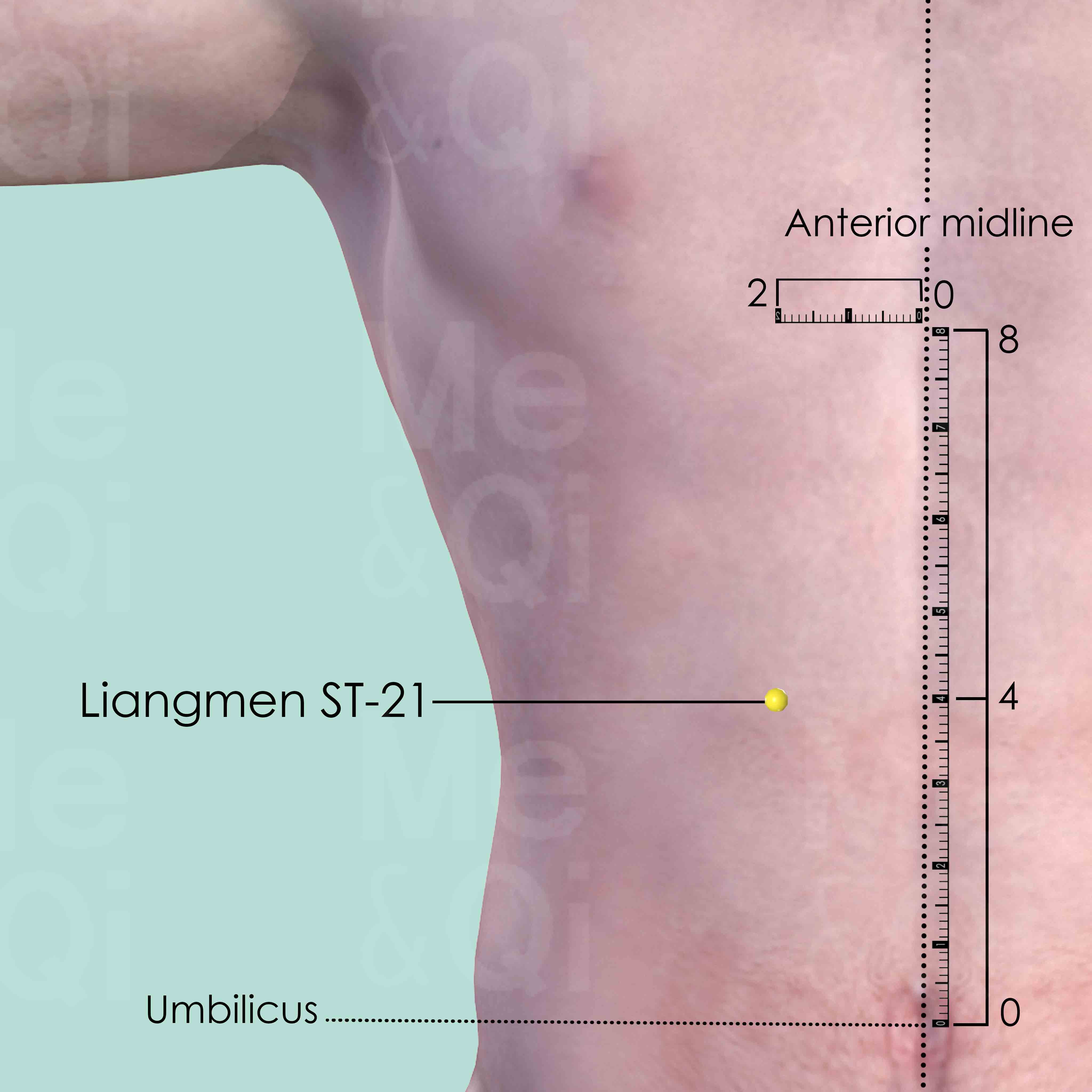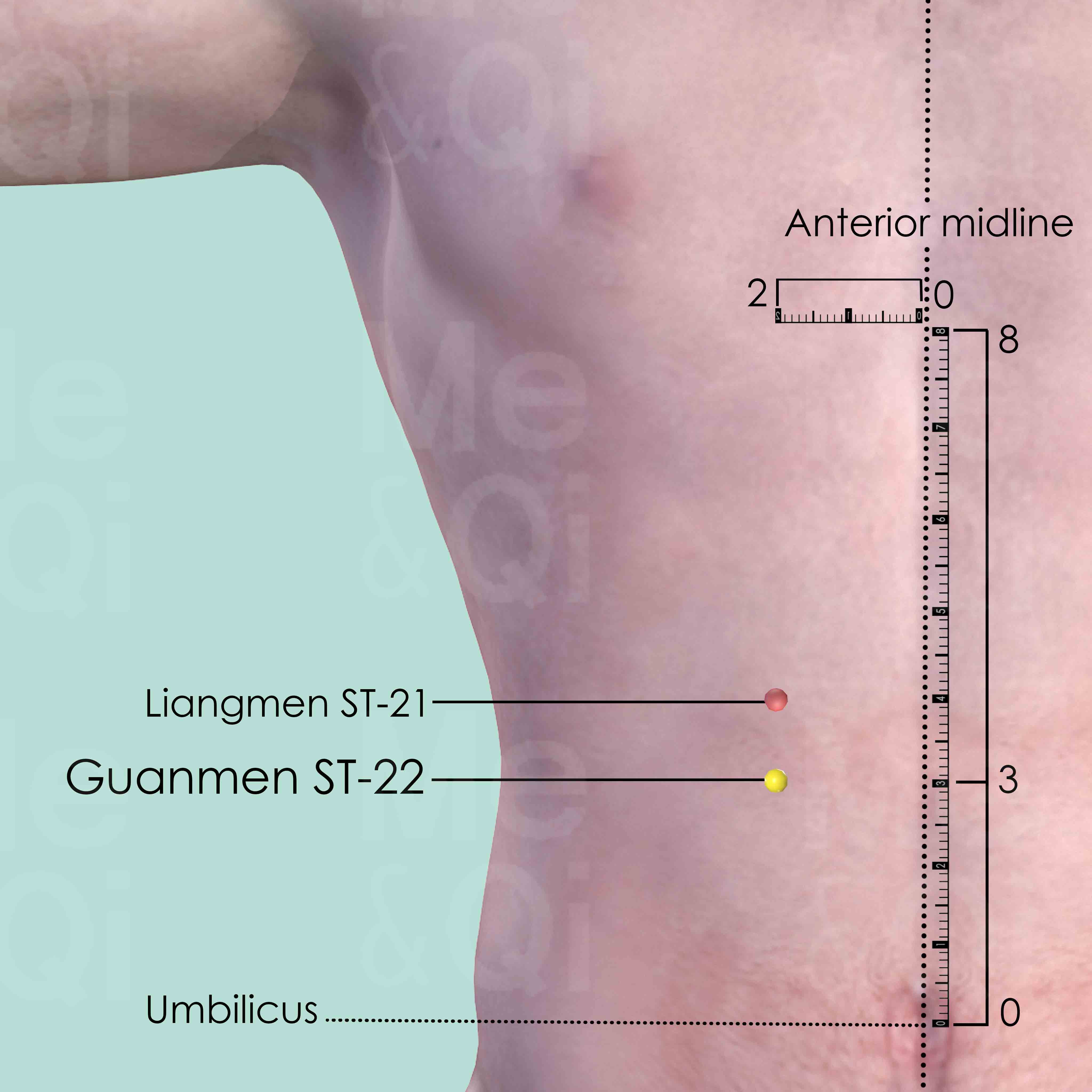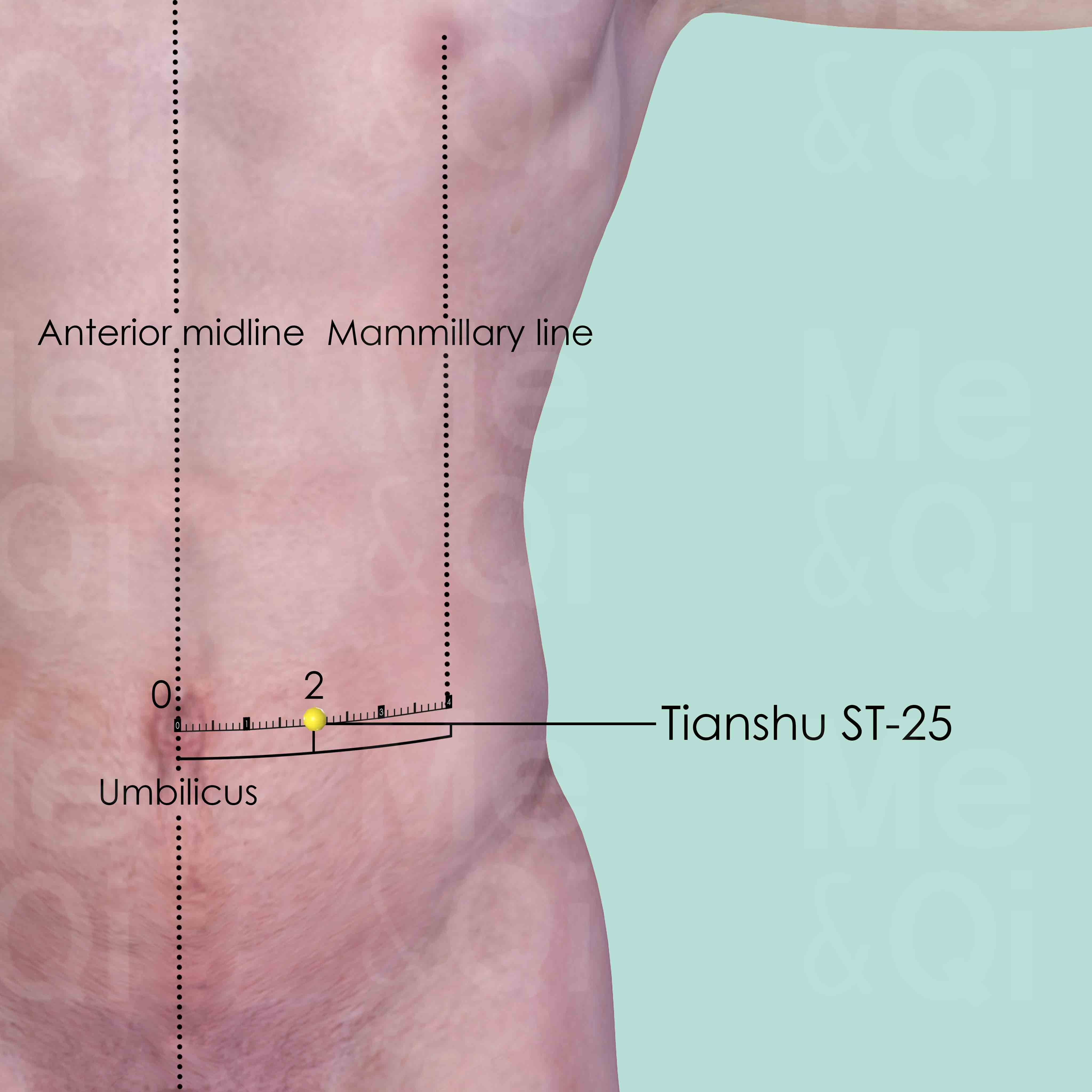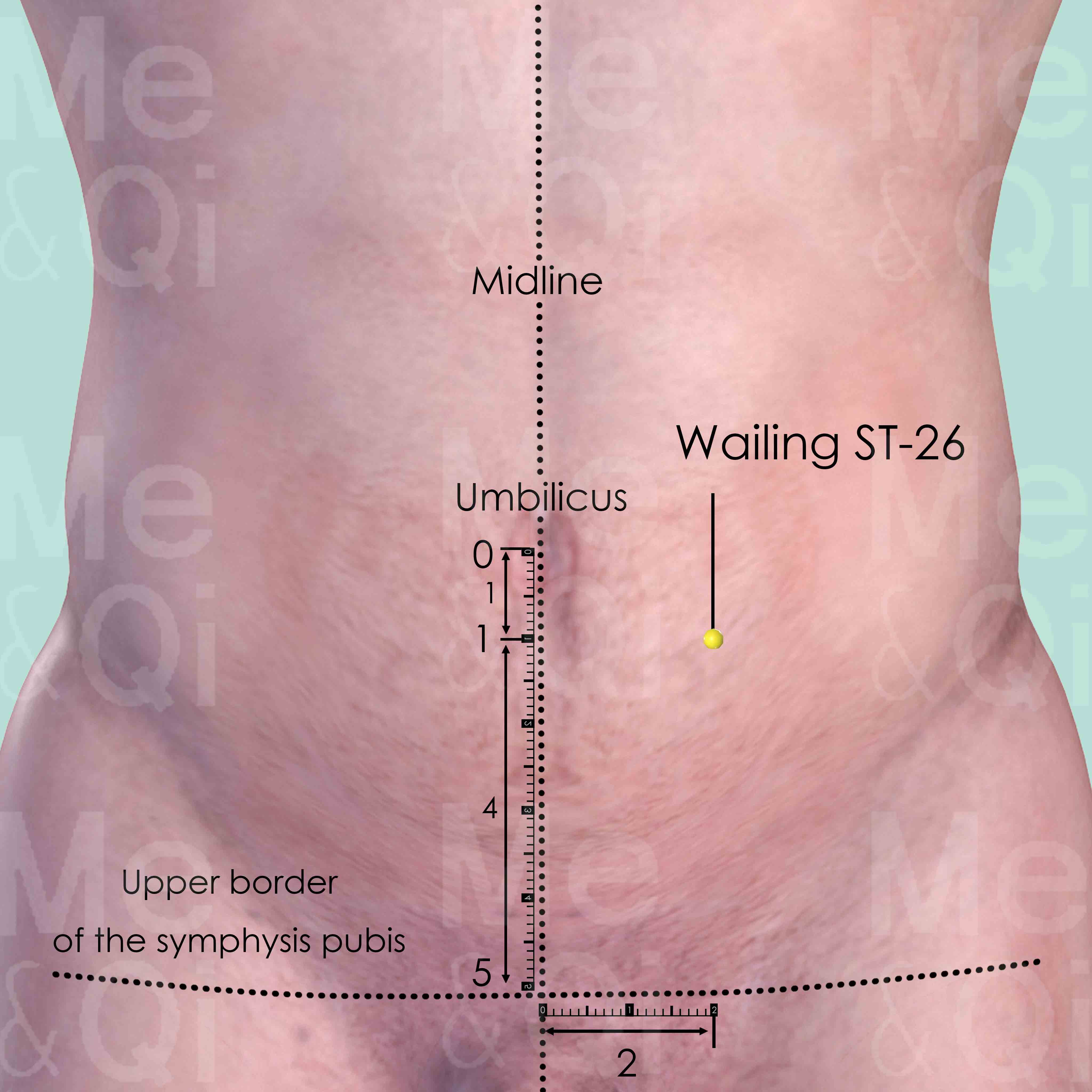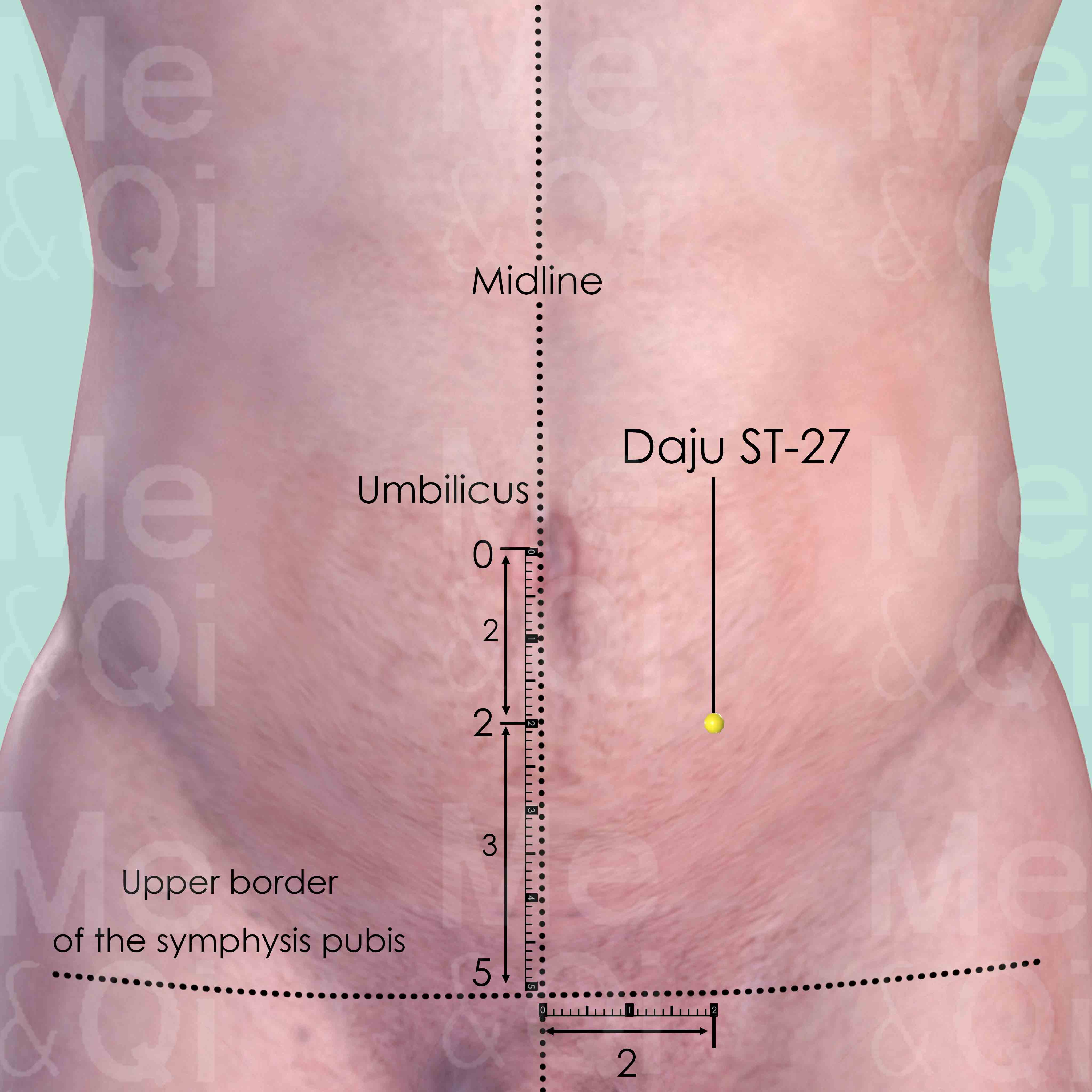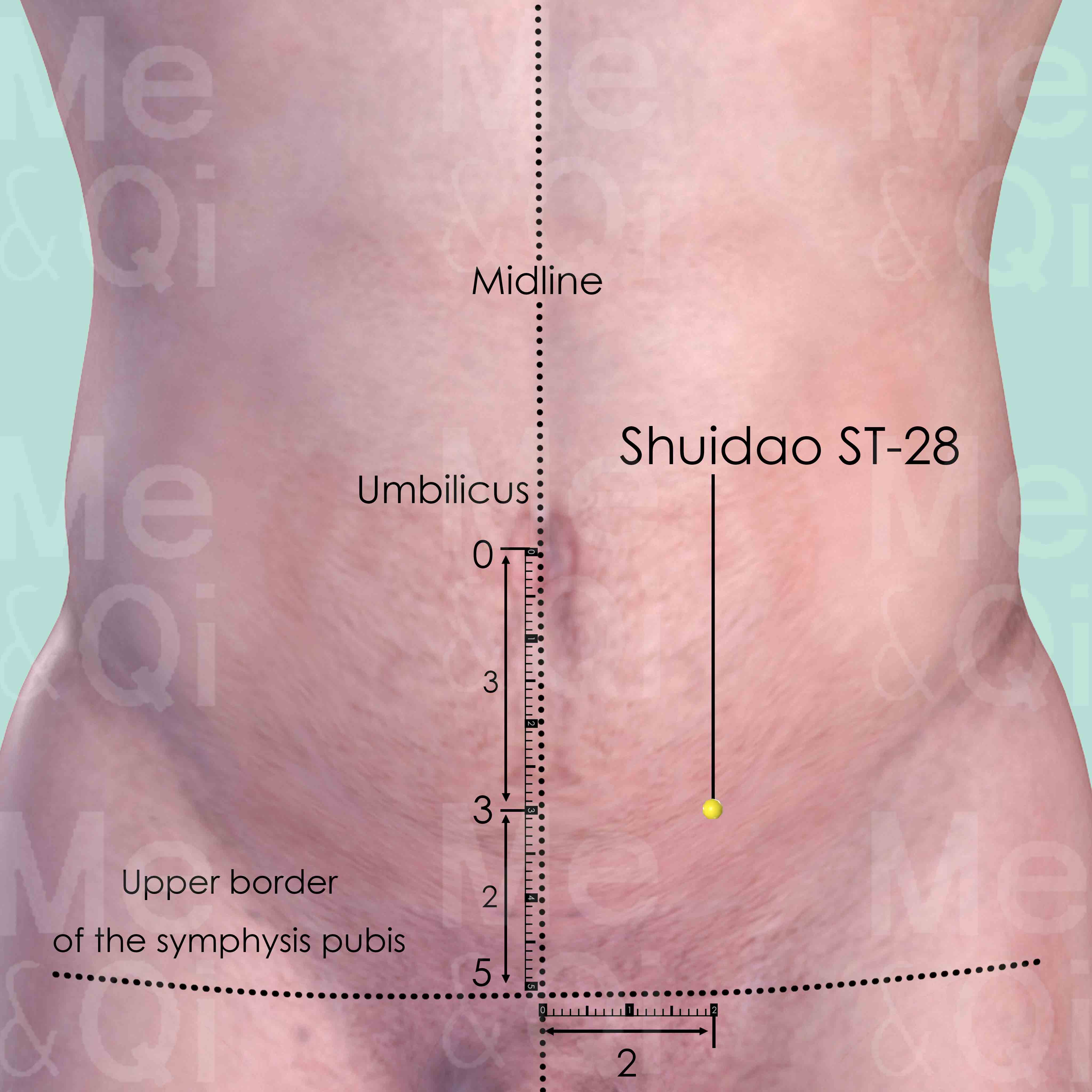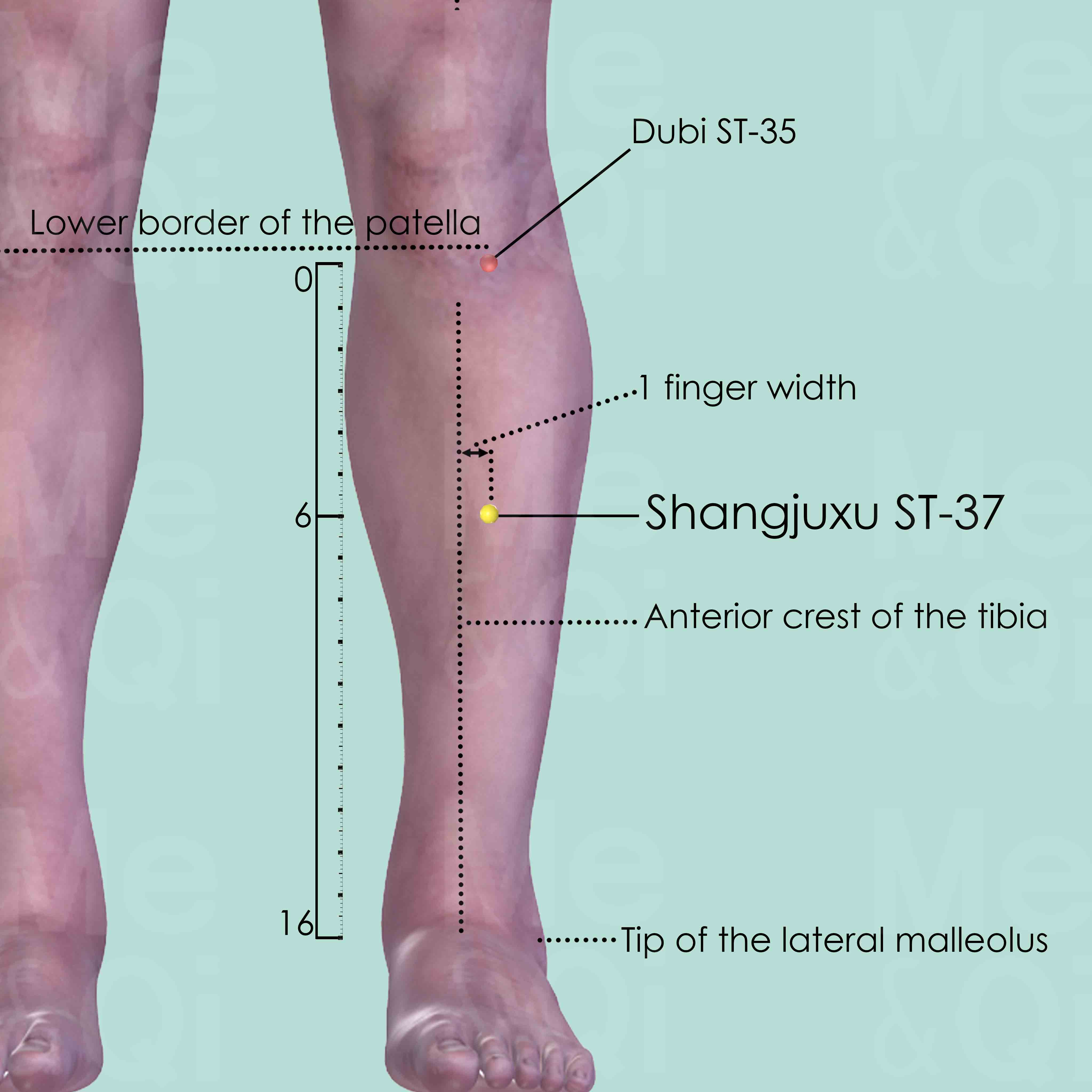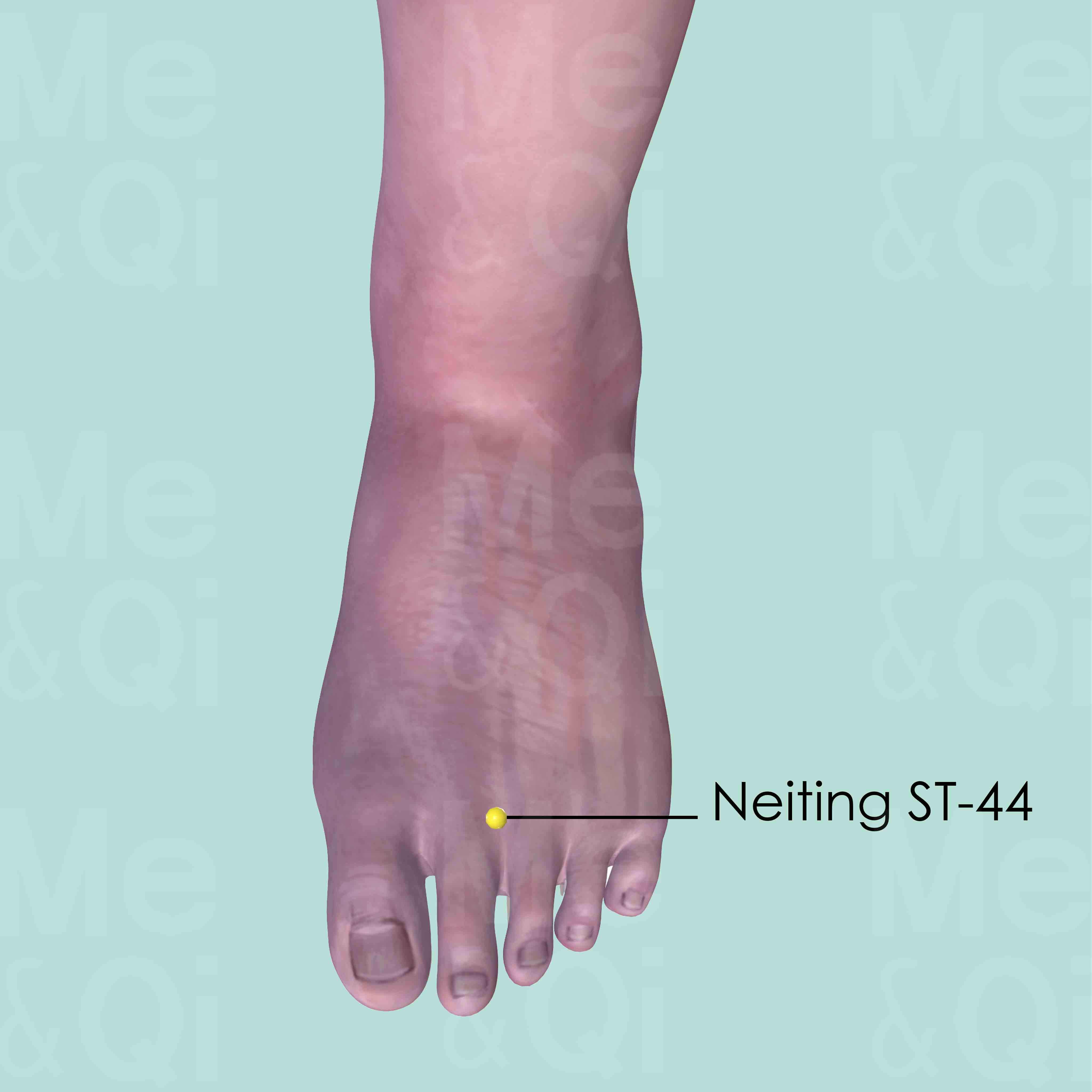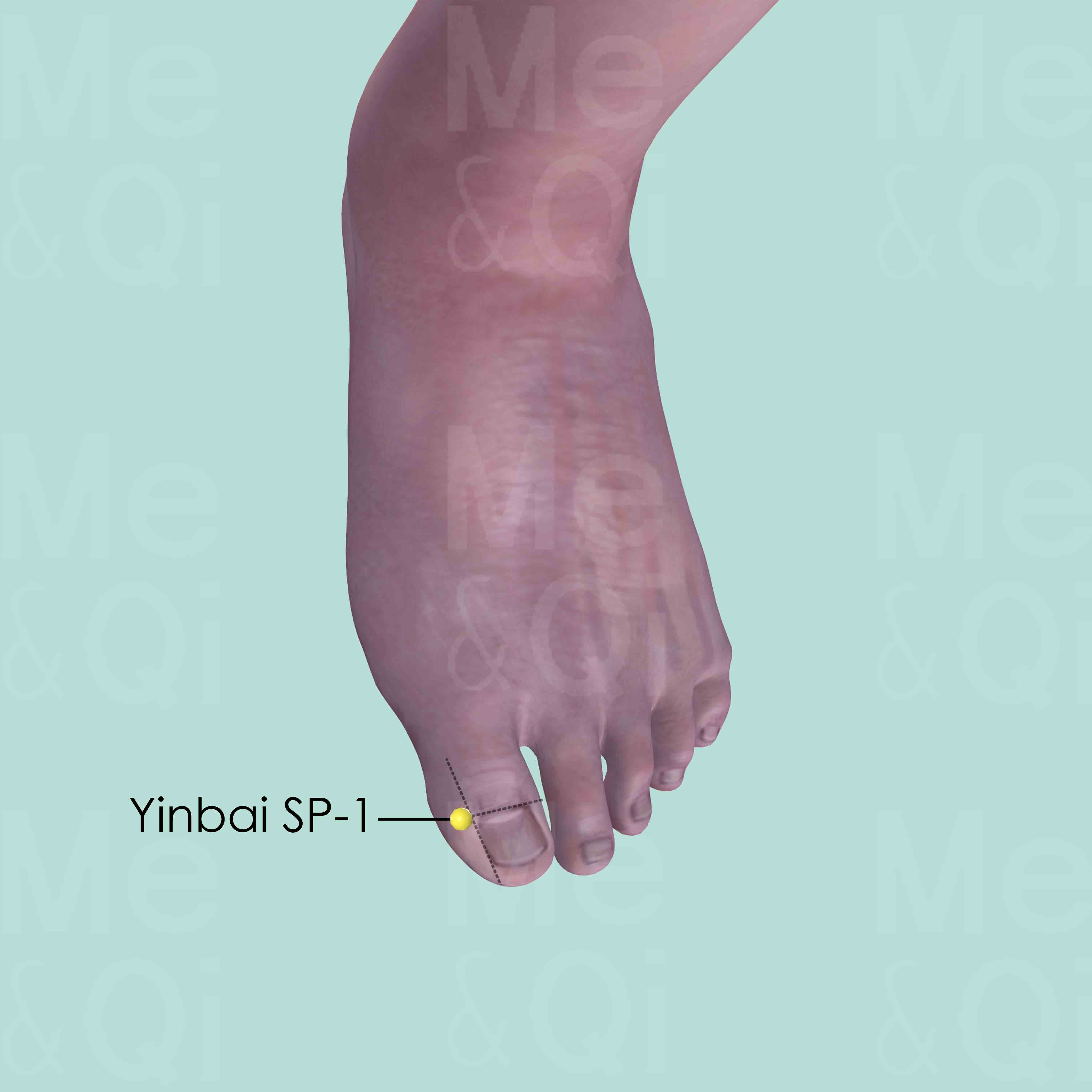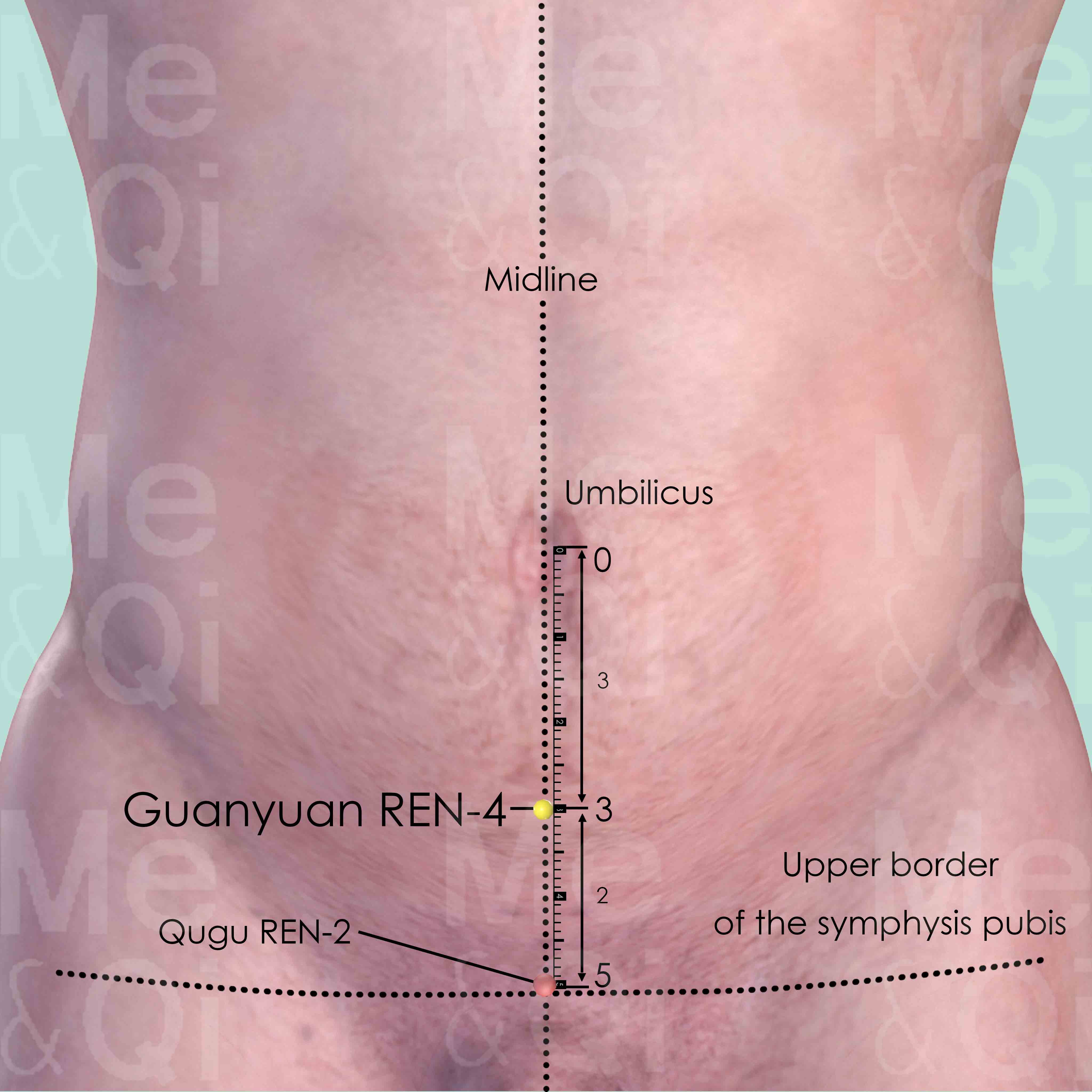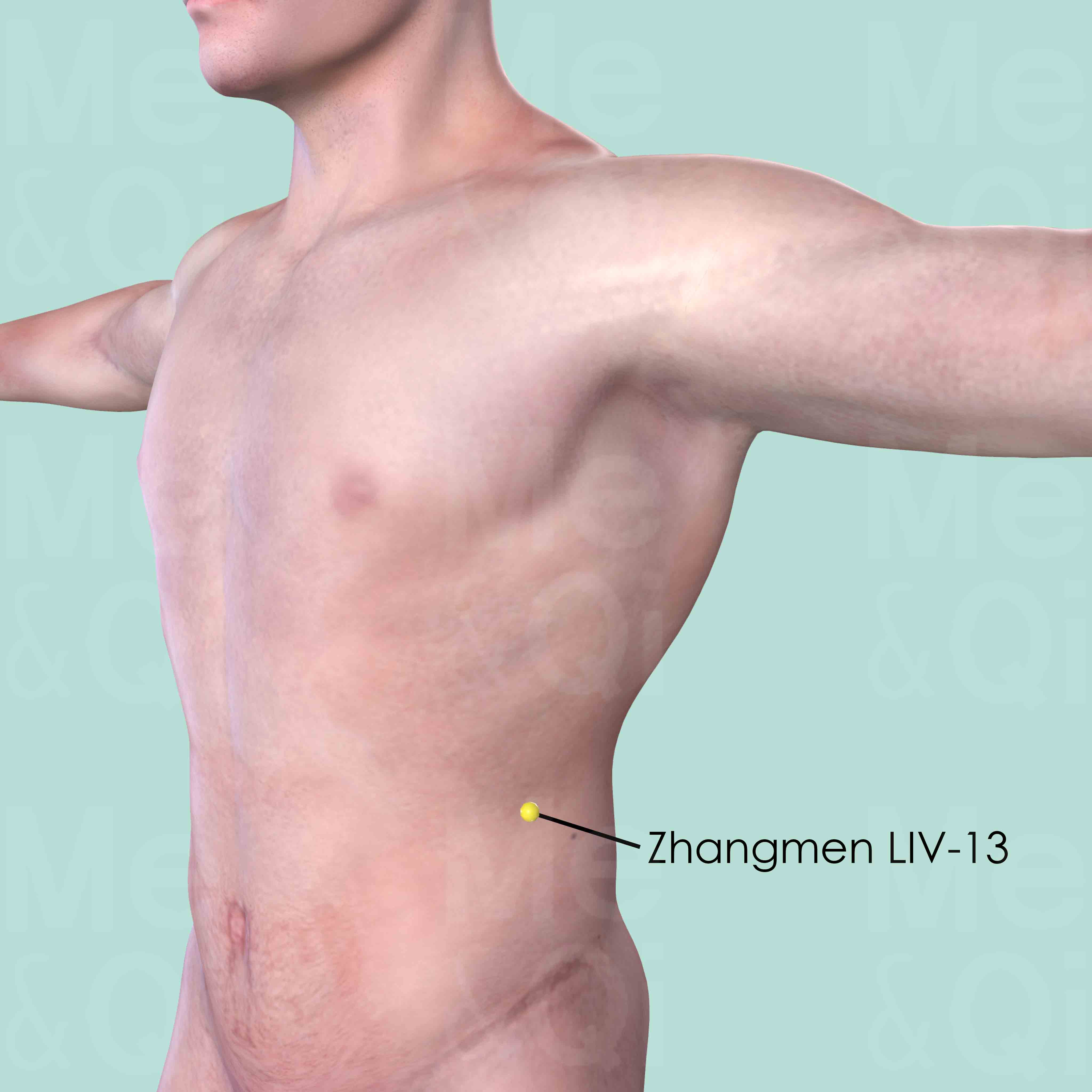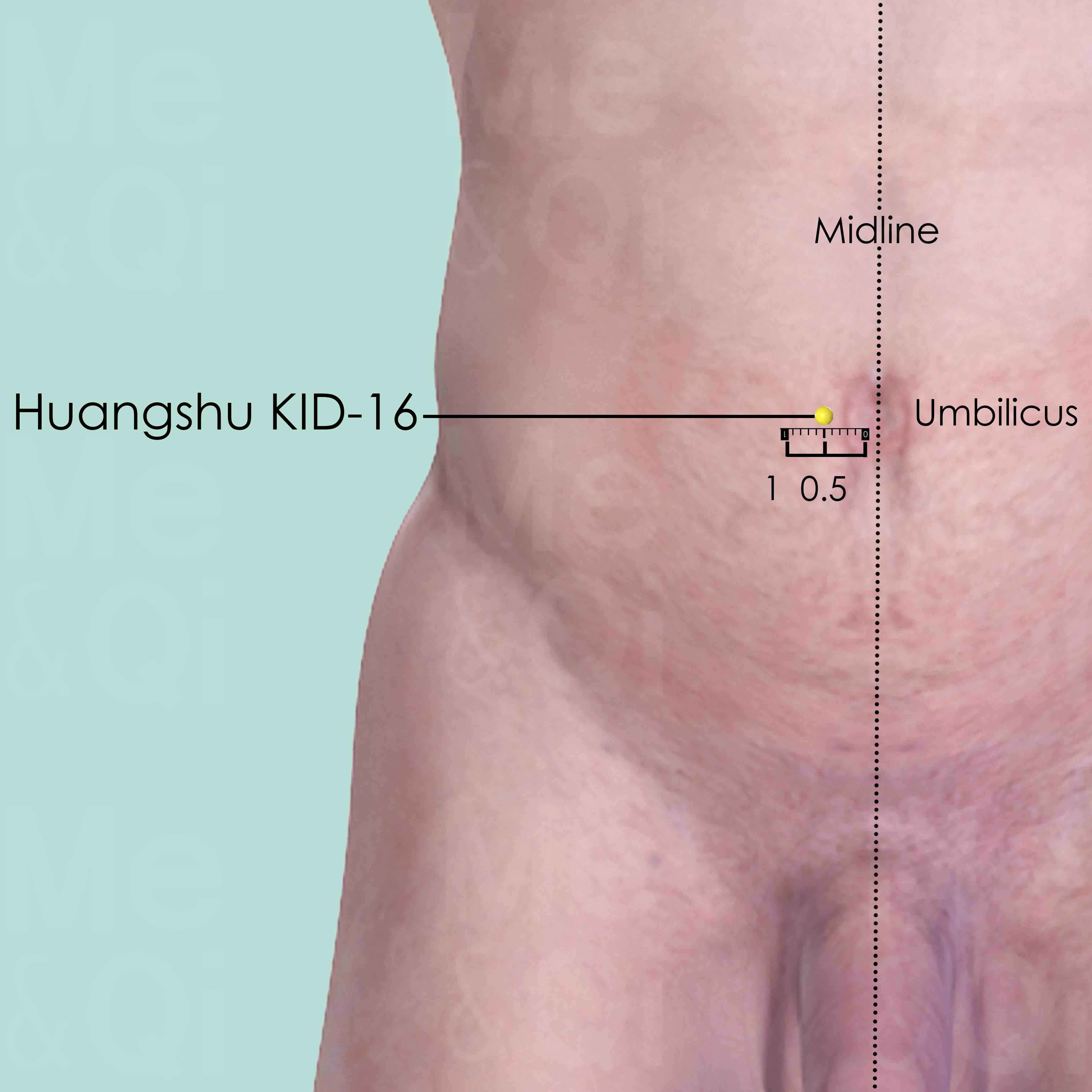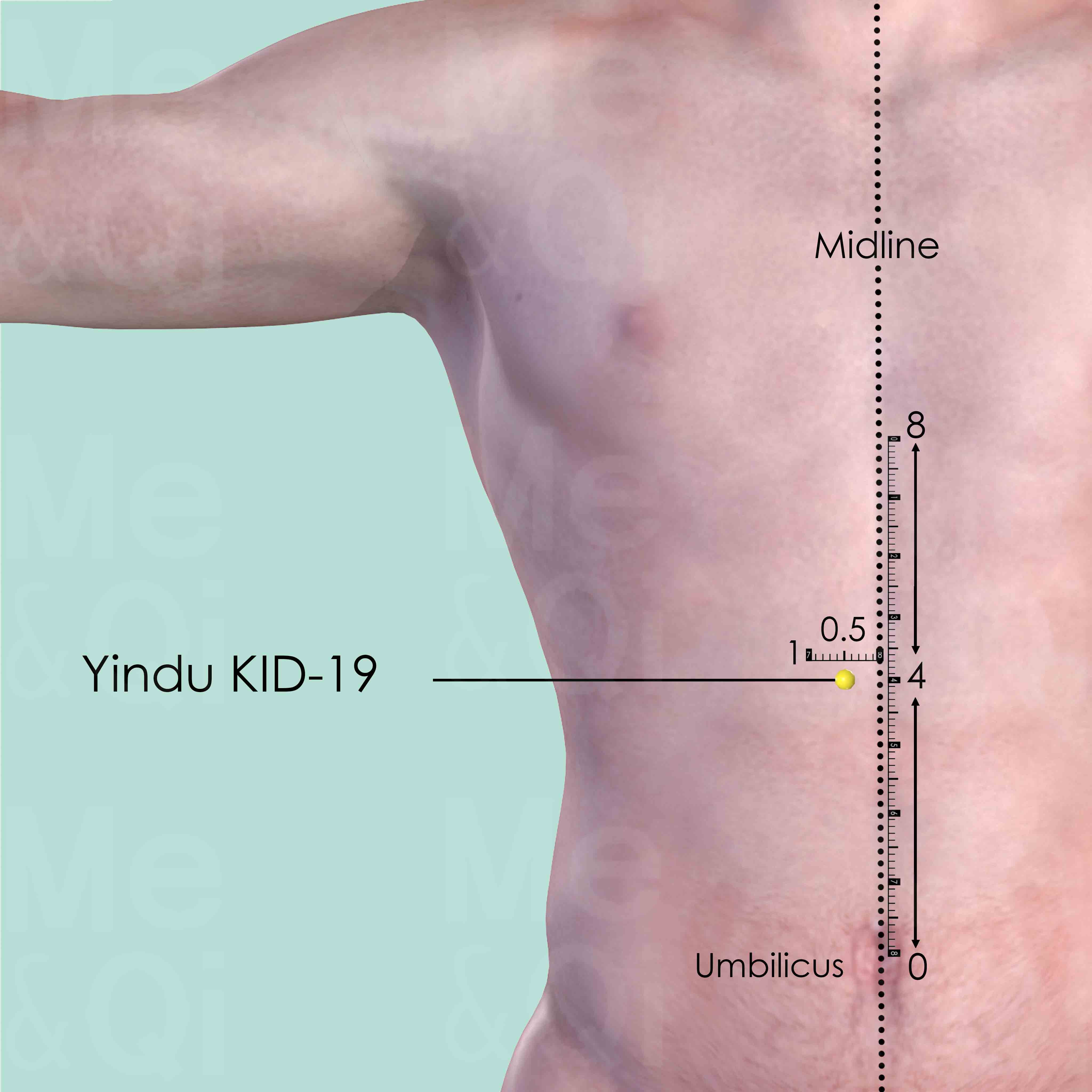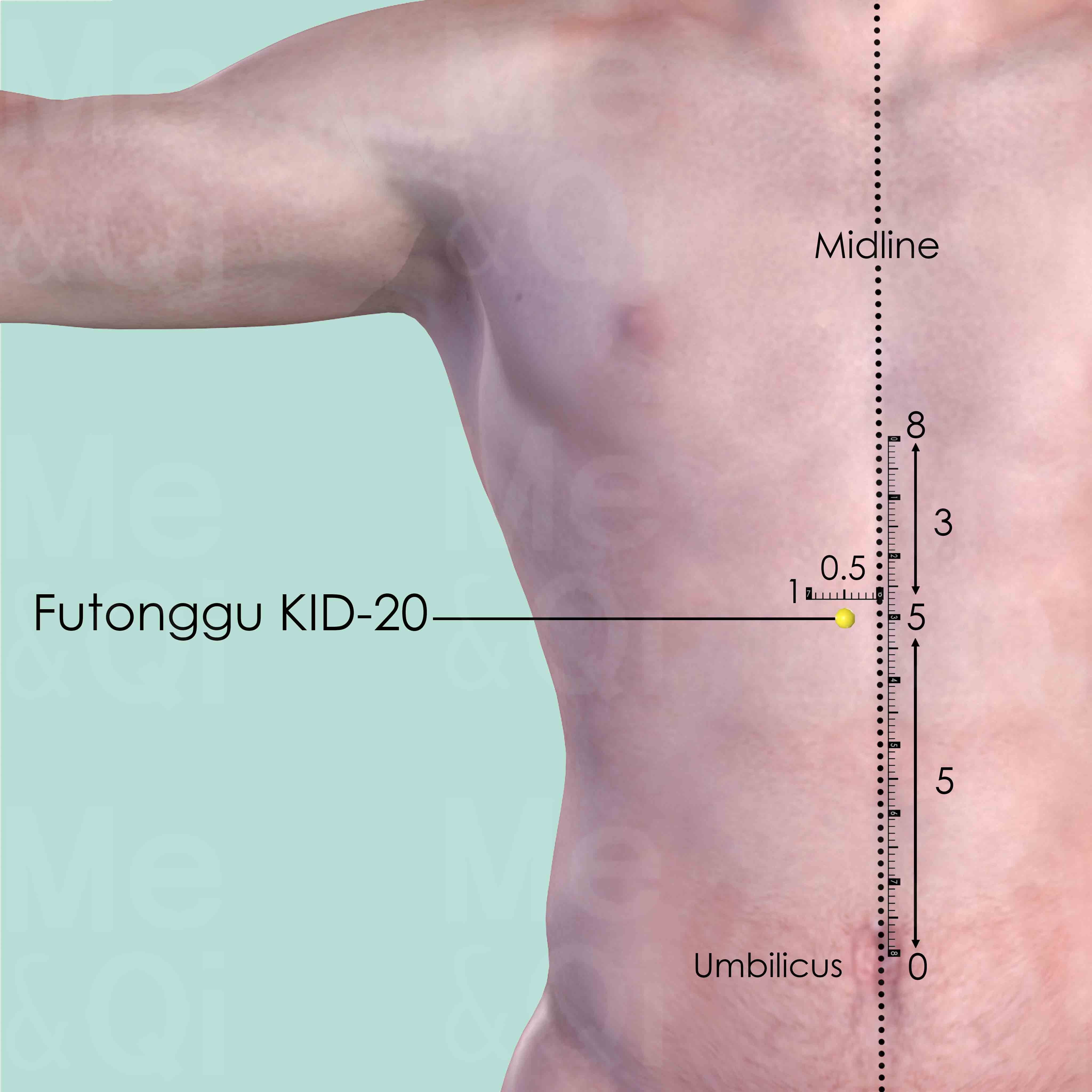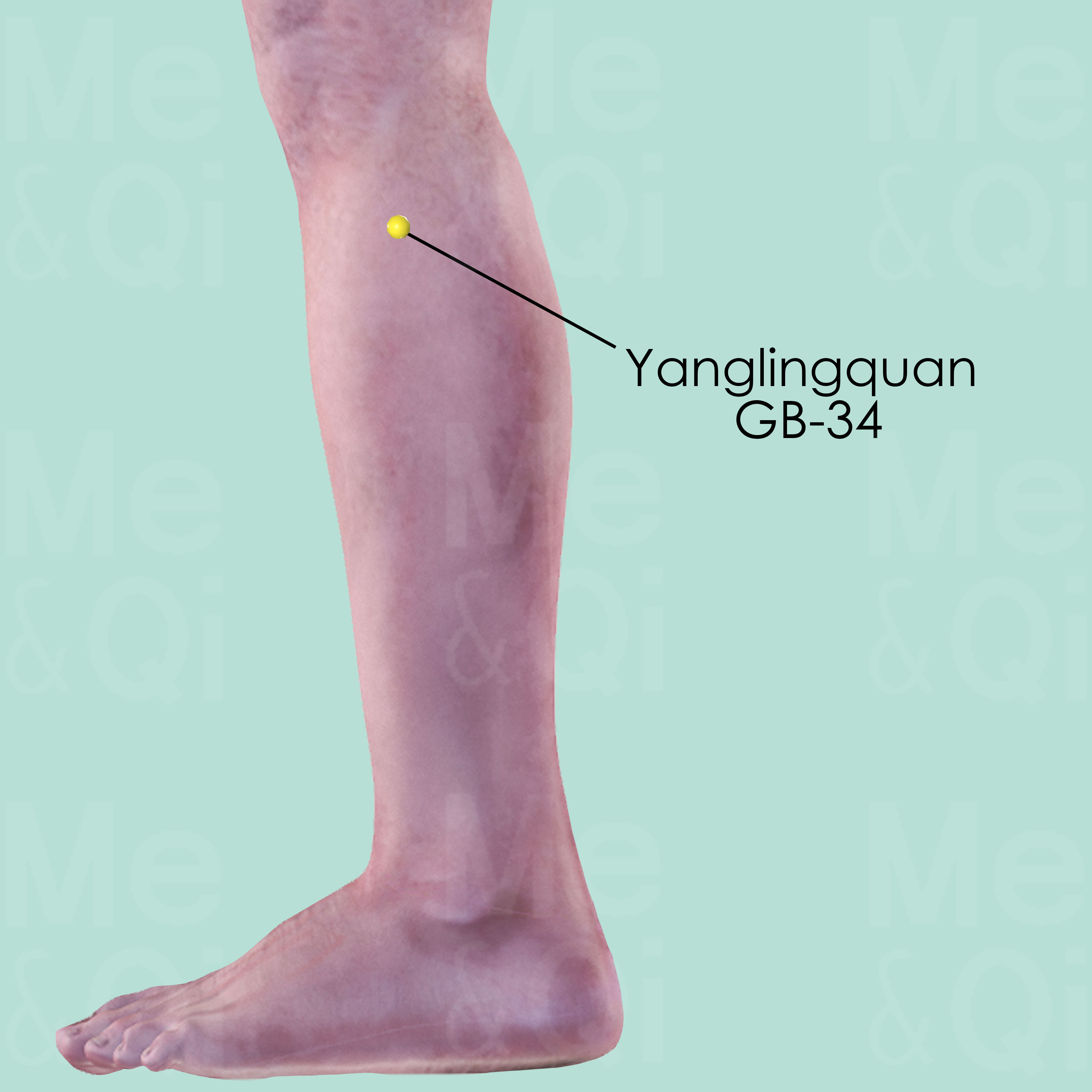Abdominal Distentionaccording to TCM
Symptom family: Abdominal Distension and Fullness
Sub-symptom(s): Upper Abdominal Fullness Lower Abdominal Distension Slight Abdominal Distention Upper Abdominal Distension
What is Abdominal Distention?
Abdominal distention refers to the sensation of increased pressure within the abdomen, leading to a noticeable enlargement or bloating of the stomach area. This condition can cause discomfort, fullness, and sometimes pain, affecting daily activities and overall well-being.
Abdominal distention encompasses a range of sensations, from slight bloating to severe swelling, and can be associated with various digestive and systemic health issues.
How Does TCM View Abdominal Distention?
Traditional Chinese Medicine (TCM) approaches abdominal distention not as a single symptom but as a sign of underlying disharmony within the body’s energy system. TCM practitioners believe that distention arises from imbalances such as Qi stagnation, Phlegm accumulation, Blood Stgantion, Qi Deficiency, and Yang Deficiency, each affecting the body's internal organs differently.
Identifying the specific pattern of disharmony is crucial for effective treatment in TCM, aiming to restore balance and alleviate the symptom.
Root Causes of Abdominal Distention in TCM
TCM identifies several key patterns that can lead to abdominal distention. Qi Stagnation, particularly in the Liver, can cause the abdomen to distend, often accompanied by mood swings and discomfort that fluctuates with emotional states.
Similarly, Phlegm accumulation, resulting from improper diet or metabolic issues, can lead to a sense of fullness and visible swelling. Blood Stagnation, marked by fixed pain and possibly dark, clotted menstrual blood in women, can also manifest as abdominal distention.
Additionally, Qi and Yang Deficiencies—reflecting a lack of vital energy or warmth—can lead to a bloated abdomen, often accompanied by coldness and fatigue.
Explore below more details about what might cause Abdominal distention according to TCM.
- By Syndrome
- By Organ
- Qi Stagnation
- Heat
- Dampness
- Blood Stasis
- Phlegm
- Qi Rebellion
- Yang Deficiency
- Qi Deficiency
- Cold
- Blood Deficiency
- Yin Excess
- View More Causes
- Liver
- Stomach
- Spleen
- Kidney
- Small Intestine
- Gallbladder
- Large Intestine
- Pericardium
- Bladder
- View More Organs
Qi Stagnation
Qi Stagnation in TCM is like having a traffic jam in your body's energy system. Qi, the vital life force that flows through your body, is supposed to move smoothly to maintain health and balance. But with Qi Stagnation, this flow gets blocked or slowed down, like cars stuck on a highway. This can lead to symptoms like feeling stressed, emotional mood swings, and physical discomfort, often described as a feeling of fullness or tightness, especially in the chest or abdomen. It's as though the body's internal energy circulation is disrupted, causing various issues. TCM sees this as an energy flow problem, different from modern medicine's focus on specific physiological processes.... see more
Qi Stagnation Patterns That Can Lead to Abdominal Distention
Common Symptoms: Irritability Upper Abdominal Distension Depression Irregular Periods Abdominal Pain Lack Of Appetite Hypochondriac Distention Mood Swings
| Pattern Name | Relevant Symptoms | Relevant Formulas |
|---|---|---|
| Liver Qi Stagnation | Abdomen distension, Abdominal distension, Abdominal distention and fullness, Epigastric distension, Epigastrium distension, Hypochondriac distention, Chest distension, Upper abdominal distension, Abdominal distention, Sighing, Melancholia, Depression, Mood swings, Irregular periods, Globus sensation, Pre menstrual breast distension, Pre menstrual tension, Anxiety, Anger... see more | Xiao Yao San | Jia Wei Xiao Yao San | Yue Ju Wan | Chai Hu Shu Gan San | Yi Guan Jian | Wu Yao Tang | Xia Ru Yong Quan San |
| Large Intestine Qi Stagnation | Abdominal distension, Abdominal distention, Abdominal pain, Constipation, Anxiety, Bitty stools | Chai Hu Shu Gan San |
| Qi And Blood Stagnation | Abdominal distension, Abdominal distention and fullness, Chest distension, Chest pain, Stabbing fixed pain, Dark face, Purple lips, Purple nails, Irritability, Mood swings, Depression, Mottled skin, Foot edema, Abdominal masses, Melena black tarry stool, Menstrual cramps, Amenorrhea, Dark menstrual clots, Dark menstrual blood, Prolonged lochia, Irregular periods... see more | Si Wu Tang | Xiao Yao San | Jin Ling Zi San | Tao Hong Si Wu Tang | Ge Xia Zhu Yu Tang | Wen Jing Tang | Gui Zhi Fu Ling Wan |
| Small Intestine Qi Pain | Abdominal distension, Lower abdominal twisting pain, Abdominal distention, Abdominal pain worsened by pressure, Borborygmi, Excessive gas and flatulence, Abdominal pain relieved by flatulence, Testicular pain... see more | Chai Hu Shu Gan San |
| Obstruction Of the Spleen By Dampness with Liver Qi Stagnation | Feeling of oppression and fullness of the epigastrium, Epigastric distension, Upper abdominal oppression, Nausea, Lack of appetite, Diarrhea, Feeling of heaviness, Dry mouth without desire to drink, Dull shallow face, Irritability, Upper abdominal distension, Hypochondriac distention, Hypochondriac pain... see more | Ping Wei San | Dang Gui Shao Yao San |
| Stagnant Liver Qi turning into Fire | Epigastric distension, Hypochondriac distention, Upper abdominal distension, Feeling of oppression of the chest, Irritability, Melancholia, Depression, Mood swings, Globus sensation, Feeling hot, Flushed face, Thirst, Anger, Pre menstrual tension, Irregular periods, Pre menstrual breast distension, Excessive menstruation... see more | Dan Zhi Xiao Yao San |
| Stomach Qi Stagnation | Epigastric distension, Upper abdominal pain, Upper abdominal distension, Belching, Nausea, Vomit, Hiccups, Irritability... see more | Ban Xia Hou Pu Tang | Zuo Jin Wan |
| Blood and Qi Deficiency with Blood Stagnation | Abdominal distension, Lack of appetite, Weak limbs, Lower back pain, Abdominal distention, Irregular periods, Red and white vaginal discharge, Infertility... see more | Ba Zhen Yi Mu Tang |
| Liver Qi Stagnation invading the Stomach | Abdominal distension, Epigastric distension, Belching, Abdominal distention, Upper abdominal distension, Depression, Irritability, Dry mouth, Lack of appetite, Craving for sour foods, Dry throat, Acid reflux... see more | Ban Xia Hou Pu Tang | Zuo Jin Wan |
Heat
In TCM "Heat" signifies an excess of Yang energy, leading to an imbalance where heat predominates over the body's cool Yin aspects. This condition is metaphorically akin to an internal over-heating. Symptoms indicative of Heat can include feelings of warmth, fever, sweating, irritability, red face, thirst with a preference for cold drinks, and a rapid pulse. The tongue may appear red with a yellow coating. Unlike the common interpretation of heat in terms of temperature, in TCM, it represents a state of hyperactivity or inflammation in the body.... see more
Heat Patterns That Can Lead to Abdominal Distention
Common Symptoms: Bitter Taste In The Mouth Feeling Hot Thirst Upper Abdominal Fullness Nausea Irritability Feeling Of Heaviness Dry Mouth Without Desire To Drink
| Pattern Name | Relevant Symptoms | Relevant Formulas |
|---|---|---|
| Heat in the Blood | Abdominal distention and fullness, Feeling hot, Red skin eruptions, Thirst, Frequent bleeding, Bloody sputum, Hematochezia, Hematuria, Vomiting blood, Hemoptysis, Nosebleeds, Excessive menstruation... see more | Xi Jiao Di Huang Tang |
| Damp-Heat invading the Spleen | Abdominal and epigastric fullness, Lack of appetite, Feeling of heaviness, Dry mouth without desire to drink, Nausea or vomiting, Malodorous diarrhea, Anal burning, Feeling hot, Scanty and dark urine, Low grade fever, Dull headache, Dull yellow complexion, Yellow sclera, Oily sweat, Itchy rashes, Bitter taste in the mouth, Upper abdominal fullness, Upper abdominal pain... see more | Lian Po Yin |
| Damp-Heat in the Stomach | Epigastrium fullness, Upper abdominal pain, Upper abdominal fullness, Feeling of heaviness, Face pain, Congested nose, Thick nasal discharge, Dry mouth without desire to drink, Nausea, Feeling hot, Dull yellow complexion, Sticky taste in the mouth... see more | Lian Po Yin | Ge Hua Jie Cheng San |
| Gallbladder Heat | Epigastrium fullness, Alternating sensation of hot and cold, Bitter taste in the mouth, Thirst, Dry throat, Hypochondriac pain, Nausea, Upper abdominal fullness... see more | Hao Qin Qing Dan Tang |
| Obstruction Of the Spleen By Dampness with Liver Qi Stagnation | Feeling of oppression and fullness of the epigastrium, Epigastric distension, Upper abdominal oppression, Nausea, Lack of appetite, Diarrhea, Feeling of heaviness, Dry mouth without desire to drink, Dull shallow face, Irritability, Upper abdominal distension, Hypochondriac distention, Hypochondriac pain... see more | Ping Wei San | Dang Gui Shao Yao San |
| Greater Yang Accumulation of Blood | Hypogastric distention, Lower abdominal distension, Lower abdominal fullness, Hematuria, Restlessness | Tao He Cheng Qi Tang |
| Stagnant Liver Qi turning into Fire | Epigastric distension, Hypochondriac distention, Upper abdominal distension, Feeling of oppression of the chest, Irritability, Melancholia, Depression, Mood swings, Globus sensation, Feeling hot, Flushed face, Thirst, Anger, Pre menstrual tension, Irregular periods, Pre menstrual breast distension, Excessive menstruation... see more | Dan Zhi Xiao Yao San |
| Heat in Gall Bladder | Epigastrium fullness, Mild chills with high fever, Bitter taste in the mouth, Stifling sensation in the chest, Vomiting of sour fluids, Thirst, Hypochondriac pain and discomfort, Nausea, Upper abdominal fullness, Cholecystitis, Icteric hepatitis... see more | Hao Qin Qing Dan Tang |
Dampness
"Dampness" in TCM is a concept that describes a pattern of disharmony where the body accumulates excess moisture. Imagine the heavy, sticky feeling you get on a very humid day; that's similar to what dampness feels like internally. It can manifest as a sense of heaviness, bloating, sluggishness, or even a foggy mind. This condition is often thought to arise from environmental factors like living in a damp place, dietary habits that promote moisture in the body, or internal imbalances that hinder the body's ability to process fluids properly. In TCM, dampness can obstruct the normal flow of energy and fluids in the body, leading to various symptoms.... see more
Dampness Patterns That Can Lead to Abdominal Distention
Common Symptoms: Lack Of Appetite Feeling Of Heaviness Diarrhea Nausea Upper Abdominal Fullness Dry Mouth Without Desire To Drink Generalized Fatigue Shortness Of Breath
| Pattern Name | Relevant Symptoms | Relevant Formulas |
|---|---|---|
| Oedema | Abdomen distension, Abdominal edema, Ankle edema, Facial edema, Foot edema, Oedema of hands, Leg edema, Ocular swelling, Abdominal distention... see more | Wu Ling San | Fang Ji Huang Qi Tang | Ping Wei San | Wu Pi Yin | Ling Gui Zhu Gan Tang | Zhen Wu Tang | Shen Qi Wan | Yu Gong San | Zhou Che Wan |
| Kidney Yang Deficiency with Water overflowing | Abdominal distention and fullness, Edema of the lower extremities, Cold sensation in legs and back, Abdominal distention, Lumbar pain, Chills, Scanty clear urination, Palpitations, Shortness of breath, Cold hands, White and watery sputum, Coughing, Asthma... see more | Wu Ling San | Ji Sheng Shen Qi Wan |
| Cold-Damp invading the Spleen | Abdominal and epigastric fullness, Lack of appetite, Epigastric coldness, Head and body heaviness, Sweet taste in mouth, Absence of thirst, Diarrhea, General weakness, Generalized fatigue, Nausea, Edema, Dull pale complexion, White vaginal discharge, Upper abdominal fullness... see more | Ping Wei San |
| Damp-Heat invading the Spleen | Abdominal and epigastric fullness, Lack of appetite, Feeling of heaviness, Dry mouth without desire to drink, Nausea or vomiting, Malodorous diarrhea, Anal burning, Feeling hot, Scanty and dark urine, Low grade fever, Dull headache, Dull yellow complexion, Yellow sclera, Oily sweat, Itchy rashes, Bitter taste in the mouth, Upper abdominal fullness, Upper abdominal pain... see more | Lian Po Yin |
| Damp-Heat in the Stomach | Epigastrium fullness, Upper abdominal pain, Upper abdominal fullness, Feeling of heaviness, Face pain, Congested nose, Thick nasal discharge, Dry mouth without desire to drink, Nausea, Feeling hot, Dull yellow complexion, Sticky taste in the mouth... see more | Lian Po Yin | Ge Hua Jie Cheng San |
| Obstruction Of the Spleen By Dampness with Liver Qi Stagnation | Feeling of oppression and fullness of the epigastrium, Epigastric distension, Upper abdominal oppression, Nausea, Lack of appetite, Diarrhea, Feeling of heaviness, Dry mouth without desire to drink, Dull shallow face, Irritability, Upper abdominal distension, Hypochondriac distention, Hypochondriac pain... see more | Ping Wei San | Dang Gui Shao Yao San |
Blood Stasis
Blood Stasis in TCM is a concept where the blood flow in the body is not as smooth or efficient as it should be. Imagine a river that's supposed to flow freely, but instead, it's getting blocked or moving too slowly in some parts. This can lead to various health issues, like pain that feels sharp or stabbing, dark bruises, and a complexion that looks purplish. TCM believes that good health relies on the smooth and vibrant flow of Qi and blood throughout the body, so when blood gets stuck, it's like a traffic jam in your body, leading to discomfort or health problems.... see more
Blood Stasis Patterns That Can Lead to Abdominal Distention
Common Symptoms: Irregular Periods Abdominal Masses Menstrual Cramps Dark Menstrual Clots Lower Back Pain Stabbing Fixed Pain Dark Face Purple Lips
| Pattern Name | Relevant Symptoms | Relevant Formulas |
|---|---|---|
| Qi And Blood Stagnation | Abdominal distension, Abdominal distention and fullness, Chest distension, Chest pain, Stabbing fixed pain, Dark face, Purple lips, Purple nails, Irritability, Mood swings, Depression, Mottled skin, Foot edema, Abdominal masses, Melena black tarry stool, Menstrual cramps, Amenorrhea, Dark menstrual clots, Dark menstrual blood, Prolonged lochia, Irregular periods... see more | Si Wu Tang | Xiao Yao San | Jin Ling Zi San | Tao Hong Si Wu Tang | Ge Xia Zhu Yu Tang | Wen Jing Tang | Gui Zhi Fu Ling Wan |
| Blood Stagnation | Abdominal distention and fullness, Dark face, Purple lips, Stabbing fixed pain, Abdominal masses, Purple nails, Menstrual cramps, Dark menstrual clots, Dark menstrual blood, Lumps... see more | Tao Hong Si Wu Tang | Shi Xiao San | Ge Xia Zhu Yu Tang | Shao Fu Zhu Yu Tang |
| Blood and Qi Deficiency with Blood Stagnation | Abdominal distension, Lack of appetite, Weak limbs, Lower back pain, Abdominal distention, Irregular periods, Red and white vaginal discharge, Infertility... see more | Ba Zhen Yi Mu Tang |
| Blood Stagnation in the Lower Burner caused by Cold | Lower abdominal distension, Abdominal masses, Lower abdominal pain, Lower back pain, Abnormal uterine bleeding, Menstrual cramps, Dark menstrual clots... see more | Shao Fu Zhu Yu Tang |
Phlegm
In TCM "Phlegm" as a pattern of disharmony is a complex concept that extends beyond the physical manifestation of mucus. It represents a pathological factor that can disrupt the flow of Qi (vital energy) and blood, leading to various health issues. Phlegm in TCM is seen as a sticky, turbid substance arising from the body's inability to metabolize fluids properly, often due to a dysfunction of the spleen. It's not only associated with respiratory problems like cough and congestion but also with systemic issues. Symptoms can include a feeling of heaviness, mental cloudiness, dizziness, and in some cases, the formation of lumps or masses. Phlegm can even be "invisible," contributing to emotional disturbances like depression or stress. ... see more
Phlegm Patterns That Can Lead to Abdominal Distention
Common Symptoms: Diarrhea Feeling Of Heaviness Shortness Of Breath Vomiting Clear Liquid Chest Distension Abdominal Edema Ankle Edema Facial Edema
| Pattern Name | Relevant Symptoms | Relevant Formulas |
|---|---|---|
| Oedema | Abdomen distension, Abdominal edema, Ankle edema, Facial edema, Foot edema, Oedema of hands, Leg edema, Ocular swelling, Abdominal distention... see more | Wu Ling San | Fang Ji Huang Qi Tang | Ping Wei San | Wu Pi Yin | Ling Gui Zhu Gan Tang | Zhen Wu Tang | Shen Qi Wan | Yu Gong San | Zhou Che Wan |
| Phlegm-Fluids | Abdominal distention and fullness, Abdominal distention, Vomiting clear liquid, Feeling of heaviness, Shortness of breath, Hypochondrial pain that is worse on coughing and breathing, Coughing, Lack of sweating, Absence of thirst, Edema, Chest distension... see more | Wu Ling San | Ling Gui Zhu Gan Tang | Er Chen Tang | Wen Dan Tang |
| Phlegm-Fluids in the Stomach and Small intestine | Abdominal distention and fullness, Abdominal distention, Vomiting clear liquid, Dry tongue, Dry mouth without desire to drink, Stomach splashing sound, Chest distension, Diarrhea, Weight loss... see more | Ling Gui Zhu Gan Tang | Xiao Chai Hu Tang | Ban Xia Xie Xin Tang | Xuan Fu Dai Zhe Tang |
Qi Rebellion
Rebellious Qi in TCM is a bit like having a rebel inside your body. Qi, which is the vital energy flowing through your body, is supposed to move in certain directions to keep everything in balance and working well. But with Rebellious Qi, this energy decides to go the opposite way. Think of it like a river flowing upstream instead of downstream. This can cause various issues like heartburn, coughing, or even headaches. It's as if the body's natural flow is disrupted, creating a kind of internal chaos. TCM focuses on correcting this flow, restoring order and balance.... see more
Qi Rebellion Patterns That Can Lead to Abdominal Distention
Common Symptoms: Irritability Hypochondriac Distention Upper Abdominal Distension Hiccups Sighing Nausea Or Vomiting Belching Abdominal Pain
| Pattern Name | Relevant Symptoms | Relevant Formulas |
|---|---|---|
| Rebellious Liver Qi invading the Spleen | Abdominal distension, Irritability, Abdominal distention, Abdominal pain, Alternating diarrhea and constipation, Dry stools, Excessive gas and flatulence, Generalized fatigue... see more | Xiao Yao San | Tong Xie Yao Fang |
| Rebellious Liver Qi | Epigastric distension, Hypochondriac distention, Upper abdominal distension, Hiccups, Sighing, Nausea or vomiting, Belching, Stomach churning, Irritability, Breast engorgement, Headaches, Dizziness... see more | Chai Hu Shu Gan San | Si Ni San |
| Rebellious Liver Qi invading the Stomach | Epigastric distension, Irritability, Upper abdominal pain, Upper abdominal distension, Hypochondriac pain, Hypochondriac distention, Upper abdominal oppression, Acid reflux, Hiccups, Belching, Nausea or vomiting, Sighing, Weak limbs... see more | Ban Xia Hou Pu Tang | Xuan Fu Dai Zhe Tang | Si Mo Tang | Ju Pi Zhu Ru Tang | Ding Xiang Shi Di Tang |
Yang Deficiency
Yang deficiency in TCM refers to a state where the body's Yang energy, which is responsible for warmth, activity, and function, is weakened or diminished. This pattern of disharmony often arises from chronic illness, aging, or inherent constitutional weakness. Symptoms of Yang deficiency are typically associated with cold and sluggishness, such as a feeling of coldness, cold extremities, pale complexion, low energy or fatigue, and a desire for warmth. Digestive issues like poor appetite, loose stools, and water retention can also be indicative of Yang deficiency.... see more
Yang Deficiency Patterns That Can Lead to Abdominal Distention
Common Symptoms: Chills Shortness Of Breath Diarrhea Edema Of The Lower Extremities Cold Sensation In Legs And Back Lumbar Pain Scanty Clear Urination Palpitations
| Pattern Name | Relevant Symptoms | Relevant Formulas |
|---|---|---|
| Kidney Yang Deficiency with Water overflowing | Abdominal distention and fullness, Edema of the lower extremities, Cold sensation in legs and back, Abdominal distention, Lumbar pain, Chills, Scanty clear urination, Palpitations, Shortness of breath, Cold hands, White and watery sputum, Coughing, Asthma... see more | Wu Ling San | Ji Sheng Shen Qi Wan |
| Kidney and Spleen Yang Deficiency | Slight abdominal distention, Lower back pain, Weak and cold knees, Back cold sensation, Chills, Weak legs, Bright pale face, Erectile dysfunction, Premature ejaculation, Oligospermia, Watery ejaculate, Low sex drive, Generalized fatigue, General weakness, Clear urination, Nocturia, Apathy, Leg edema, Female infertility, Diarrhea, Depression, Lack of appetite, Desire to lie down... see more | Li Zhong Wan |
| Spleen and Kidney Yang Deficiency | Abdominal distention and fullness, Pale face, Facial edema, Oedema of limbs, Abdominal distention, Cold extremities, Shortness of breath, Diarrhea, Frequent urination, Lupus... see more | Wu Ling San |
Qi Deficiency
Qi Deficiency in TCM is like running low on battery power. Qi is the vital energy that powers every function in your body. When there's a Qi Deficiency, it means your body doesn't have enough of this essential energy. This can make you feel tired all the time, weak, or even cause shortness of breath. It's similar to how you feel when you haven't had enough sleep or nutritious food. Your body just doesn't have the energy it needs to perform at its best. Unlike modern medicine, which often focuses on specific physical causes for fatigue and weakness, TCM views Qi Deficiency as an overall energy depletion that affects your entire well-being, and it seeks to replenish and balance this vital energy.... see more
Qi Deficiency Patterns That Can Lead to Abdominal Distention
Common Symptoms: Dizziness Blurry Vision Lack Of Appetite Generalized Fatigue Eye Floaters Nervousness Timidity Easily Startled
| Pattern Name | Relevant Symptoms | Relevant Formulas |
|---|---|---|
| Liver Qi Deficiency | Abdomen distension, Dizziness, Blurry vision, Eye floaters, Nervousness, Timidity, Easily startled, Lack of bravery, Indecision, Sighing, Vivid dreaming, Depression, Irritability, Hypochondriac distention, Irregular periods, Lack of appetite, Generalized fatigue, Abdominal distention... see more | Bu Zhong Yi Qi Tang | Si Wu Tang | Xiao Yao San |
| Spleen and Stomach Qi Deficiency | Abdominal distension, Dizziness, Unsteadiness, Blurry vision, Deafness, Tinnitus, Shortness of breath, Weak voice, Pale face, Lack of appetite, Diarrhea... see more | Xiang Sha Liu Jun Zi Tang |
Cold
In TCM "Cold" as a pattern of disharmony refers to a specific type of imbalance within the body's systems, often linked to a deficiency or weakness. It's not about feeling physically cold or having a common cold, but rather a metaphorical description of certain symptoms and underlying conditions. When a TCM practitioner says someone suffers from "Cold," it usually implies that the body's Yang energy, which is warm and active, is insufficient or overpowered by Yin energy, which is cool and passive. Symptoms of Cold in TCM can include a general feeling of coldness, cold limbs, pale complexion, low energy, slow metabolism, and a preference for warmth. ... see more
Cold Patterns That Can Lead to Abdominal Distention
Common Symptoms: Lack Of Appetite Epigastric Coldness Head And Body Heaviness Sweet Taste In Mouth Absence Of Thirst Diarrhea General Weakness Generalized Fatigue
| Pattern Name | Relevant Symptoms | Relevant Formulas |
|---|---|---|
| Cold-Damp invading the Spleen | Abdominal and epigastric fullness, Lack of appetite, Epigastric coldness, Head and body heaviness, Sweet taste in mouth, Absence of thirst, Diarrhea, General weakness, Generalized fatigue, Nausea, Edema, Dull pale complexion, White vaginal discharge, Upper abdominal fullness... see more | Ping Wei San |
| Blood Stagnation in the Lower Burner caused by Cold | Lower abdominal distension, Abdominal masses, Lower abdominal pain, Lower back pain, Abnormal uterine bleeding, Menstrual cramps, Dark menstrual clots... see more | Shao Fu Zhu Yu Tang |
Blood Deficiency
Blood Deficiency in TCM is like when your body's tank runs low on the vital energy that blood provides. It's not exactly the same as anemia in modern medicine, which is about having too few red blood cells. Instead, Blood Deficiency in TCM is about your body not having enough of the life-giving qualities that blood brings, like nourishment and moisture. This can make you feel tired, look pale, and even feel dizzy or have blurry vision. It's like a garden not getting enough water to stay lush and vibrant. TCM sees this as an imbalance where the body isn't being nourished as it should be, impacting overall health and well-being.... see more
Blood Deficiency Patterns That Can Lead to Abdominal Distention
| Pattern Name | Relevant Symptoms | Relevant Formulas |
|---|---|---|
| Blood and Qi Deficiency with Blood Stagnation | Abdominal distension, Lack of appetite, Weak limbs, Lower back pain, Abdominal distention, Irregular periods, Red and white vaginal discharge, Infertility... see more | Ba Zhen Yi Mu Tang |
Yin Excess
Yin Excess in TCM is a pattern of disharmony characterized by an overabundance of Yin energy, leading to symptoms of dampness and coldness in the body. This condition often results from an imbalance where the cooling, moistening aspects of Yin overshadow the warm, active qualities of Yang energy. Symptoms can include a feeling of heaviness, lethargy, cold sensations, pale complexion, and possibly edema or fluid retention. Digestive issues such as poor appetite, bloating, and loose stools may also be present, reflecting the impact of excess Yin on the body's metabolic processes. Treatment in TCM for Yin Excess focuses on reducing the excess Yin and stimulating Yang energy to restore balance. ... see more
Yin Excess Patterns That Can Lead to Abdominal Distention
| Pattern Name | Relevant Symptoms | Relevant Formulas |
|---|---|---|
| Yin Excess | Abdominal distention and fullness, Absence of thirst, Slow and forceful movement, Epigastric pain worsen by pressure, Polyuria, Feeling of oppression of the chest, Nausea, Excessive vaginal discharge, Lack of appetite, Pain relieved by heat, Chills, Cold extremities, Pale urine... see more | Wu Ling San | Wu Pi Yin |
Liver
In TCM the Liver is viewed as the organ responsible for the smooth flow of Qi, Blood, and emotions throughout the body. It plays a key role in regulating mood, storing blood, supporting digestion, and ensuring the health of tendons and eyes. When the Liver malfunctions or is imbalanced in TCM, it can lead to a range of issues such as irritability, mood swings, menstrual irregularities, eye problems, and muscular stiffness or pain. A malfunctioning Liver in TCM reflects not only physical disturbances but also emotional and mental disharmony, emphasizing the holistic approach of TCM in addressing health and wellness.... see more
Liver Patterns That Can Lead to Abdominal Distention
Common Symptoms: Irritability Hypochondriac Distention Upper Abdominal Distension Sighing Depression Lack Of Appetite Belching Dizziness
| Pattern Name | Relevant Symptoms | Relevant Formulas |
|---|---|---|
| Liver Qi Deficiency | Abdomen distension, Dizziness, Blurry vision, Eye floaters, Nervousness, Timidity, Easily startled, Lack of bravery, Indecision, Sighing, Vivid dreaming, Depression, Irritability, Hypochondriac distention, Irregular periods, Lack of appetite, Generalized fatigue, Abdominal distention... see more | Bu Zhong Yi Qi Tang | Si Wu Tang | Xiao Yao San |
| Liver Qi Stagnation | Abdomen distension, Abdominal distension, Abdominal distention and fullness, Epigastric distension, Epigastrium distension, Hypochondriac distention, Chest distension, Upper abdominal distension, Abdominal distention, Sighing, Melancholia, Depression, Mood swings, Irregular periods, Globus sensation, Pre menstrual breast distension, Pre menstrual tension, Anxiety, Anger... see more | Xiao Yao San | Jia Wei Xiao Yao San | Yue Ju Wan | Chai Hu Shu Gan San | Yi Guan Jian | Wu Yao Tang | Xia Ru Yong Quan San |
| Rebellious Liver Qi invading the Spleen | Abdominal distension, Irritability, Abdominal distention, Abdominal pain, Alternating diarrhea and constipation, Dry stools, Excessive gas and flatulence, Generalized fatigue... see more | Xiao Yao San | Tong Xie Yao Fang |
| Obstruction Of the Spleen By Dampness with Liver Qi Stagnation | Feeling of oppression and fullness of the epigastrium, Epigastric distension, Upper abdominal oppression, Nausea, Lack of appetite, Diarrhea, Feeling of heaviness, Dry mouth without desire to drink, Dull shallow face, Irritability, Upper abdominal distension, Hypochondriac distention, Hypochondriac pain... see more | Ping Wei San | Dang Gui Shao Yao San |
| Rebellious Liver Qi | Epigastric distension, Hypochondriac distention, Upper abdominal distension, Hiccups, Sighing, Nausea or vomiting, Belching, Stomach churning, Irritability, Breast engorgement, Headaches, Dizziness... see more | Chai Hu Shu Gan San | Si Ni San |
| Rebellious Liver Qi invading the Stomach | Epigastric distension, Irritability, Upper abdominal pain, Upper abdominal distension, Hypochondriac pain, Hypochondriac distention, Upper abdominal oppression, Acid reflux, Hiccups, Belching, Nausea or vomiting, Sighing, Weak limbs... see more | Ban Xia Hou Pu Tang | Xuan Fu Dai Zhe Tang | Si Mo Tang | Ju Pi Zhu Ru Tang | Ding Xiang Shi Di Tang |
| Stagnant Liver Qi turning into Fire | Epigastric distension, Hypochondriac distention, Upper abdominal distension, Feeling of oppression of the chest, Irritability, Melancholia, Depression, Mood swings, Globus sensation, Feeling hot, Flushed face, Thirst, Anger, Pre menstrual tension, Irregular periods, Pre menstrual breast distension, Excessive menstruation... see more | Dan Zhi Xiao Yao San |
| Liver Qi Stagnation invading the Stomach | Abdominal distension, Epigastric distension, Belching, Abdominal distention, Upper abdominal distension, Depression, Irritability, Dry mouth, Lack of appetite, Craving for sour foods, Dry throat, Acid reflux... see more | Ban Xia Hou Pu Tang | Zuo Jin Wan |
Stomach
In TCM the Stomach is regarded as the "sea of nourishment," pivotal for digesting food and transforming it into Qi and blood. It works closely with the Spleen to distribute these essential nutrients throughout the body. When the Stomach is out of balance or malfunctions in TCM, it often leads to digestive problems such as bloating, nausea, vomiting, poor appetite, or a feeling of fullness. There may also be issues like acid reflux or a sour taste in the mouth. Emotionally, an imbalanced Stomach can contribute to excessive worry and overthinking, reflecting the TCM belief that physical and emotional well-being are deeply interconnected.... see more
Stomach Patterns That Can Lead to Abdominal Distention
Common Symptoms: Belching Upper Abdominal Distension Irritability Upper Abdominal Pain Lack Of Appetite Acid Reflux Dizziness Diarrhea
| Pattern Name | Relevant Symptoms | Relevant Formulas |
|---|---|---|
| Phlegm-Fluids in the Stomach and Small intestine | Abdominal distention and fullness, Abdominal distention, Vomiting clear liquid, Dry tongue, Dry mouth without desire to drink, Stomach splashing sound, Chest distension, Diarrhea, Weight loss... see more | Ling Gui Zhu Gan Tang | Xiao Chai Hu Tang | Ban Xia Xie Xin Tang | Xuan Fu Dai Zhe Tang |
| Damp-Heat in the Stomach | Epigastrium fullness, Upper abdominal pain, Upper abdominal fullness, Feeling of heaviness, Face pain, Congested nose, Thick nasal discharge, Dry mouth without desire to drink, Nausea, Feeling hot, Dull yellow complexion, Sticky taste in the mouth... see more | Lian Po Yin | Ge Hua Jie Cheng San |
| Rebellious Liver Qi invading the Stomach | Epigastric distension, Irritability, Upper abdominal pain, Upper abdominal distension, Hypochondriac pain, Hypochondriac distention, Upper abdominal oppression, Acid reflux, Hiccups, Belching, Nausea or vomiting, Sighing, Weak limbs... see more | Ban Xia Hou Pu Tang | Xuan Fu Dai Zhe Tang | Si Mo Tang | Ju Pi Zhu Ru Tang | Ding Xiang Shi Di Tang |
| Stomach Qi Stagnation | Epigastric distension, Upper abdominal pain, Upper abdominal distension, Belching, Nausea, Vomit, Hiccups, Irritability... see more | Ban Xia Hou Pu Tang | Zuo Jin Wan |
| Liver Qi Stagnation invading the Stomach | Abdominal distension, Epigastric distension, Belching, Abdominal distention, Upper abdominal distension, Depression, Irritability, Dry mouth, Lack of appetite, Craving for sour foods, Dry throat, Acid reflux... see more | Ban Xia Hou Pu Tang | Zuo Jin Wan |
| Spleen and Stomach Qi Deficiency | Abdominal distension, Dizziness, Unsteadiness, Blurry vision, Deafness, Tinnitus, Shortness of breath, Weak voice, Pale face, Lack of appetite, Diarrhea... see more | Xiang Sha Liu Jun Zi Tang |
Spleen
In TCM the Spleen plays a vital role in digestion and transformation, converting food into energy and nutrients, and overseeing the distribution of Qi and Blood. It's also crucial in maintaining the health of muscles and limbs and ensuring the blood remains within the vessels. When the Spleen malfunctions in TCM, it can lead to a variety of issues such as digestive disorders, fatigue, weak muscles, bloating, and a feeling of heaviness. It can also cause a pale complexion, poor appetite, and a tendency to bruise easily. Emotionally, a Spleen imbalance is often associated with excessive worry or overthinking, reflecting its role in the interplay between physical and mental health.... see more
Spleen Patterns That Can Lead to Abdominal Distention
Common Symptoms: Lack Of Appetite Diarrhea Generalized Fatigue Shortness Of Breath Pale Face General Weakness Nausea Upper Abdominal Fullness
| Pattern Name | Relevant Symptoms | Relevant Formulas |
|---|---|---|
| Cold-Damp invading the Spleen | Abdominal and epigastric fullness, Lack of appetite, Epigastric coldness, Head and body heaviness, Sweet taste in mouth, Absence of thirst, Diarrhea, General weakness, Generalized fatigue, Nausea, Edema, Dull pale complexion, White vaginal discharge, Upper abdominal fullness... see more | Ping Wei San |
| Damp-Heat invading the Spleen | Abdominal and epigastric fullness, Lack of appetite, Feeling of heaviness, Dry mouth without desire to drink, Nausea or vomiting, Malodorous diarrhea, Anal burning, Feeling hot, Scanty and dark urine, Low grade fever, Dull headache, Dull yellow complexion, Yellow sclera, Oily sweat, Itchy rashes, Bitter taste in the mouth, Upper abdominal fullness, Upper abdominal pain... see more | Lian Po Yin |
| Obstruction Of the Spleen By Dampness with Liver Qi Stagnation | Feeling of oppression and fullness of the epigastrium, Epigastric distension, Upper abdominal oppression, Nausea, Lack of appetite, Diarrhea, Feeling of heaviness, Dry mouth without desire to drink, Dull shallow face, Irritability, Upper abdominal distension, Hypochondriac distention, Hypochondriac pain... see more | Ping Wei San | Dang Gui Shao Yao San |
| Kidney and Spleen Yang Deficiency | Slight abdominal distention, Lower back pain, Weak and cold knees, Back cold sensation, Chills, Weak legs, Bright pale face, Erectile dysfunction, Premature ejaculation, Oligospermia, Watery ejaculate, Low sex drive, Generalized fatigue, General weakness, Clear urination, Nocturia, Apathy, Leg edema, Female infertility, Diarrhea, Depression, Lack of appetite, Desire to lie down... see more | Li Zhong Wan |
| Spleen and Stomach Qi Deficiency | Abdominal distension, Dizziness, Unsteadiness, Blurry vision, Deafness, Tinnitus, Shortness of breath, Weak voice, Pale face, Lack of appetite, Diarrhea... see more | Xiang Sha Liu Jun Zi Tang |
| Spleen and Kidney Yang Deficiency | Abdominal distention and fullness, Pale face, Facial edema, Oedema of limbs, Abdominal distention, Cold extremities, Shortness of breath, Diarrhea, Frequent urination, Lupus... see more | Wu Ling San |
Kidney
In TCM the Kidneys are regarded as the body's most fundamental reservoir of Essence, known as Jing, which influences growth, reproduction, and aging. They are not just organs for filtering blood, but a holistic system governing vital life forces. When the Kidneys malfunction in TCM, it can manifest as a variety of health issues, such as chronic fatigue, reproductive problems, imbalances in fluid metabolism leading to edema or dryness, lower back pain, and a sense of fear or insecurity.... see more
Kidney Patterns That Can Lead to Abdominal Distention
Common Symptoms: Chills Shortness Of Breath Diarrhea Edema Of The Lower Extremities Cold Sensation In Legs And Back Lumbar Pain Scanty Clear Urination Palpitations
| Pattern Name | Relevant Symptoms | Relevant Formulas |
|---|---|---|
| Kidney Yang Deficiency with Water overflowing | Abdominal distention and fullness, Edema of the lower extremities, Cold sensation in legs and back, Abdominal distention, Lumbar pain, Chills, Scanty clear urination, Palpitations, Shortness of breath, Cold hands, White and watery sputum, Coughing, Asthma... see more | Wu Ling San | Ji Sheng Shen Qi Wan |
| Kidney and Spleen Yang Deficiency | Slight abdominal distention, Lower back pain, Weak and cold knees, Back cold sensation, Chills, Weak legs, Bright pale face, Erectile dysfunction, Premature ejaculation, Oligospermia, Watery ejaculate, Low sex drive, Generalized fatigue, General weakness, Clear urination, Nocturia, Apathy, Leg edema, Female infertility, Diarrhea, Depression, Lack of appetite, Desire to lie down... see more | Li Zhong Wan |
| Spleen and Kidney Yang Deficiency | Abdominal distention and fullness, Pale face, Facial edema, Oedema of limbs, Abdominal distention, Cold extremities, Shortness of breath, Diarrhea, Frequent urination, Lupus... see more | Wu Ling San |
Small Intestine
In TCM the Small Intestine plays a critical role in receiving partially digested food from the Stomach and further separating the clear from the turbid, essentially distinguishing nutrients from waste. This process is vital for proper absorption and assimilation of food. The Small Intestine is also associated with clarity of judgment and decision-making. When it malfunctions or is imbalanced in TCM, it can lead to digestive issues such as abdominal pain, bloating, poor appetite, or irregular bowel movements. Additionally, a malfunctioning Small Intestine may manifest as mental confusion or difficulty in making decisions, reflecting its role in discernment and clarity in both physical and mental realms. ... see more
Small Intestine Patterns That Can Lead to Abdominal Distention
Common Symptoms: Lower Abdominal Twisting Pain Abdominal Pain Worsened By Pressure Borborygmi Excessive Gas And Flatulence Abdominal Pain Relieved By Flatulence Testicular Pain Vomiting Clear Liquid Dry Tongue
| Pattern Name | Relevant Symptoms | Relevant Formulas |
|---|---|---|
| Small Intestine Qi Pain | Abdominal distension, Lower abdominal twisting pain, Abdominal distention, Abdominal pain worsened by pressure, Borborygmi, Excessive gas and flatulence, Abdominal pain relieved by flatulence, Testicular pain... see more | Chai Hu Shu Gan San |
| Phlegm-Fluids in the Stomach and Small intestine | Abdominal distention and fullness, Abdominal distention, Vomiting clear liquid, Dry tongue, Dry mouth without desire to drink, Stomach splashing sound, Chest distension, Diarrhea, Weight loss... see more | Ling Gui Zhu Gan Tang | Xiao Chai Hu Tang | Ban Xia Xie Xin Tang | Xuan Fu Dai Zhe Tang |
Gallbladder
In TCM the Gallbladder has a unique role in storing and excreting bile, but more importantly, it's seen as crucial for decision-making and courage. It's closely connected to the Liver, assisting in the smooth flow of Qi (vital energy) and supporting the Liver's role in maintaining emotional balance. When the Gallbladder malfunctions or is imbalanced in TCM, it can lead to physical symptoms like gallstones, jaundice, or a bitter taste in the mouth. There might also be digestive disturbances, particularly related to fat metabolism. On an emotional level, a Gallbladder disorder can manifest as indecisiveness, timidity, or a tendency to easily succumb to stress. These symptoms highlight the TCM view of the Gallbladder as integral to both physical processes and emotional resilience.... see more
Gallbladder Patterns That Can Lead to Abdominal Distention
Common Symptoms: Bitter Taste In The Mouth Thirst Nausea Upper Abdominal Fullness Alternating Sensation Of Hot And Cold Dry Throat Hypochondriac Pain Mild Chills With High Fever
| Pattern Name | Relevant Symptoms | Relevant Formulas |
|---|---|---|
| Gallbladder Heat | Epigastrium fullness, Alternating sensation of hot and cold, Bitter taste in the mouth, Thirst, Dry throat, Hypochondriac pain, Nausea, Upper abdominal fullness... see more | Hao Qin Qing Dan Tang |
| Heat in Gall Bladder | Epigastrium fullness, Mild chills with high fever, Bitter taste in the mouth, Stifling sensation in the chest, Vomiting of sour fluids, Thirst, Hypochondriac pain and discomfort, Nausea, Upper abdominal fullness, Cholecystitis, Icteric hepatitis... see more | Hao Qin Qing Dan Tang |
Large Intestine
In TCM the Large Intestine is primarily seen as responsible for the absorption of fluids and the excretion of waste. It is closely related to the Lung in terms of energy flow and function, reflecting the interconnectedness of organ systems in TCM. When the Large Intestine malfunctions, it can lead to issues such as constipation or diarrhea, abdominal pain, and an inability to let go of emotional waste, like holding onto grief or stress. This is in line with the TCM view that the physical and emotional aspects of health are deeply connected. An imbalanced Large Intestine can also manifest as skin problems, signifying the organ’s role in eliminating toxins and maintaining balance in the body’s internal environment.... see more
Large Intestine Patterns That Can Lead to Abdominal Distention
| Pattern Name | Relevant Symptoms | Relevant Formulas |
|---|---|---|
| Large Intestine Qi Stagnation | Abdominal distension, Abdominal distention, Abdominal pain, Constipation, Anxiety, Bitty stools | Chai Hu Shu Gan San |
Pericardium
In TCM the Pericardium is more than a physical membrane protecting the heart; it's considered an organ system that acts as the "Heart's protector." It plays a crucial role in safeguarding the heart from external pathogenic factors and emotional disturbances. The Pericardium is also involved in regulating blood circulation and influencing emotional well-being, especially in terms of relationships and intimacy. When the Pericardium malfunctions or is imbalanced in TCM, it can lead to symptoms that mirror heart issues, such as chest pain or palpitations, but often with an emotional component like difficulty in forming emotional connections or excessive vulnerability to external stressors. Additionally, a disturbed Pericardium can result in sleep disturbances, anxiety, and in severe cases, mental confusion, reflecting its integral role in both physical heart protection and emotional balance.... see more
Pericardium Patterns That Can Lead to Abdominal Distention
| Pattern Name | Relevant Symptoms | Relevant Formulas |
|---|---|---|
| Rebellious Liver Qi invading the Spleen | Abdominal distension, Irritability, Abdominal distention, Abdominal pain, Alternating diarrhea and constipation, Dry stools, Excessive gas and flatulence, Generalized fatigue... see more | Xiao Yao San | Tong Xie Yao Fang |
Bladder
In TCM the Bladder plays a crucial role beyond its basic function of storing and excreting urine. It is intimately connected with the Kidney system, helping to regulate the body's water balance and being a key component in the processing and elimination of fluids. The Bladder also influences the lower part of the body and the back. When it malfunctions or is imbalanced in TCM, it can lead to urinary issues like frequent urination, incontinence, or painful urination. Additionally, there may be problems related to its meridian pathway, such as lower back pain, stiffness, or weakness in the legs. The Bladder’s condition in TCM can also reflect emotional states, with imbalances potentially leading to feelings of fear or anxiety.... see more
Bladder Patterns That Can Lead to Abdominal Distention
| Pattern Name | Relevant Symptoms | Relevant Formulas |
|---|---|---|
| Greater Yang Accumulation of Blood | Hypogastric distention, Lower abdominal distension, Lower abdominal fullness, Hematuria, Restlessness | Tao He Cheng Qi Tang |
TCM Herbal Formulas for Abdominal Distention
To address the complex nature of abdominal distention, TCM utilizes a variety of herbal formulas tailored to the underlying pattern of disharmony. For Qi Stagnation, Xiao Yao San helps to soothe Liver Qi and alleviate emotional stress, thereby reducing distention.
In cases of Phlegm dampness, Wu Ling San promotes urination and leaches out excess Dampness, relieving swelling. When Blood Stagnation is the culprit, Tao Hong Si Wu Tang invigorates blood circulation and disperses stasis.
For individuals suffering from Qi Deficiency, Bu Zhong Yi Qi Tang strengthens the body’s vital energy, and for those with Yang Deficiency, formulas like Wu Ling San warm the body and dispel cold, addressing the root causes of abdominal distention.
Explore below some TCM herbal formulas used to address abdominal distention, organized by cause and by formula type.
- By Cause
- By Formula Type
- Qi Stagnation
- Heat
- Dampness
- Blood Stasis
- Phlegm
- Qi Rebellion
- Yang Deficiency
- Qi Deficiency
- Cold
- Blood Deficiency
- Yin Excess
- View More Causes
- Formulas that invigorate blood and dispel blood stagnation
- Formulas that promote qi movement
- Formulas that harmonize liver-Spleen
- Formulas that promote urination and leach out dampness
- Formulas for a rebellious qi
- Formulas that tonify blood
- Formulas that warm and transform water and dampness
- Formulas that warm yang and tonify
- Formulas that drive out excess water
- Formulas that dry dampness and transform phlegm
- Formulas that harmonize lesser yang-warp disorders
- Formulas that tonify qi
- Formulas that nourish yin and tonify
- Formulas that transform dampness and harmonize stomach
- Formulas that tonify
- Formulas that clear heat
- Formulas that dispel phlegm
- Formulas that expel parasites
- Formulas that harmonize stomach-Intestines
- Formulas that clear nutritive-level heat
- Formulas that clear heat and expel dampness
- Formulas that reduce food stagnation with tonification
- Formulas that warm the middle and dispel cold
- Formulas that clear liver-Heat
Top Formula for Qi Stagnation:
Chai Hu Shu Gan San
Suitable for Qi Stagnation patterns that may cause abdominal distention, such as Liver Qi Stagnation or Large Intestine Qi Stagnation
Learn moreAll Formulas Recommended for Abdominal Distention Caused by Qi Stagnation
| Formula | Patterns Suitable For |
|---|---|
| Chai Hu Shu Gan San | Liver Qi Stagnation, Large Intestine Qi Stagnation, Small Intestine Qi Pain |
| Xiao Yao San | Liver Qi Stagnation, Qi And Blood Stagnation |
| Ban Xia Hou Pu Tang | Liver Qi Stagnation invading the Stomach, Stomach Qi Stagnation |
| Zuo Jin Wan | Liver Qi Stagnation invading the Stomach, Stomach Qi Stagnation |
| Ping Wei San | Obstruction Of the Spleen By Dampness with Liver Qi Stagnation |
| Si Wu Tang | Qi And Blood Stagnation |
| Tao Hong Si Wu Tang | Qi And Blood Stagnation |
| Ge Xia Zhu Yu Tang | Qi And Blood Stagnation |
| Jia Wei Xiao Yao San | Liver Qi Stagnation |
| Yue Ju Wan | Liver Qi Stagnation |
| Yi Guan Jian | Liver Qi Stagnation |
| Wu Yao Tang | Liver Qi Stagnation |
| Xia Ru Yong Quan San | Liver Qi Stagnation |
| Ba Zhen Yi Mu Tang | Blood and Qi Deficiency with Blood Stagnation |
| Jin Ling Zi San | Qi And Blood Stagnation |
| Wen Jing Tang | Qi And Blood Stagnation |
| Gui Zhi Fu Ling Wan | Qi And Blood Stagnation |
| Dang Gui Shao Yao San | Obstruction Of the Spleen By Dampness with Liver Qi Stagnation |
| Dan Zhi Xiao Yao San | Stagnant Liver Qi turning into Fire |
Top Formula for Heat:
Lian Po Yin
Suitable for Heat patterns that may cause abdominal distention, such as Damp-Heat invading the Spleen or Damp-Heat in the Stomach
Learn moreAll Formulas Recommended for Abdominal Distention Caused by Heat
| Formula | Patterns Suitable For |
|---|---|
| Lian Po Yin | Damp-Heat invading the Spleen, Damp-Heat in the Stomach |
| Hao Qin Qing Dan Tang | Gallbladder Heat, Heat in Gall Bladder |
| Ping Wei San | Obstruction Of the Spleen By Dampness with Liver Qi Stagnation |
| Xi Jiao Di Huang Tang | Heat in the Blood |
| Ge Hua Jie Cheng San | Damp-Heat in the Stomach |
| Dang Gui Shao Yao San | Obstruction Of the Spleen By Dampness with Liver Qi Stagnation |
| Tao He Cheng Qi Tang | Greater Yang Accumulation of Blood |
| Dan Zhi Xiao Yao San | Stagnant Liver Qi turning into Fire |
Top Formula for Dampness:
Ping Wei San
Suitable for Dampness patterns that may cause abdominal distention, such as Oedema or Cold-Damp invading the Spleen
Learn moreAll Formulas Recommended for Abdominal Distention Caused by Dampness
| Formula | Patterns Suitable For |
|---|---|
| Ping Wei San | Oedema, Cold-Damp invading the Spleen, Obstruction Of the Spleen By Dampness with Liver Qi Stagnation... see more |
| Wu Ling San | Oedema, Kidney Yang Deficiency with Water overflowing |
| Lian Po Yin | Damp-Heat invading the Spleen, Damp-Heat in the Stomach |
| Ling Gui Zhu Gan Tang | Oedema |
| Wu Pi Yin | Oedema |
| Fang Ji Huang Qi Tang | Oedema |
| Zhen Wu Tang | Oedema |
| Shen Qi Wan | Oedema |
| Yu Gong San | Oedema |
| Zhou Che Wan | Oedema |
| Ji Sheng Shen Qi Wan | Kidney Yang Deficiency with Water overflowing |
| Ge Hua Jie Cheng San | Damp-Heat in the Stomach |
| Dang Gui Shao Yao San | Obstruction Of the Spleen By Dampness with Liver Qi Stagnation |
Top Formula for Blood Stasis:
Tao Hong Si Wu Tang
Suitable for Blood Stasis patterns that may cause abdominal distention, such as Qi And Blood Stagnation or Blood Stagnation
Learn moreAll Formulas Recommended for Abdominal Distention Caused by Blood Stasis
| Formula | Patterns Suitable For |
|---|---|
| Tao Hong Si Wu Tang | Qi And Blood Stagnation, Blood Stagnation |
| Ge Xia Zhu Yu Tang | Qi And Blood Stagnation, Blood Stagnation |
| Shao Fu Zhu Yu Tang | Blood Stagnation, Blood Stagnation in the Lower Burner caused by Cold |
| Xiao Yao San | Qi And Blood Stagnation |
| Si Wu Tang | Qi And Blood Stagnation |
| Ba Zhen Yi Mu Tang | Blood and Qi Deficiency with Blood Stagnation |
| Jin Ling Zi San | Qi And Blood Stagnation |
| Wen Jing Tang | Qi And Blood Stagnation |
| Gui Zhi Fu Ling Wan | Qi And Blood Stagnation |
| Shi Xiao San | Blood Stagnation |
Top Formula for Phlegm:
Ling Gui Zhu Gan Tang
Suitable for Phlegm patterns that may cause abdominal distention, such as Oedema or Phlegm-Fluids
Learn moreAll Formulas Recommended for Abdominal Distention Caused by Phlegm
| Formula | Patterns Suitable For |
|---|---|
| Ling Gui Zhu Gan Tang | Oedema, Phlegm-Fluids, Phlegm-Fluids in the Stomach and Small intestine |
| Wu Ling San | Oedema, Phlegm-Fluids |
| Ping Wei San | Oedema |
| Wu Pi Yin | Oedema |
| Xuan Fu Dai Zhe Tang | Phlegm-Fluids in the Stomach and Small intestine |
| Fang Ji Huang Qi Tang | Oedema |
| Zhen Wu Tang | Oedema |
| Shen Qi Wan | Oedema |
| Yu Gong San | Oedema |
| Zhou Che Wan | Oedema |
| Er Chen Tang | Phlegm-Fluids |
| Wen Dan Tang | Phlegm-Fluids |
| Xiao Chai Hu Tang | Phlegm-Fluids in the Stomach and Small intestine |
| Ban Xia Xie Xin Tang | Phlegm-Fluids in the Stomach and Small intestine |
Top Formula for Qi Rebellion:
Xiao Yao San
Suitable for Qi Rebellion patterns that may cause abdominal distention, such as Rebellious Liver Qi invading the Spleen
Learn moreAll Formulas Recommended for Abdominal Distention Caused by Qi Rebellion
| Formula | Patterns Suitable For |
|---|---|
| Xiao Yao San | Rebellious Liver Qi invading the Spleen |
| Chai Hu Shu Gan San | Rebellious Liver Qi |
| Ban Xia Hou Pu Tang | Rebellious Liver Qi invading the Stomach |
| Xuan Fu Dai Zhe Tang | Rebellious Liver Qi invading the Stomach |
| Tong Xie Yao Fang | Rebellious Liver Qi invading the Spleen |
| Si Ni San | Rebellious Liver Qi |
| Si Mo Tang | Rebellious Liver Qi invading the Stomach |
| Ju Pi Zhu Ru Tang | Rebellious Liver Qi invading the Stomach |
| Ding Xiang Shi Di Tang | Rebellious Liver Qi invading the Stomach |
Top Formula for Yang Deficiency:
Wu Ling San
Suitable for Yang Deficiency patterns that may cause abdominal distention, such as Kidney Yang Deficiency with Water overflowing or Spleen and Kidney Yang Deficiency
Learn moreAll Formulas Recommended for Abdominal Distention Caused by Yang Deficiency
| Formula | Patterns Suitable For |
|---|---|
| Wu Ling San | Kidney Yang Deficiency with Water overflowing, Spleen and Kidney Yang Deficiency |
| Ji Sheng Shen Qi Wan | Kidney Yang Deficiency with Water overflowing |
| Li Zhong Wan | Kidney and Spleen Yang Deficiency |
Top Formula for Qi Deficiency:
Xiao Yao San
Suitable for Qi Deficiency patterns that may cause abdominal distention, such as Liver Qi Deficiency
Learn moreAll Formulas Recommended for Abdominal Distention Caused by Qi Deficiency
| Formula | Patterns Suitable For |
|---|---|
| Xiao Yao San | Liver Qi Deficiency |
| Si Wu Tang | Liver Qi Deficiency |
| Bu Zhong Yi Qi Tang | Liver Qi Deficiency |
| Xiang Sha Liu Jun Zi Tang | Spleen and Stomach Qi Deficiency |
Top Formula for Cold:
Ping Wei San
Suitable for Cold patterns that may cause abdominal distention, such as Cold-Damp invading the Spleen
Learn moreAll Formulas Recommended for Abdominal Distention Caused by Cold
| Formula | Patterns Suitable For |
|---|---|
| Ping Wei San | Cold-Damp invading the Spleen |
| Shao Fu Zhu Yu Tang | Blood Stagnation in the Lower Burner caused by Cold |
Top Formula for Blood Deficiency:
Ba Zhen Yi Mu Tang
Suitable for Blood Deficiency patterns that may cause abdominal distention, such as Blood and Qi Deficiency with Blood Stagnation
Learn moreTop Formula for Yin Excess:
Wu Ling San
Suitable for Yin Excess patterns that may cause abdominal distention, such as Yin Excess
Learn moreAll Formulas Recommended for Abdominal Distention Caused by Yin Excess
| Formula | Patterns Suitable For |
|---|---|
| Wu Ling San | Yin Excess |
| Wu Pi Yin | Yin Excess |
Formulas that promote Qi movement
These formulas are suitable for some abdominal distention-causing patterns like Liver Qi Stagnation or Large Intestine Qi Stagnation.
One such formula is Chai Hu Shu Gan San, with bupleurum root as a key herb.
Other formulas of this category are listed in the table below.
All "formulas that promote qi movement" recommended for abdominal distention
| Formula | Patterns Suitable For (if applicable) |
|---|---|
| Chai Hu Shu Gan San | Liver Qi Stagnation, Large Intestine Qi Stagnation, Small Intestine Qi Pain, Rebellious Liver Qi... see more |
| Ban Xia Hou Pu Tang | Liver Qi Stagnation invading the Stomach, Rebellious Liver Qi invading the Stomach, Stomach Qi Stagnation... see more |
| Yue Ju Wan | Liver Qi Stagnation |
| Wu Yao Tang | Liver Qi Stagnation |
| Jin Ling Zi San | Qi And Blood Stagnation |
| Si Mo Tang | Rebellious Liver Qi invading the Stomach |
Formulas that invigorate Blood and dispel Blood Stagnation
These formulas are suitable for some abdominal distention-causing patterns like Qi And Blood Stagnation or Blood Stagnation.
One such formula is Ge Xia Zhu Yu Tang, with szechuan lovage root as a key herb.
Other formulas of this category are listed in the table below.
All "formulas that invigorate blood and dispel blood stagnation" recommended for abdominal distention
| Formula | Patterns Suitable For (if applicable) |
|---|---|
| Ge Xia Zhu Yu Tang | Qi And Blood Stagnation, Blood Stagnation |
| Shao Fu Zhu Yu Tang | Blood Stagnation, Blood Stagnation in the Lower Burner caused by Cold |
| Shi Xiao San | Blood Stagnation |
| Wen Jing Tang | Qi And Blood Stagnation |
| Gui Zhi Fu Ling Wan | Qi And Blood Stagnation |
| Dang Gui Shao Yao San | Obstruction Of the Spleen By Dampness with Liver Qi Stagnation |
| Tao He Cheng Qi Tang | Greater Yang Accumulation of Blood |
| Xia Ru Yong Quan San | Liver Qi Stagnation |
Formulas that harmonize Liver-Spleen
These formulas are suitable for some abdominal distention-causing patterns like Liver Qi Deficiency or Liver Qi Stagnation.
One such formula is Xiao Yao San, with bupleurum root as a key herb.
Other formulas of this category are listed in the table below.
All "formulas that harmonize liver-Spleen" recommended for abdominal distention
| Formula | Patterns Suitable For (if applicable) |
|---|---|
| Xiao Yao San | Liver Qi Deficiency, Liver Qi Stagnation, Rebellious Liver Qi invading the Spleen, Qi And Blood Stagnation... see more |
| Jia Wei Xiao Yao San | Liver Qi Stagnation |
| Tong Xie Yao Fang | Rebellious Liver Qi invading the Spleen |
| Si Ni San | Rebellious Liver Qi |
Formulas that promote urination and leach out Dampness
These formulas are suitable for some abdominal distention-causing patterns like Oedema or Kidney Yang Deficiency with Water overflowing.
One such formula is Wu Ling San, with water plantain as a key herb.
Other formulas of this category are listed in the table below.
All "formulas that promote urination and leach out dampness" recommended for abdominal distention
| Formula | Patterns Suitable For (if applicable) |
|---|---|
| Wu Ling San | Oedema, Kidney Yang Deficiency with Water overflowing, Spleen and Kidney Yang Deficiency, Phlegm-Fluids, Yin Excess... see more |
| Wu Pi Yin | Oedema, Yin Excess |
| Fang Ji Huang Qi Tang | Oedema |
Formulas that tonify Blood
These formulas are suitable for some abdominal distention-causing patterns like Liver Qi Deficiency or Qi And Blood Stagnation.
One such formula is Si Wu Tang, with prepared rehmannia as a key herb.
Other formulas of this category are listed in the table below.
All "formulas that tonify blood" recommended for abdominal distention
| Formula | Patterns Suitable For (if applicable) |
|---|---|
| Si Wu Tang | Liver Qi Deficiency, Qi And Blood Stagnation |
| Tao Hong Si Wu Tang | Blood Stagnation, Qi And Blood Stagnation |
Formulas that warm and transform water and Dampness
These formulas are suitable for some abdominal distention-causing patterns like Oedema or Phlegm-Fluids.
One such formula is Ling Gui Zhu Gan Tang, with poria-cocos mushroom as a key herb.
Other formulas of this category are listed in the table below.
All "formulas that warm and transform water and dampness" recommended for abdominal distention
| Formula | Patterns Suitable For (if applicable) |
|---|---|
| Ling Gui Zhu Gan Tang | Oedema, Phlegm-Fluids, Phlegm-Fluids in the Stomach and Small intestine |
| Zhen Wu Tang | Oedema |
Formulas that harmonize lesser Yang-warp disorders
These formulas are suitable for some abdominal distention-causing patterns like Gallbladder Heat or Heat in Gall Bladder.
One such formula is Hao Qin Qing Dan Tang, with sweet wormwood herb as a key herb.
Other formulas of this category are listed in the table below.
All "formulas that harmonize lesser yang-warp disorders" recommended for abdominal distention
| Formula | Patterns Suitable For (if applicable) |
|---|---|
| Hao Qin Qing Dan Tang | Gallbladder Heat, Heat in Gall Bladder |
| Xiao Chai Hu Tang | Phlegm-Fluids in the Stomach and Small intestine |
Formulas that transform Dampness and harmonize Stomach
These formulas are suitable for some abdominal distention-causing patterns like Oedema or Cold-Damp invading the Spleen.
One such formula is Ping Wei San, with black atractylodes rhizome as a key herb.
Formulas for a rebellious Qi
These formulas are suitable for some abdominal distention-causing patterns like Phlegm-Fluids in the Stomach and Small intestine or Rebellious Liver Qi invading the Stomach.
One such formula is Xuan Fu Dai Zhe Tang, with inula flower as a key herb.
Other formulas of this category are listed in the table below.
All "formulas for a rebellious qi" recommended for abdominal distention
| Formula | Patterns Suitable For (if applicable) |
|---|---|
| Xuan Fu Dai Zhe Tang | Phlegm-Fluids in the Stomach and Small intestine, Rebellious Liver Qi invading the Stomach... see more |
| Ju Pi Zhu Ru Tang | Rebellious Liver Qi invading the Stomach |
| Ding Xiang Shi Di Tang | Rebellious Liver Qi invading the Stomach |
Formulas that warm Yang and tonify
These formulas are suitable for some abdominal distention-causing patterns like Oedema.
One such formula is Shen Qi Wan, with prepared aconite as a key herb.
Other formulas of this category are listed in the table below.
All "formulas that warm yang and tonify" recommended for abdominal distention
| Formula | Patterns Suitable For (if applicable) |
|---|---|
| Shen Qi Wan | Oedema |
| Ji Sheng Shen Qi Wan | Kidney Yang Deficiency with Water overflowing |
Formulas that clear Heat
These formulas are suitable for some abdominal distention-causing patterns like Liver Qi Stagnation invading the Stomach or Stomach Qi Stagnation.
One such formula is Zuo Jin Wan, with goldthread rhizome as a key herb.
Formulas that clear Heat and expel dampness
These formulas are suitable for some abdominal distention-causing patterns like Damp-Heat invading the Spleen or Damp-Heat in the Stomach.
One such formula is Lian Po Yin, with goldthread rhizome as a key herb.
Formulas that drive out excess water
These formulas are suitable for some abdominal distention-causing patterns like Oedema.
One such formula is Yu Gong San, with morning glory seeds as a key herb.
Other formulas of this category are listed in the table below.
All "formulas that drive out excess water" recommended for abdominal distention
| Formula | Patterns Suitable For (if applicable) |
|---|---|
| Yu Gong San | Oedema |
| Zhou Che Wan | Oedema |
Formulas that dry Dampness and transform Phlegm
These formulas are suitable for some abdominal distention-causing patterns like Phlegm-Fluids.
One such formula is Er Chen Tang, with crow-dipper rhizome as a key herb.
Other formulas of this category are listed in the table below.
All "formulas that dry dampness and transform phlegm" recommended for abdominal distention
| Formula | Patterns Suitable For (if applicable) |
|---|---|
| Er Chen Tang | Phlegm-Fluids |
| Wen Dan Tang | Phlegm-Fluids |
Formulas that tonify Qi
These formulas are suitable for some abdominal distention-causing patterns like Liver Qi Deficiency.
One such formula is Bu Zhong Yi Qi Tang, with milkvetch root as a key herb.
Formulas that nourish Yin and tonify
These formulas are suitable for some abdominal distention-causing patterns like Liver Qi Stagnation.
One such formula is Yi Guan Jian
Formulas that tonify
These formulas are suitable for some abdominal distention-causing patterns like Blood and Qi Deficiency with Blood Stagnation.
One such formula is Ba Zhen Yi Mu Tang, with motherwort herb as a key herb.
Formulas that dispel Phlegm
These formulas are suitable for some abdominal distention-causing patterns like Spleen and Stomach Qi Deficiency.
One such formula is Xiang Sha Liu Jun Zi Tang, with ginseng as a key herb.
Formulas that expel parasites
These formulas are suitable for some abdominal distention-causing patterns like Malnutrition with parasites.
One such formula is Bu Dai Wan, with elm seed cake as a key herb.
Formulas that harmonize Stomach-Intestines
These formulas are suitable for some abdominal distention-causing patterns like Phlegm-Fluids in the Stomach and Small intestine.
One such formula is Ban Xia Xie Xin Tang, with goldthread rhizome as a key herb.
Formulas that clear nutritive-level Heat
These formulas are suitable for some abdominal distention-causing patterns like Heat in the Blood.
One such formula is Xi Jiao Di Huang Tang, with water buffalo horn as a key herb.
Formulas that reduce food Stagnation with tonification
These formulas are suitable for some abdominal distention-causing patterns like Damp-Heat in the Stomach.
One such formula is Ge Hua Jie Cheng San, with kudzu flower as a key herb.
Formulas that warm the middle and dispel Cold
These formulas are suitable for some abdominal distention-causing patterns like Kidney and Spleen Yang Deficiency.
One such formula is Li Zhong Wan, with dried ginger as a key herb.
Formulas that clear Liver-Heat
These formulas are suitable for some abdominal distention-causing patterns like Stagnant Liver Qi turning into Fire.
One such formula is Dan Zhi Xiao Yao San, with mudan peony bark as a key herb.
Acupoints for Abdominal Distention
TCM also incorporates acupuncture as a method to relieve abdominal distention, selecting acupoints that harmonize the Stomach and Spleen, invigorate Qi, and promote the elimination of Phlegm and Dampness.
Points such as Chongyang ST-42 and Daju ST-27 regulate digestive Qi and resolve dampness, while Guanmen ST-22 and Jiexi ST-41 focus on invigorating stomach Qi and clearing Heat. Additionally, Spleen Channel points like Dadu SP-2 and Diji SP-8 are vital for strengthening the Spleen, regulating Qi, and supporting digestion, providing a holistic approach to treating abdominal distention and its underlying causes.
Explore below some acupoints used to address abdominal distention, organized by meridian.
- By Meridian
- Stomach Channel
- Spleen Channel
- Bladder Channel
- Directing Vessel
- Liver Channel
- Kidney Channel
- Gall Bladder Channel
- Large Intestine Channel
- Extra Points: Chest and Abdomen (EX-CA)
- Governing Vessel
- Pericardium Channel
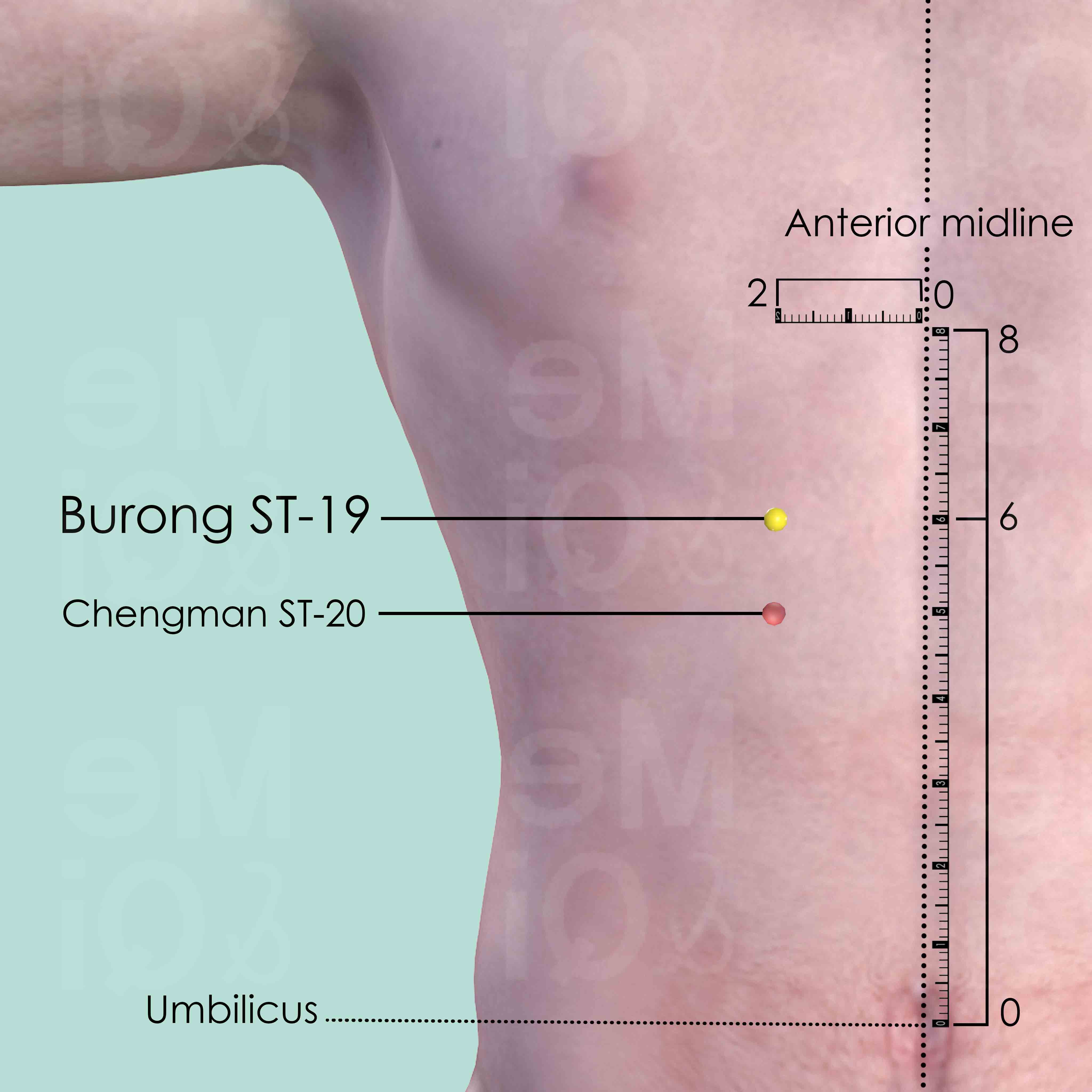
Burong ST-19
2 cun below the sternocostal angel and 6 cun above the umbilicus, 2 cun lateral to the anterior midline.
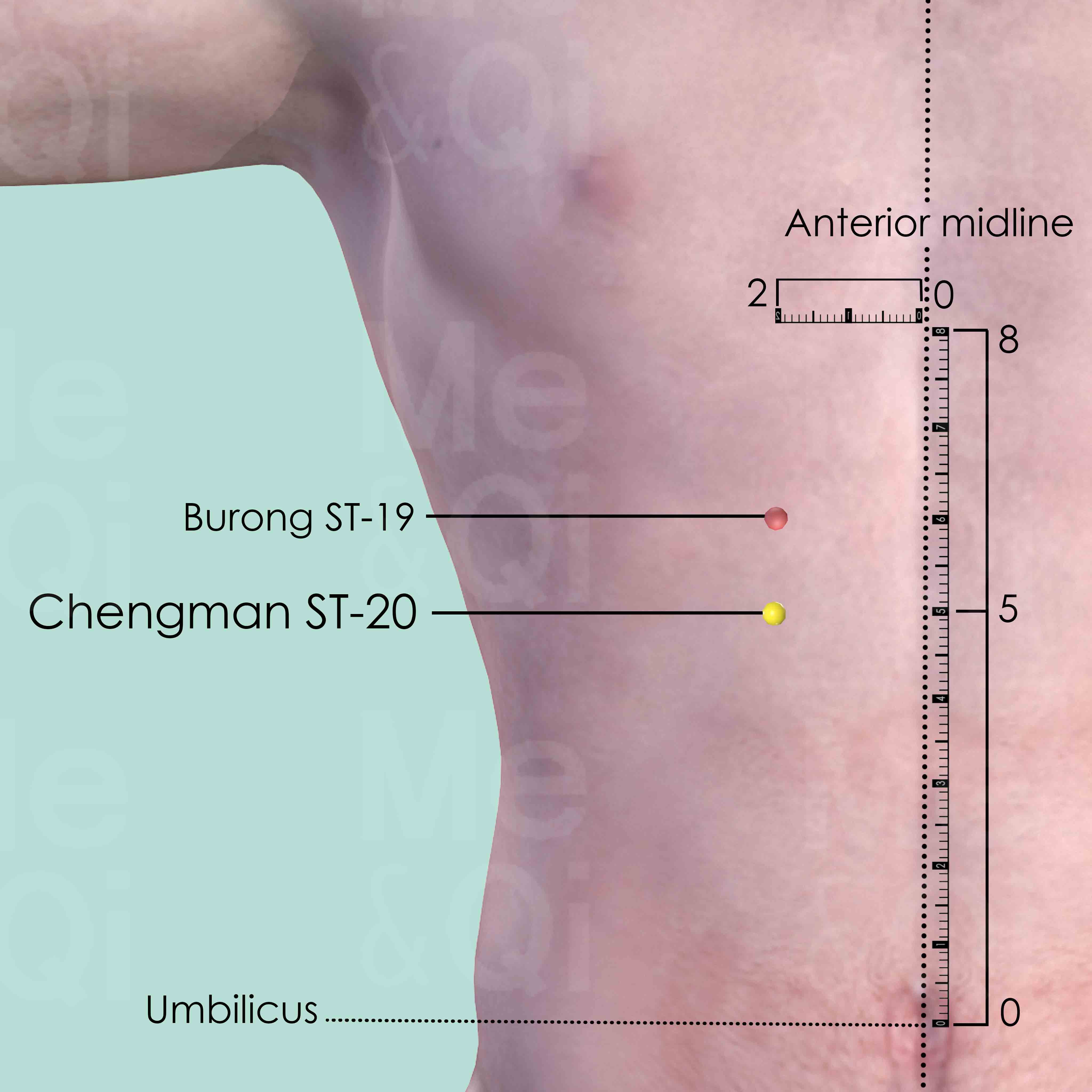
Chengman ST-20
5 cun above the umbilicus and 2 cun lateral to the anterior midline, or 1 cun below Burong ST-19.
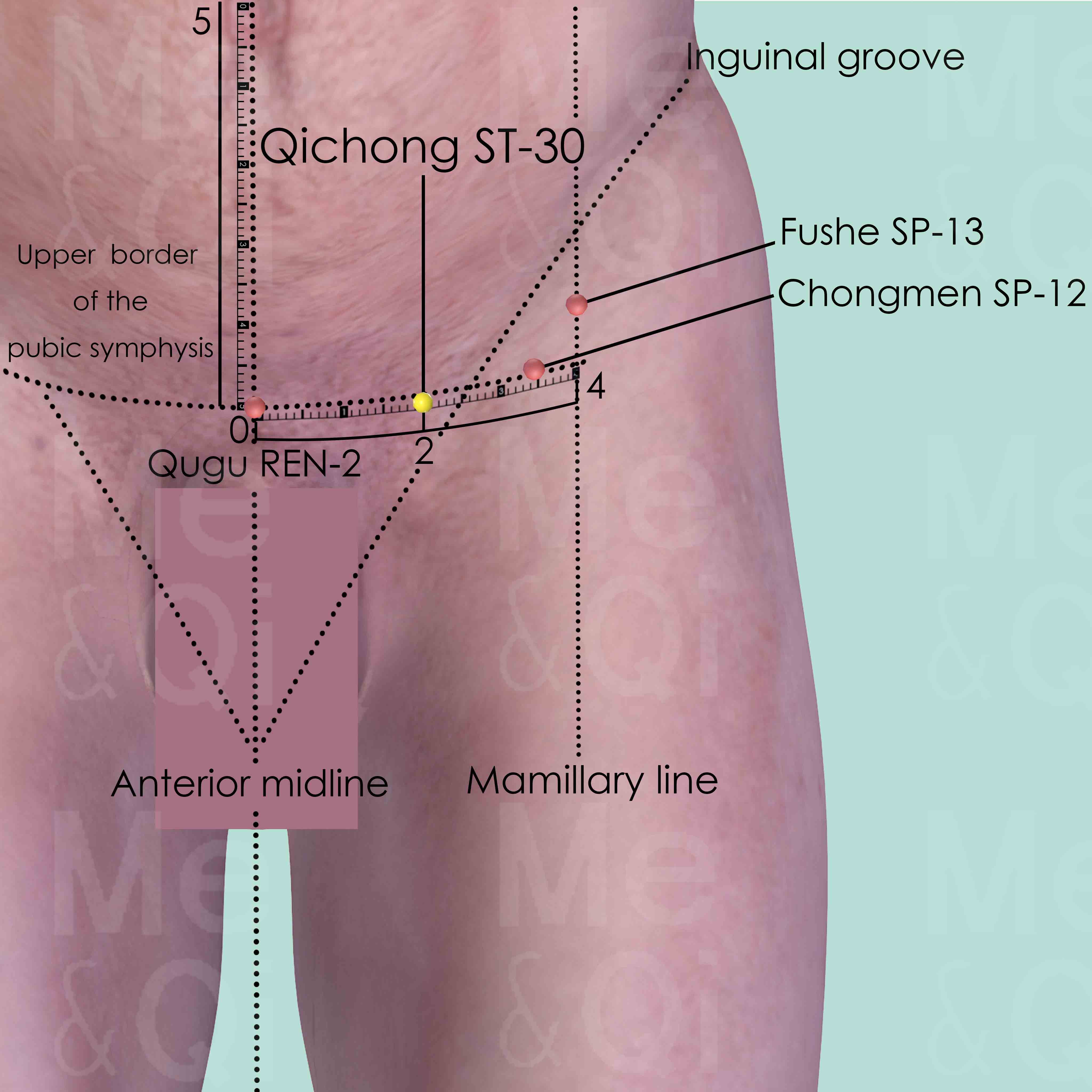
Qichong ST-30
5 cun below the umbilicus, 2 cun lateral to the anterior midline, superior to the inguinal groove, on the medial side of the femoral artery, nerve and vein.
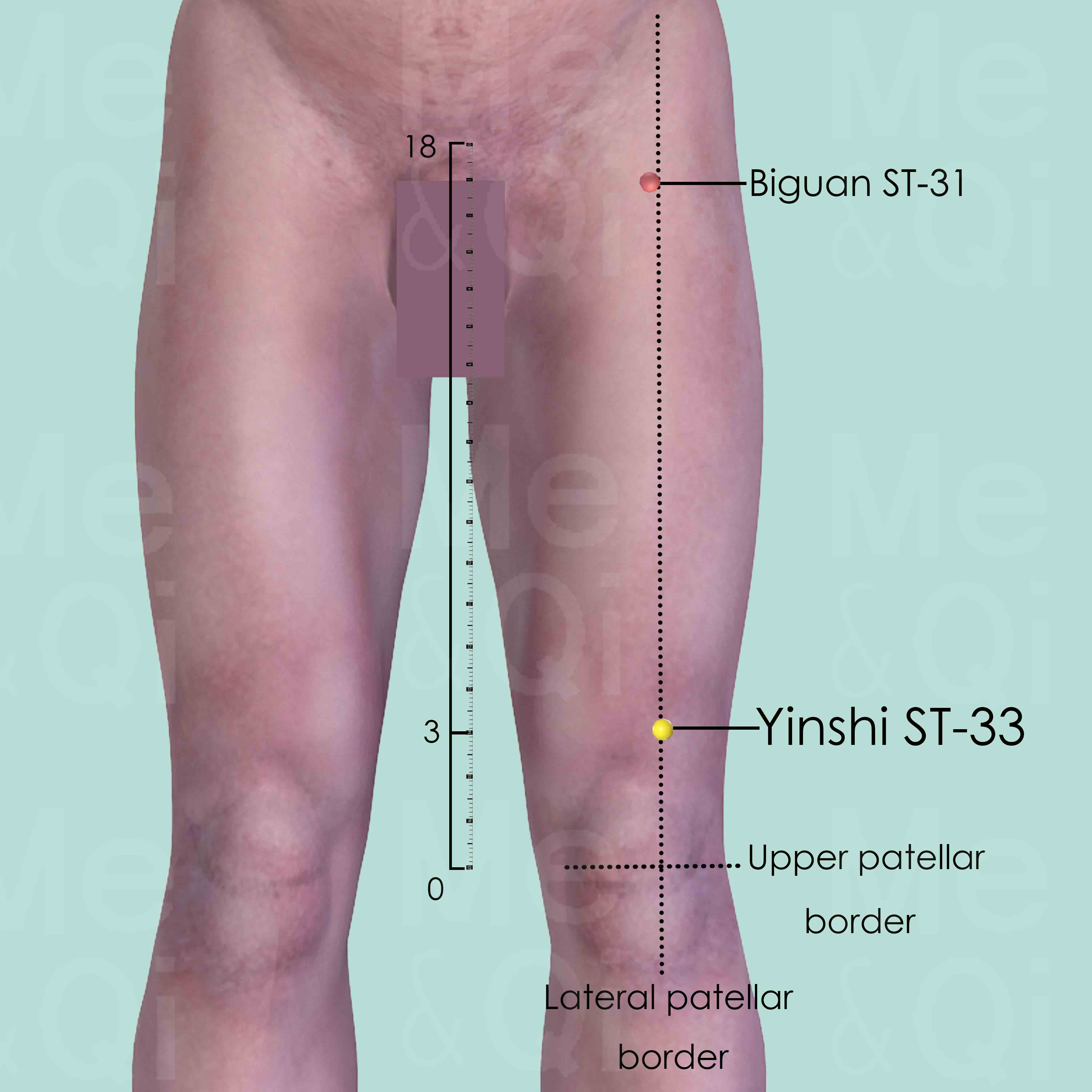
Yinshi ST-33
3 cun above the upper-lateral border of the patella, on a line between the lateral patellar border and the anterior superior iliac spine (ASIS).
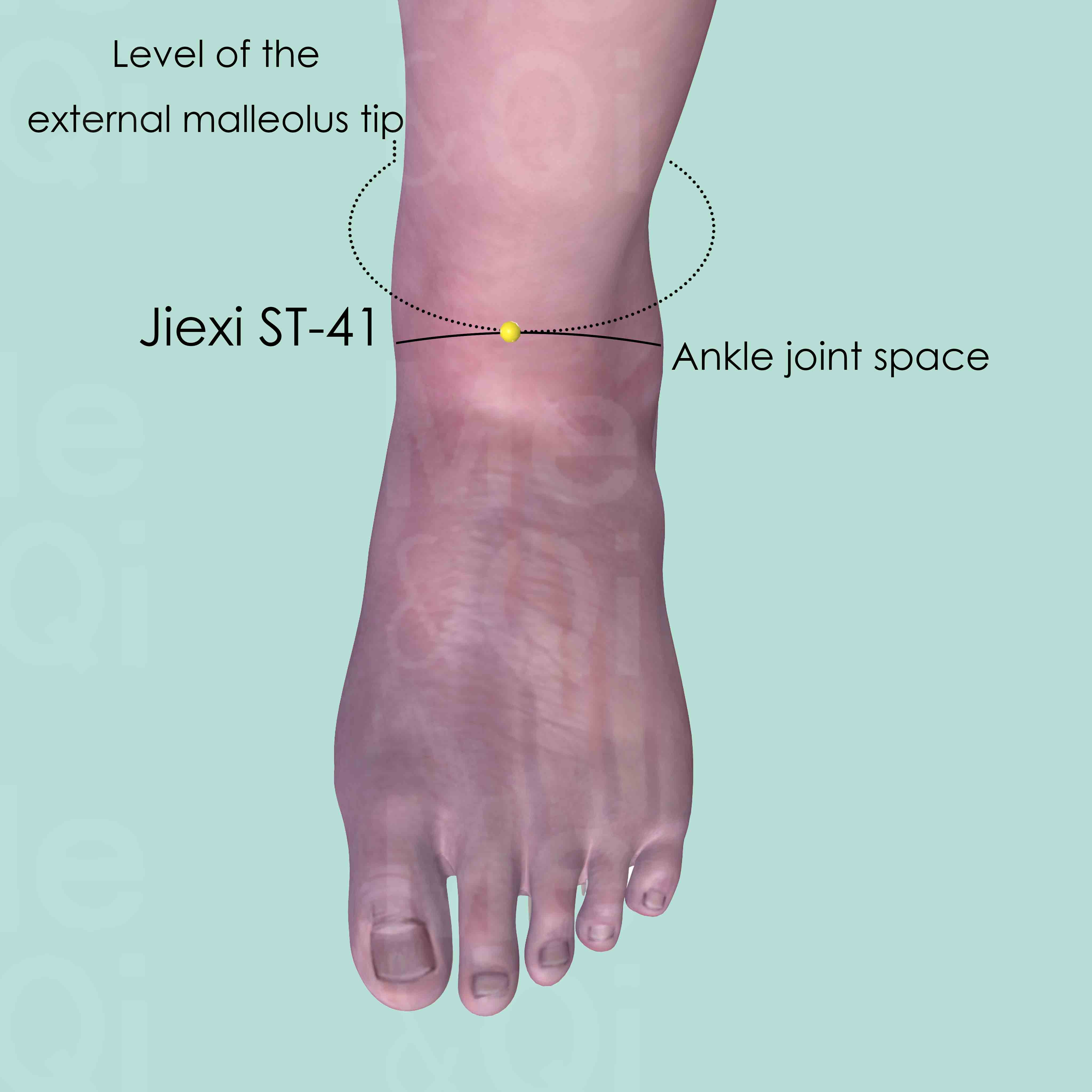
Jiexi ST-41
At the junction of the dorsum of the foot and leg, between the tendons of extensor digitorum and the extensor hallucis longus muscle. Approximately at the level of the tip of the external malleolus.
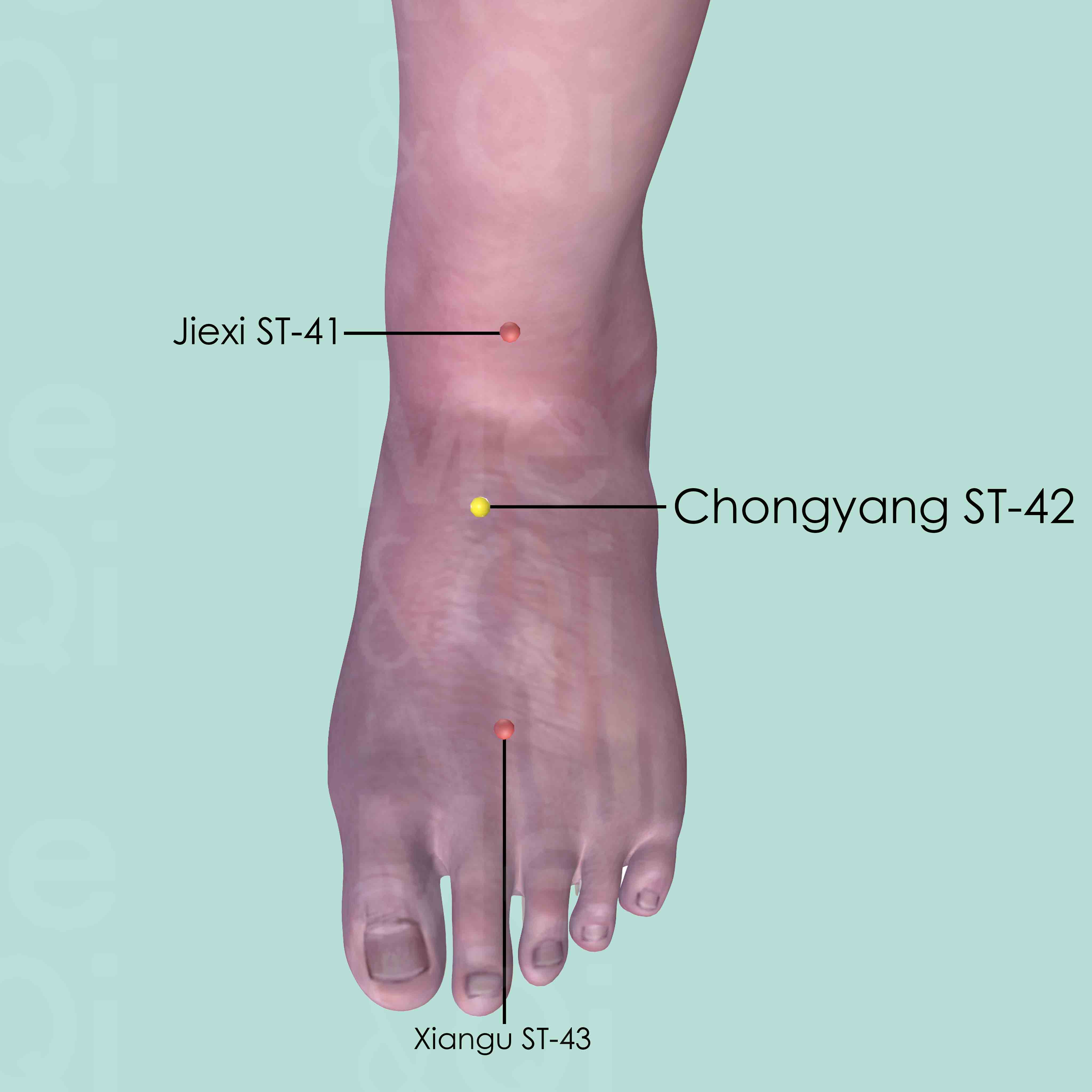
Chongyang ST-42
Distal to Jiexi ST-41, at the highest point of the dorsum of foot, between the tendons of the extensor hallucis longus and the extensor digitorum longus, directly lateral to the point where the dorsalis pedis artery may be palpated. The point is bordered proximally by the 2nd and 3rd metatarsal bones and distally by the 2nd and 3rd cuneiform bones.
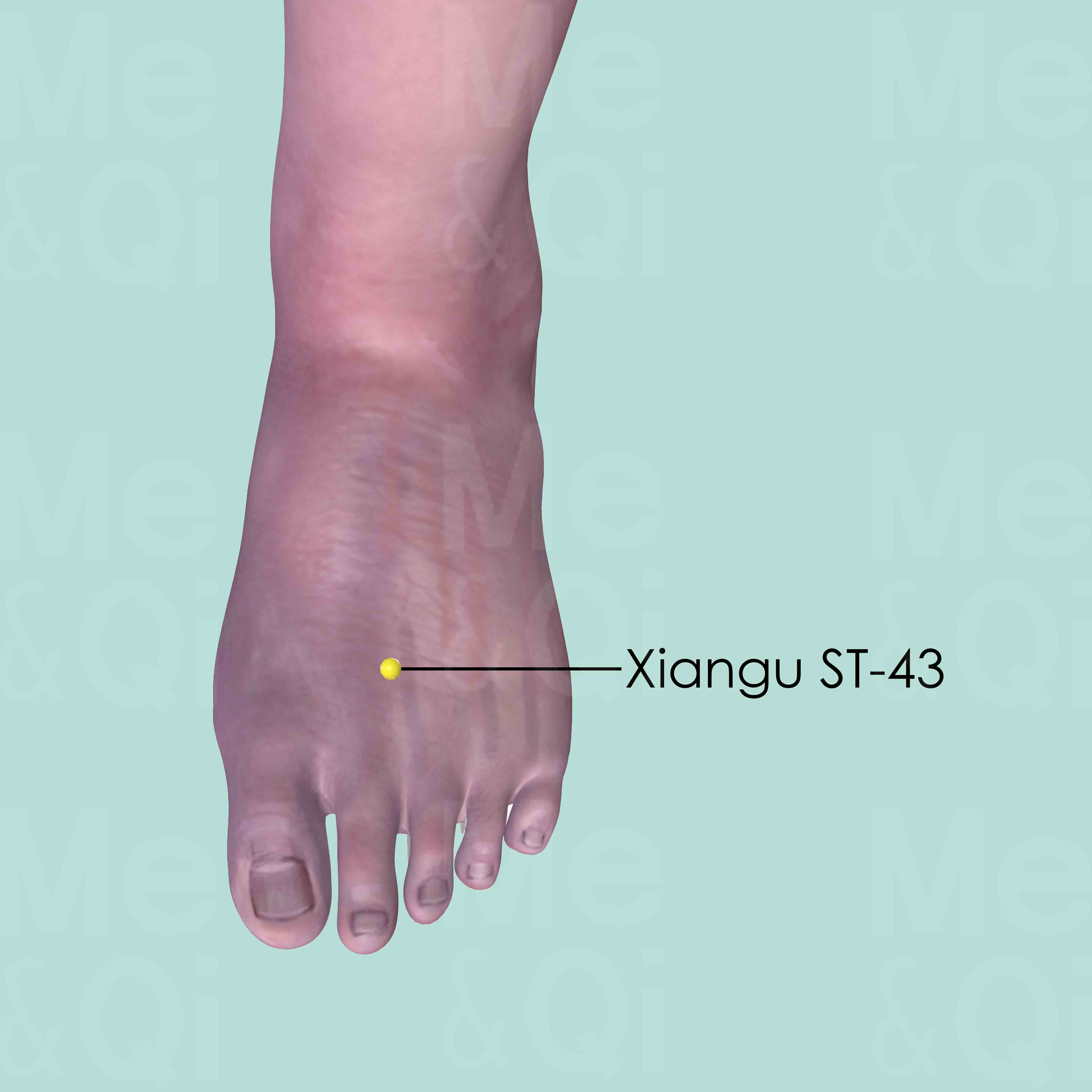
Xiangu ST-43
On the dorsum of the foot, in the depression between the 2nd and 3rd metatarsal bones, at the level of the junction of the shafts and the heads of these metatarsal bones.
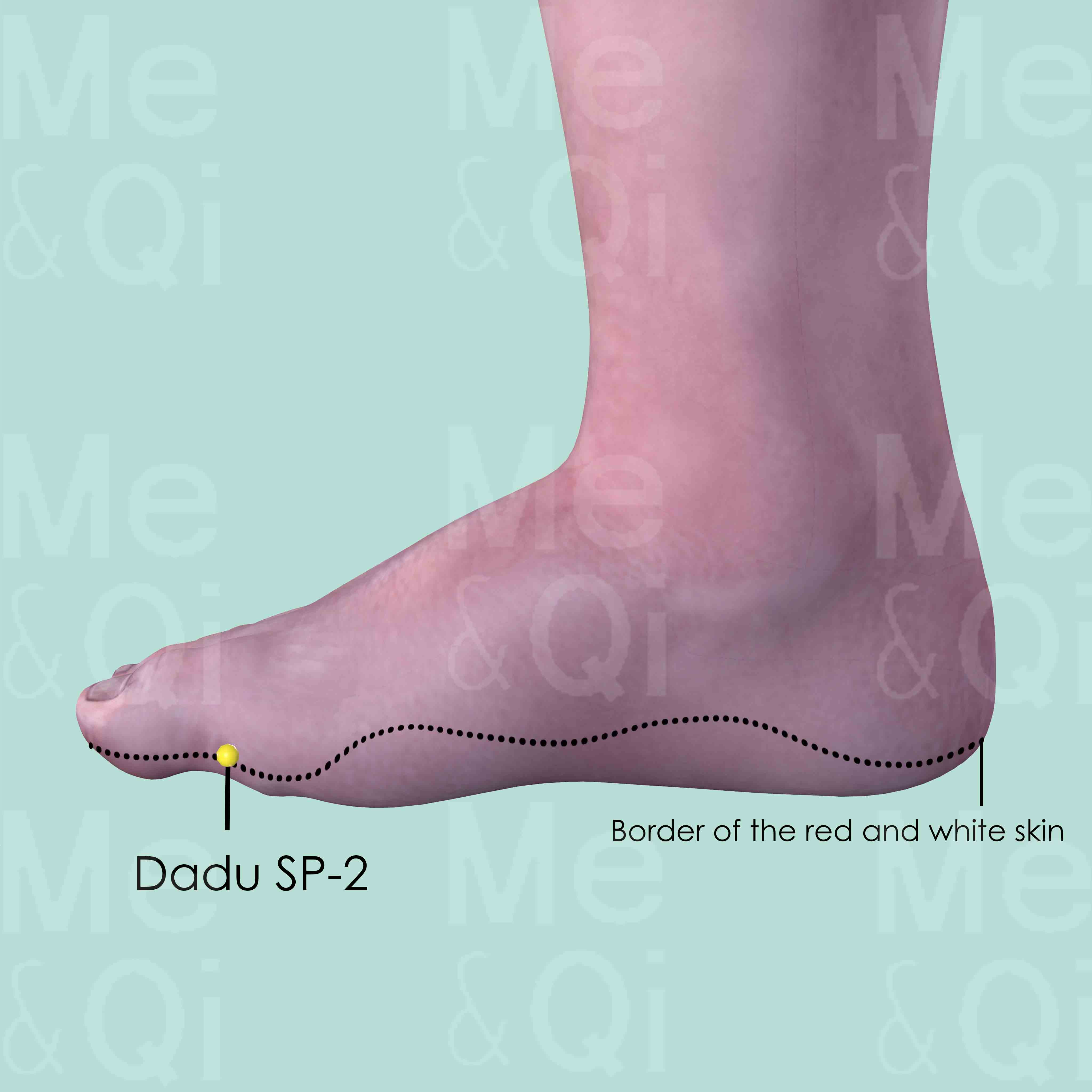
Dadu SP-2
On the medial aspect of the big toe, at the junction of the shaft and the base of the proximal phalanx, distal to the 1st metatarsophalangeal joint.
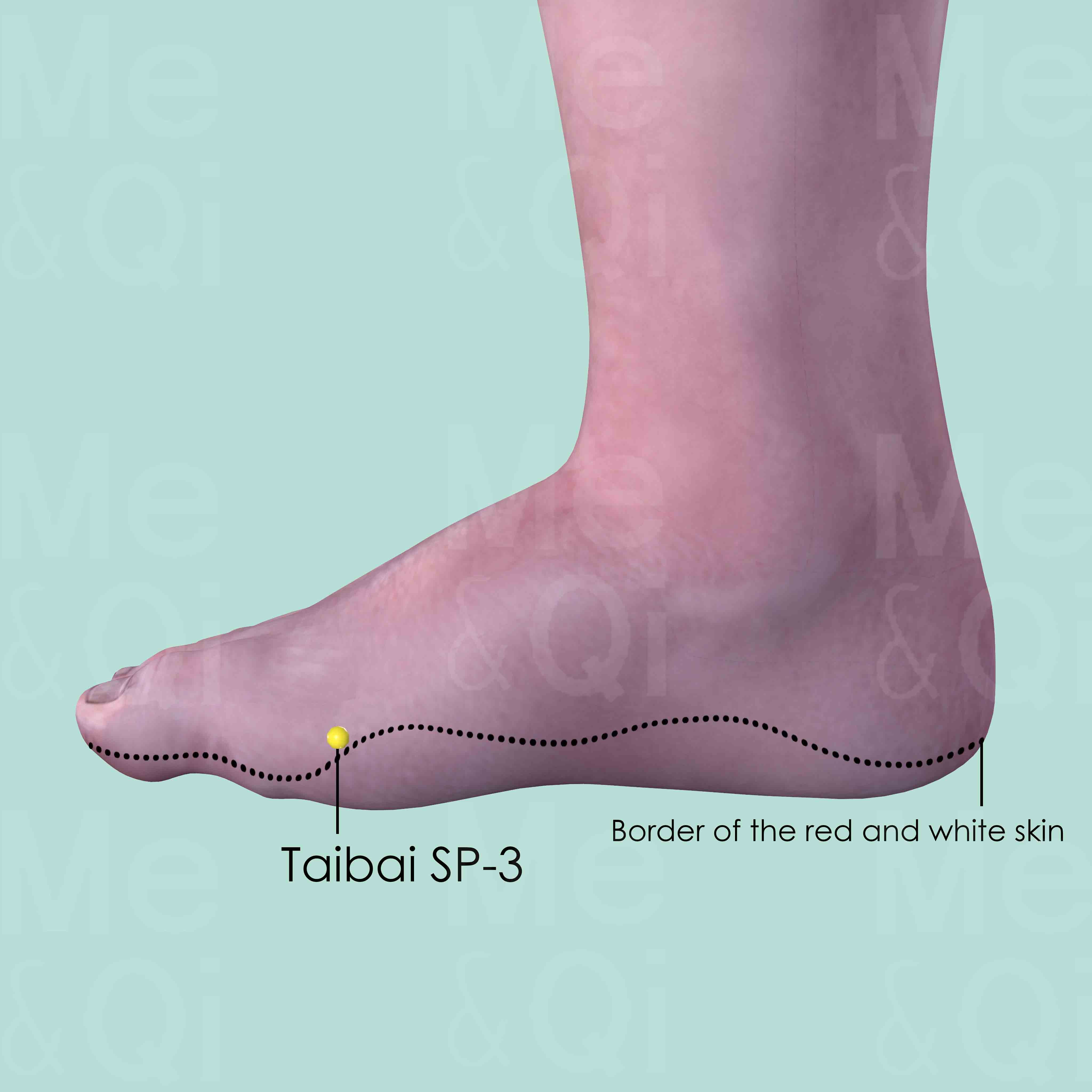
Taibai SP-3
Proximal and inferior to the head of the 1st metatarsal bone, at the border of the red and white skin.
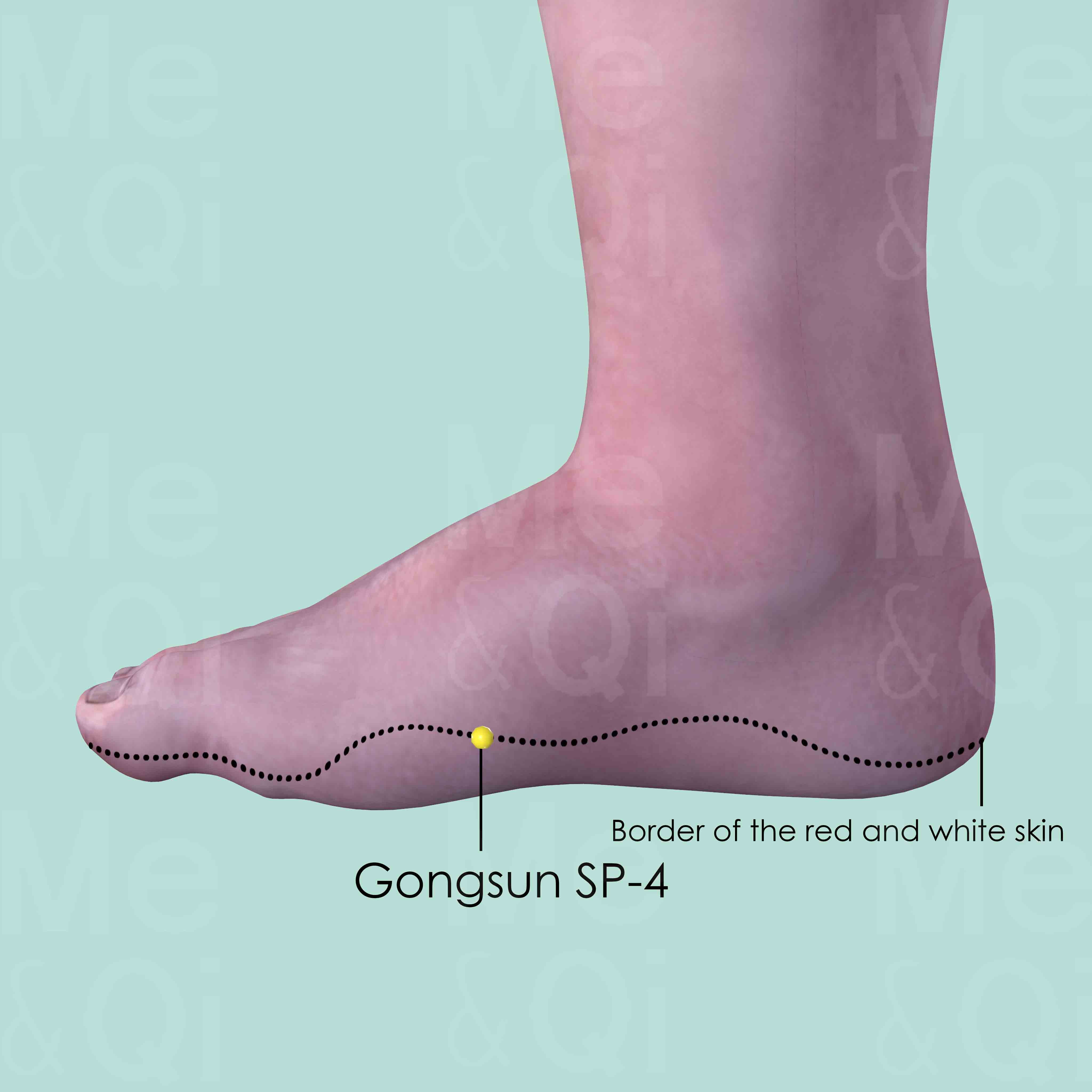
Gongsun SP-4
In the depression distal and inferior to the base of the 1st metatarsal bone, at the border of the red and white skin.
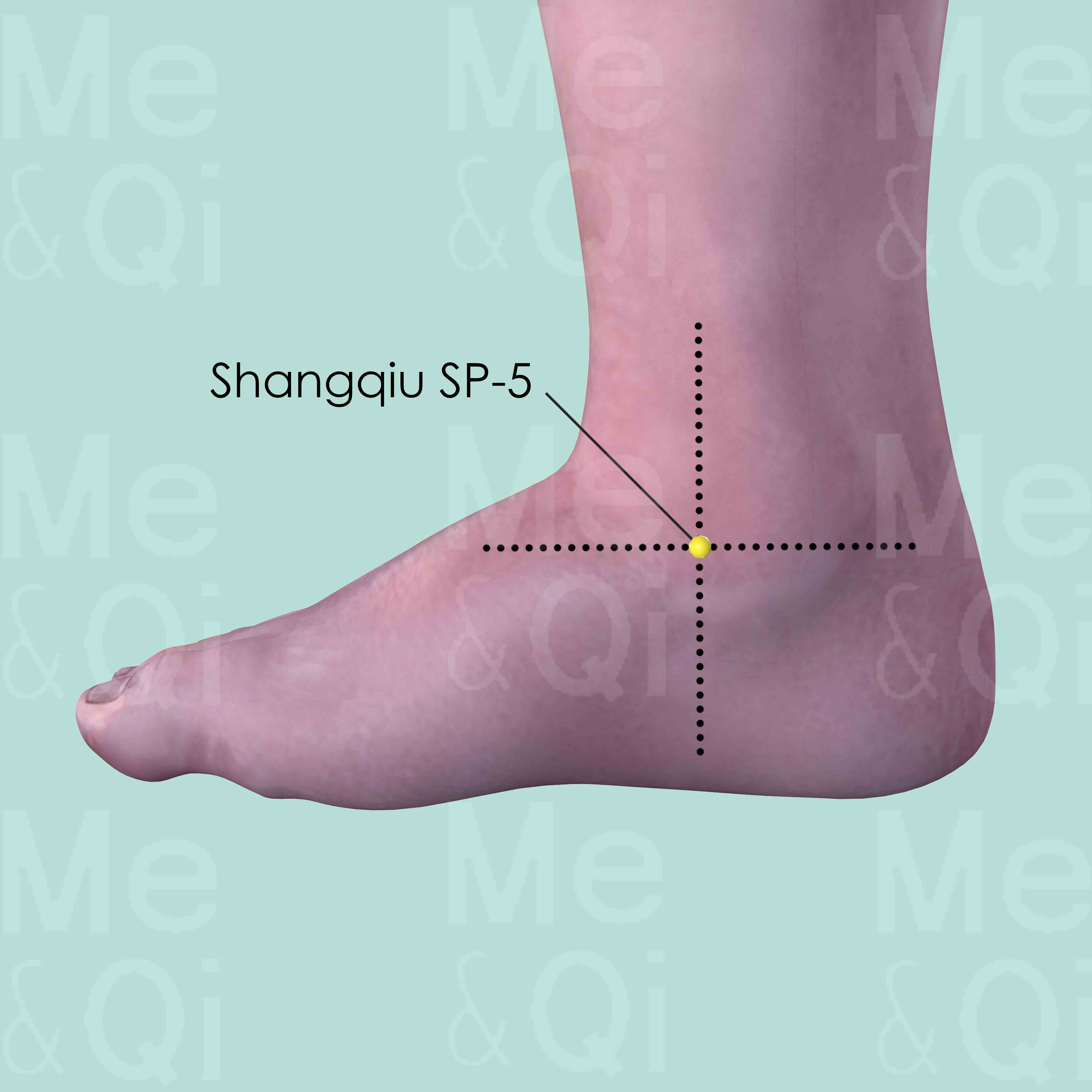
Shangqiu SP-5
In the depression distal and inferior to the medial malleolus, midway between the navicular bone tubercle and the tip of the medial malleolus.
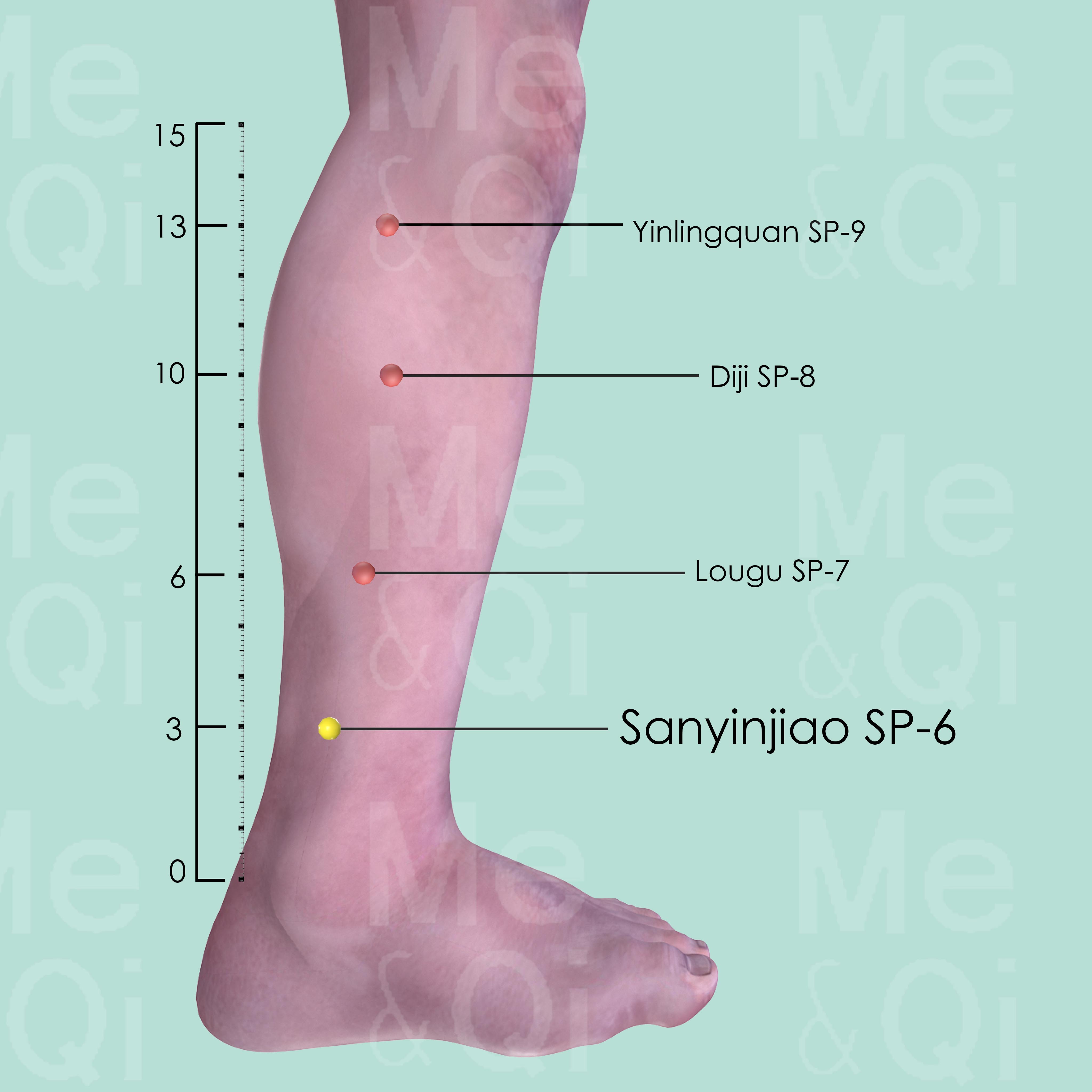
Sanyinjiao SP-6
3 cun directly above the tip of the medial malleolus, on the posterior border of the tibia, on the line drawn from the medial malleolus to Yinlingquan SP-9.
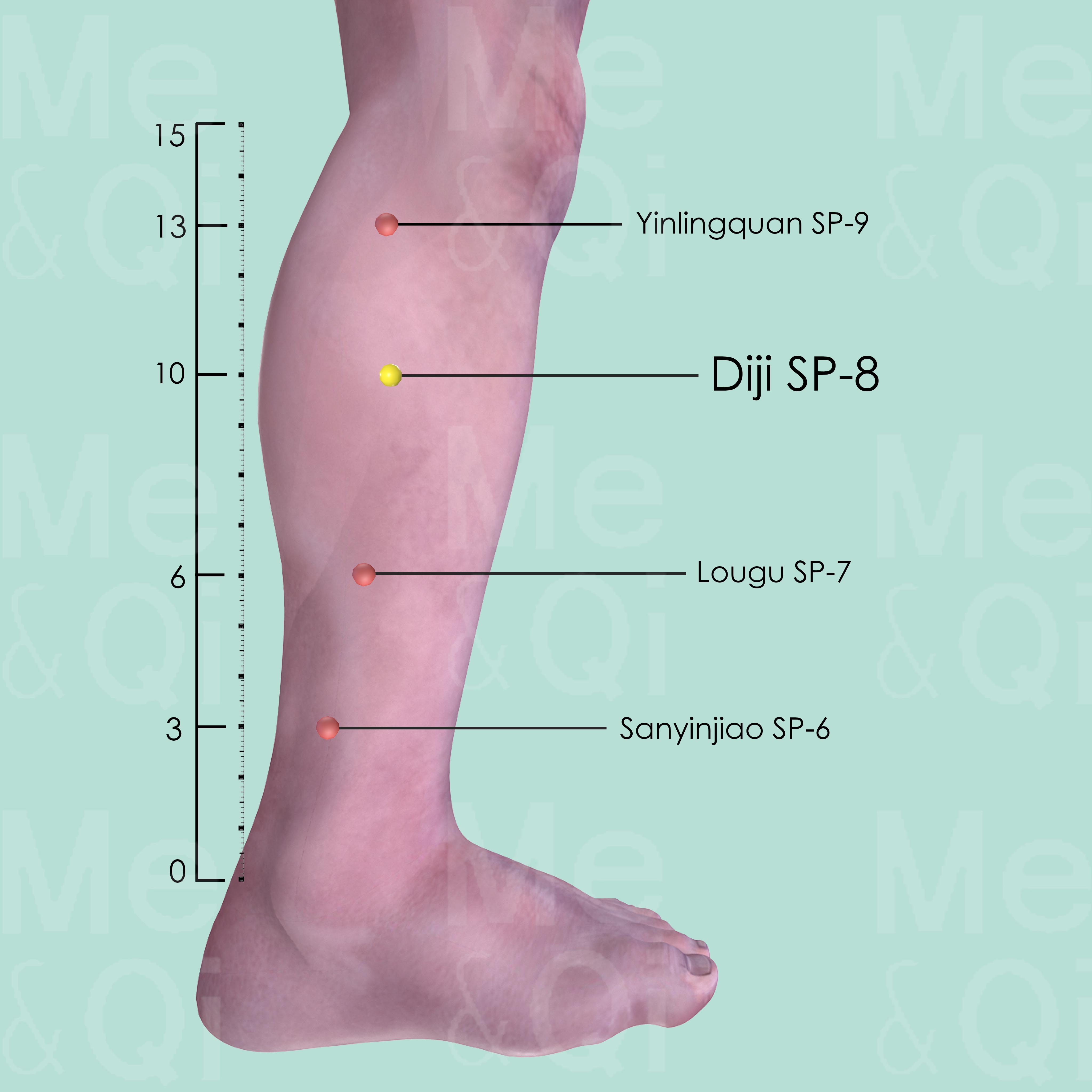
Diji SP-8
3 cun below the medial condyle of the tibia, on the line connecting Yinlingquan SP-9 and the the medial malleolus.
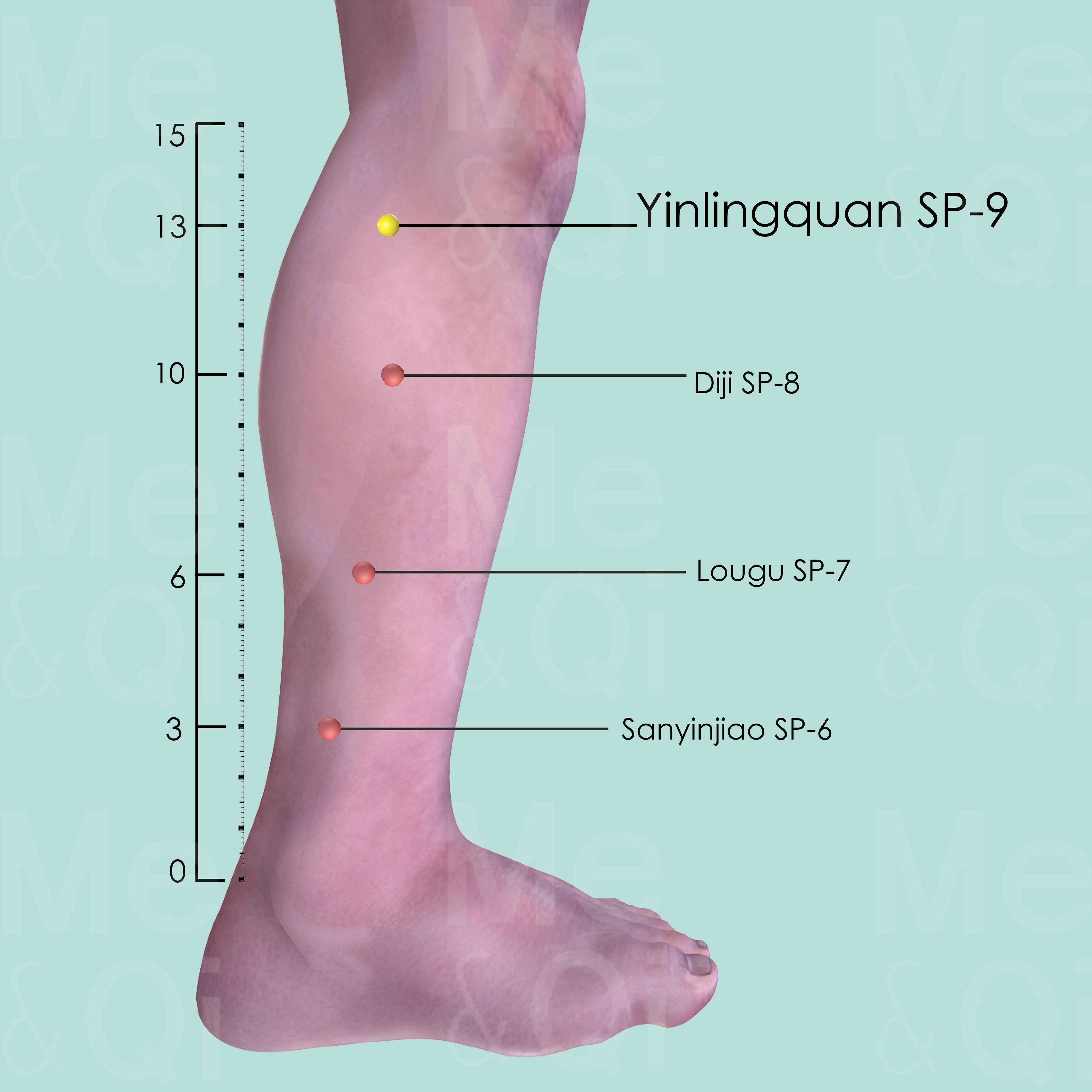
Yinlingquan SP-9
On the lower border of the medial condyle of the tibia, in the depression between the posterior border of the tibia and gastrocnemius muscle.
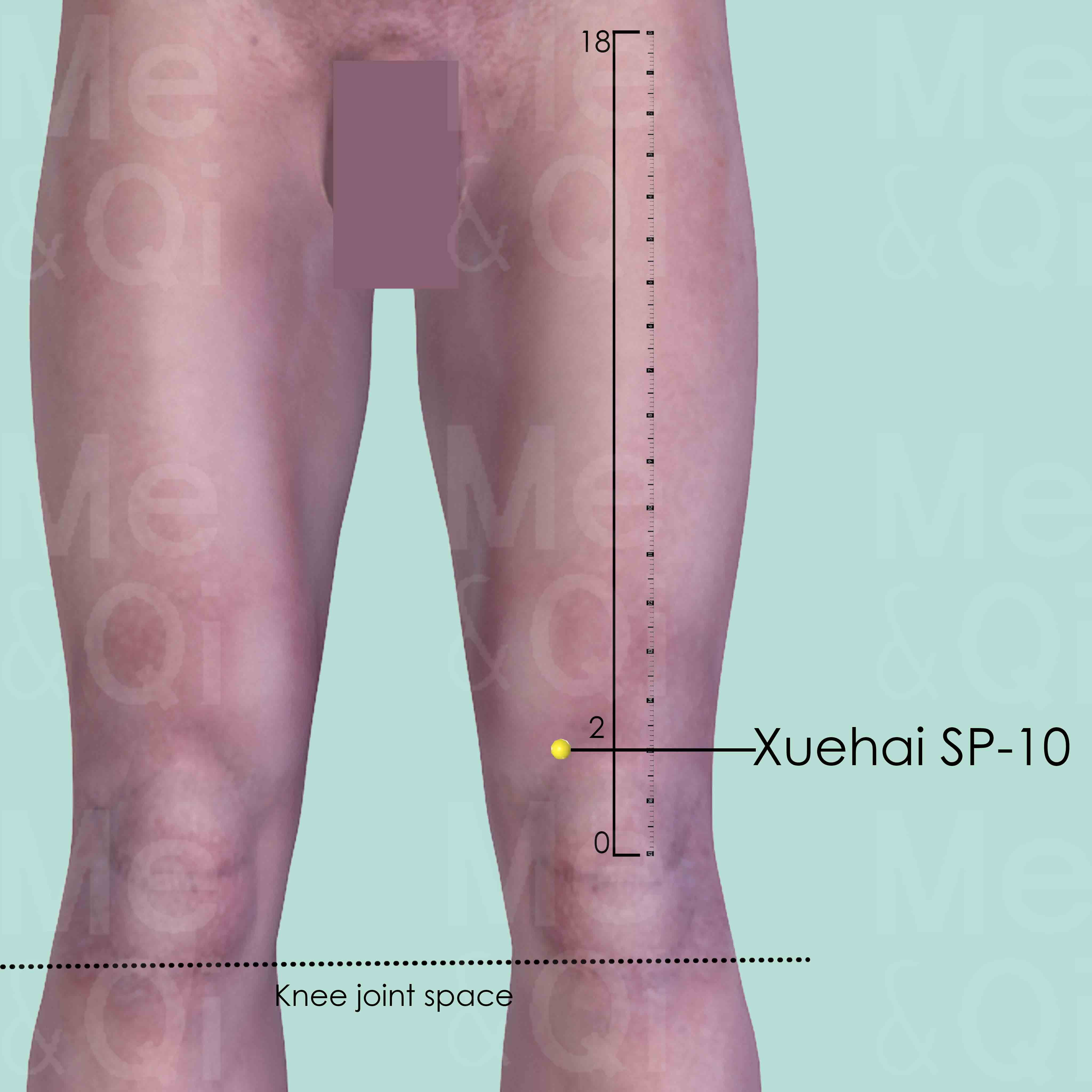
Xuehai SP-10
When knee is flexed, Xuehai SP-10 is 2 cun above the medial upper border of the patella, in a depression on the vastus medialis muscle.
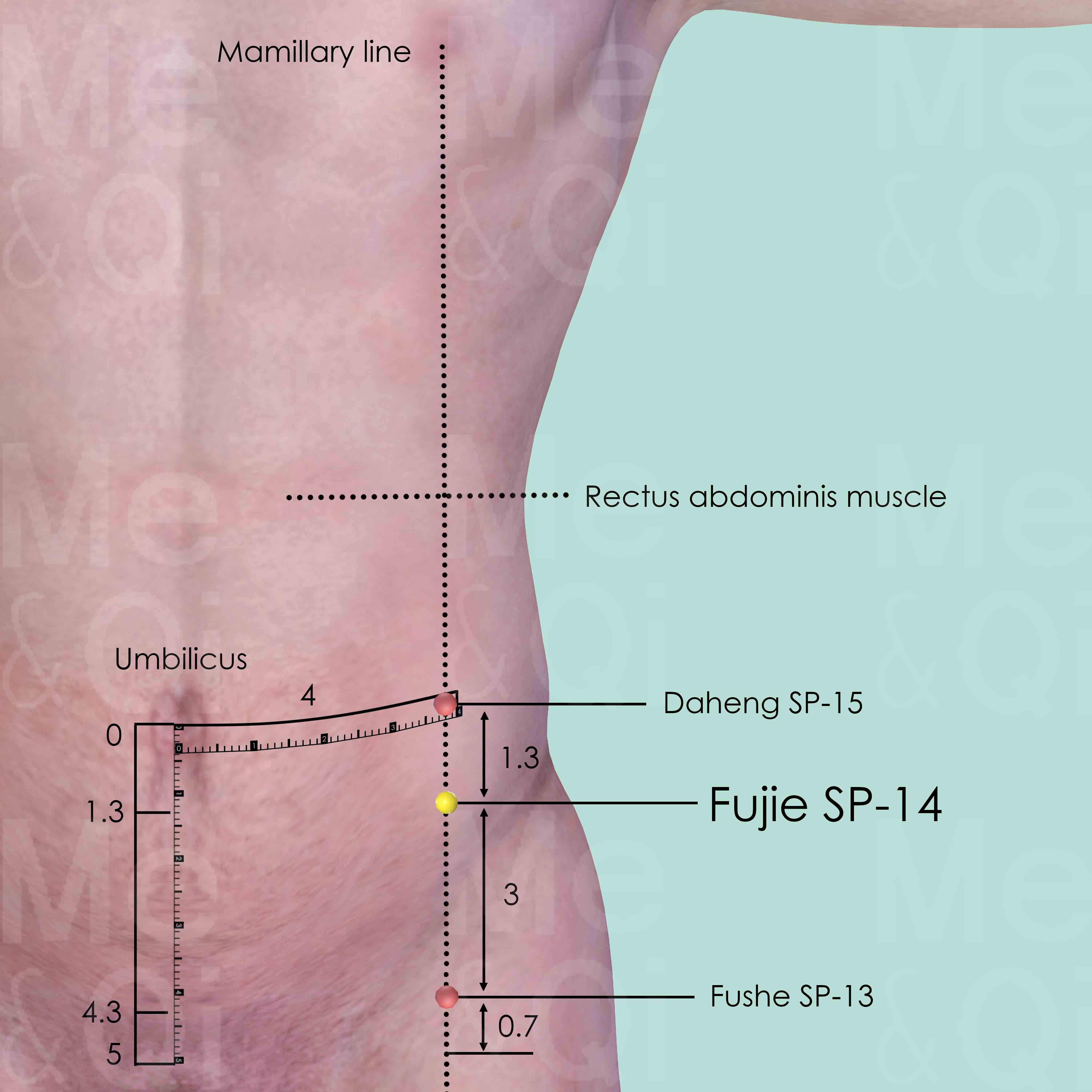
Fujie SP-14
On the mamillary line which is 4 cun lateral to the anterior midline. 3 cun above Fushe SP-13, 1.3 cun below Daheng SP-15, on the lateral side of rectus abdominis muscle.
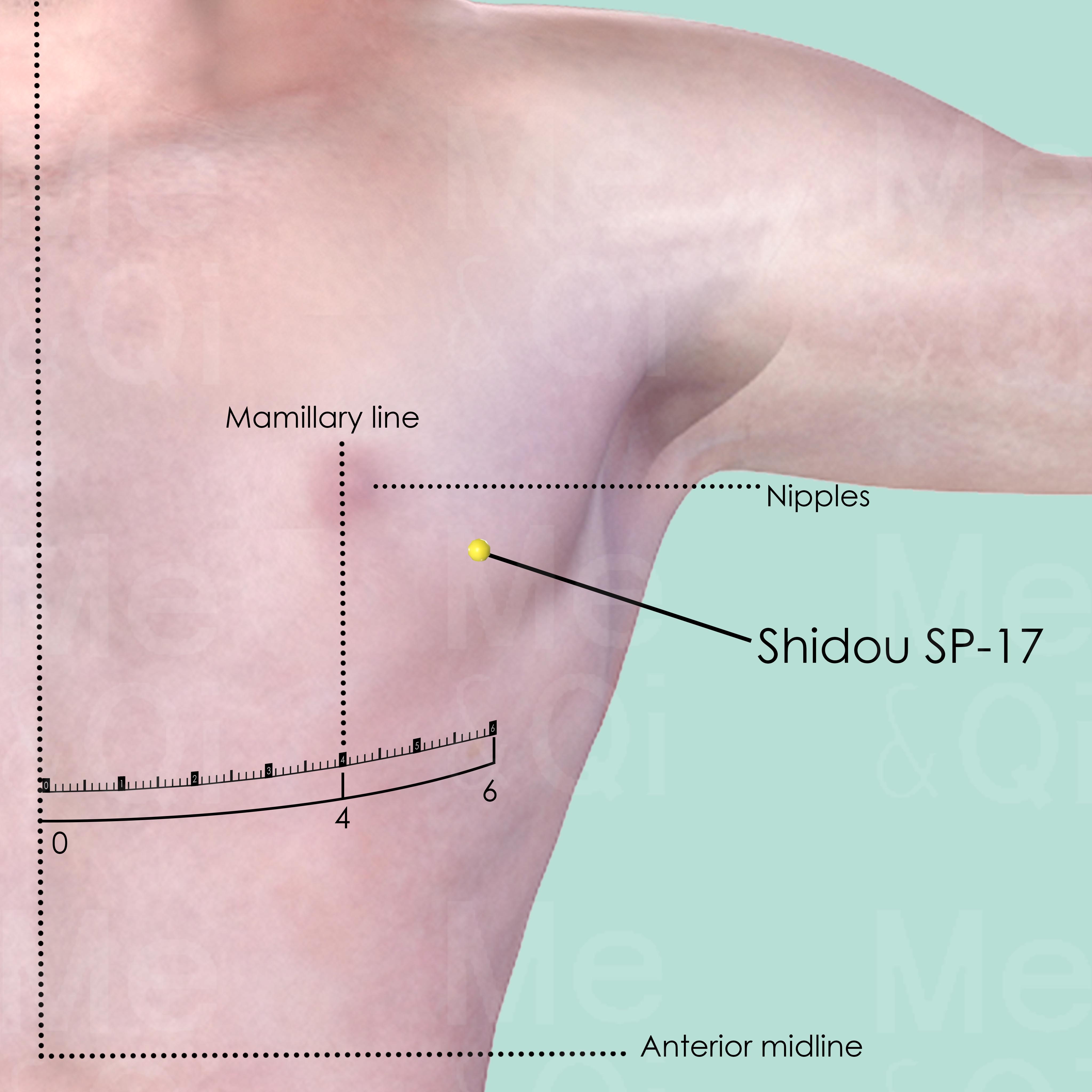
Shidou SP-17
6 cun lateral to the anterior midline, 2 cun lateral to the mamillary line, in the 5th intercostal space.
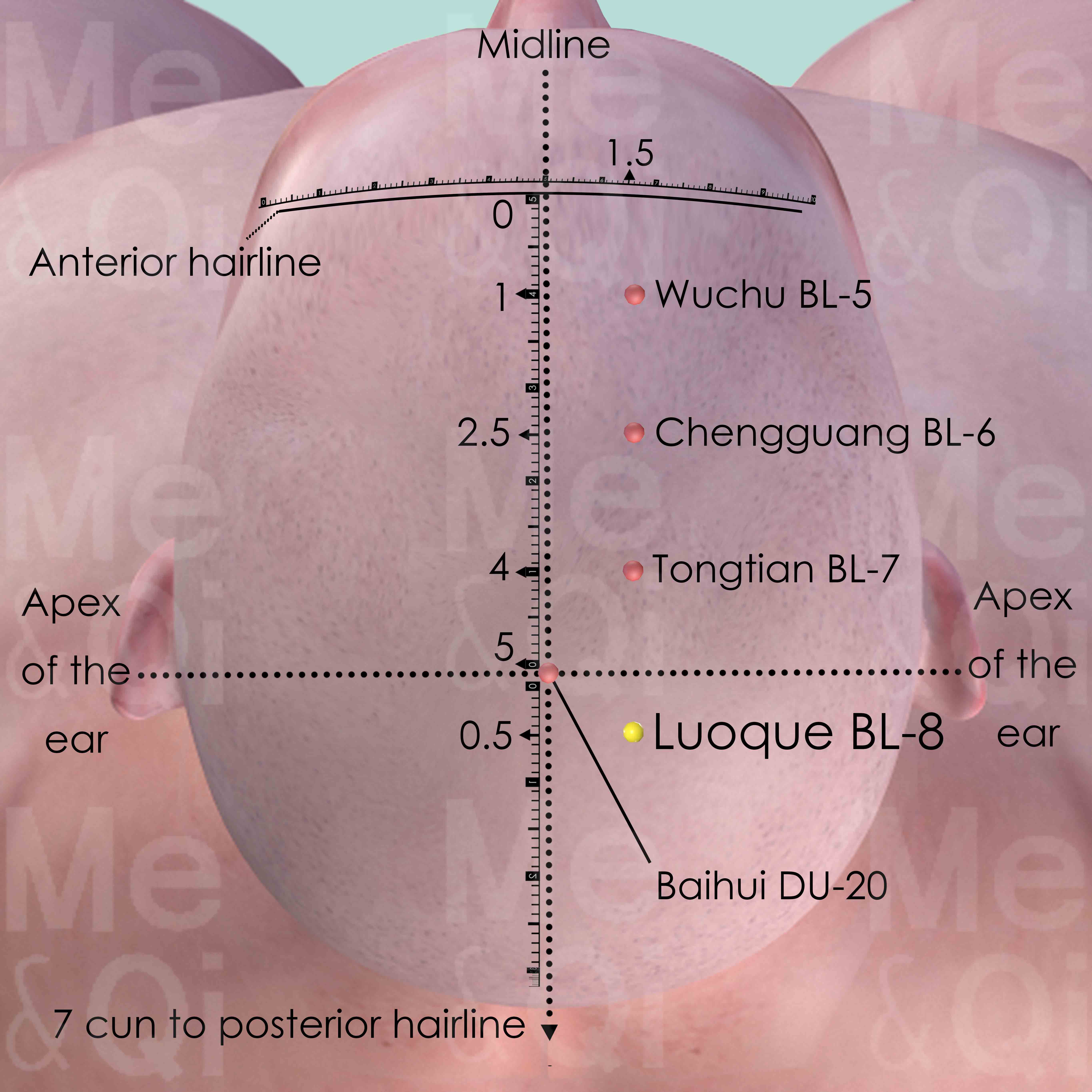
Luoque BL-8
1.5 cun lateral to the anterior midline and 5.5 cun superior to the anterior hairline. Or 0.5 cun posterior to Baihui Du-20 at the vertex.
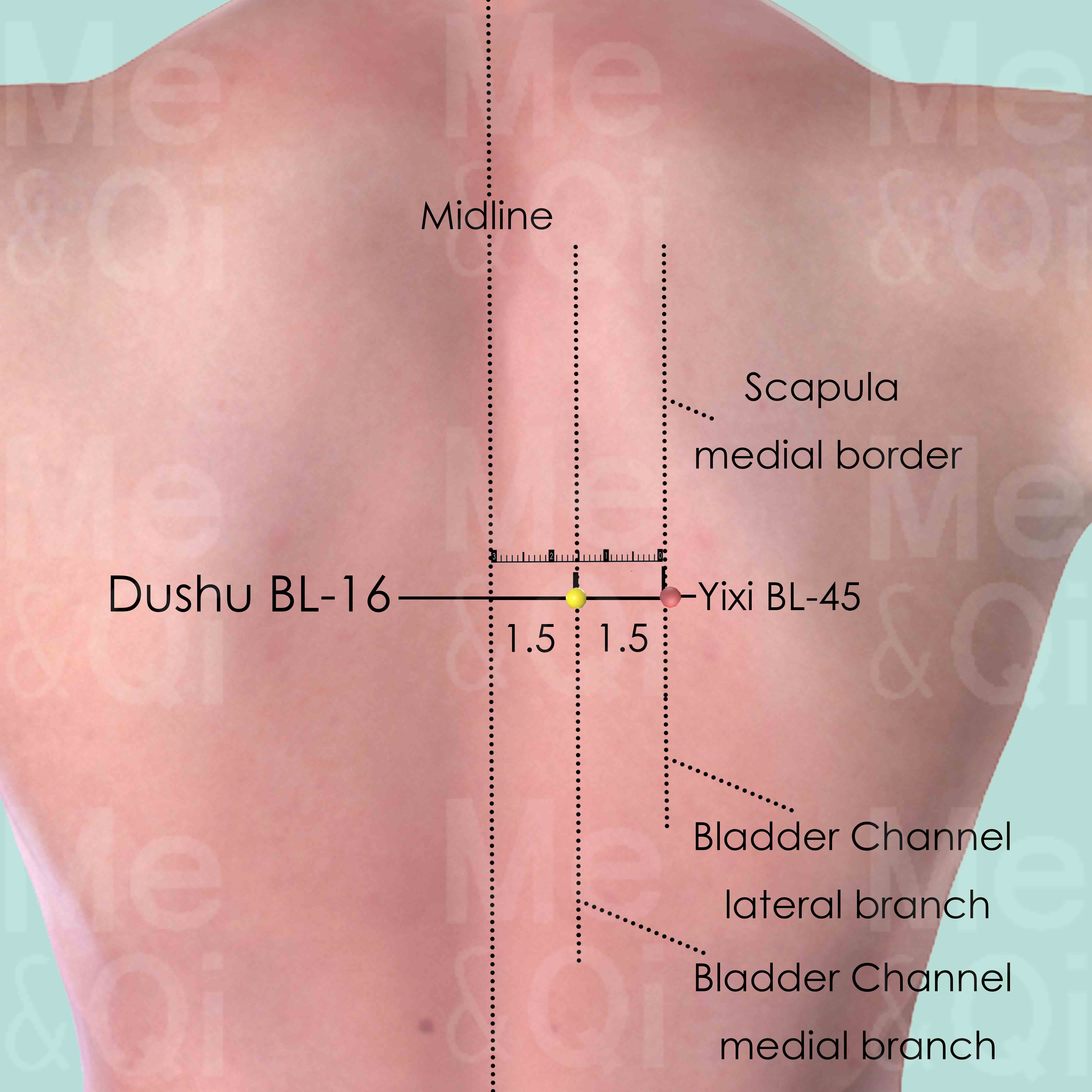
Dushu BL-16
1.5 cun lateral to the lower border of the spinous process of the 6th thoracic vertebra (T6).
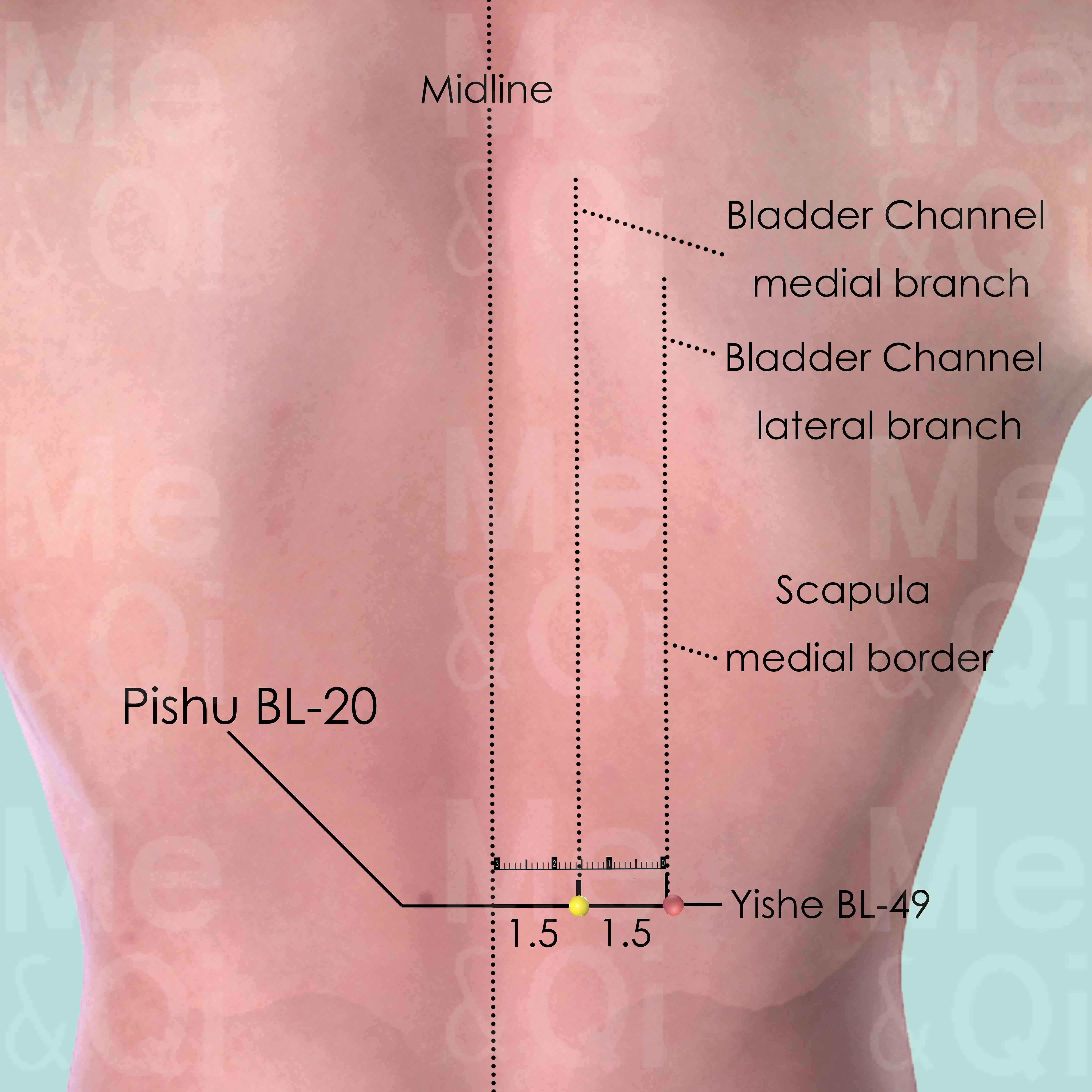
Pishu BL-20
1.5 cun lateral to the lower border of the spinous process of the 11th thoracic vertebra (T11).
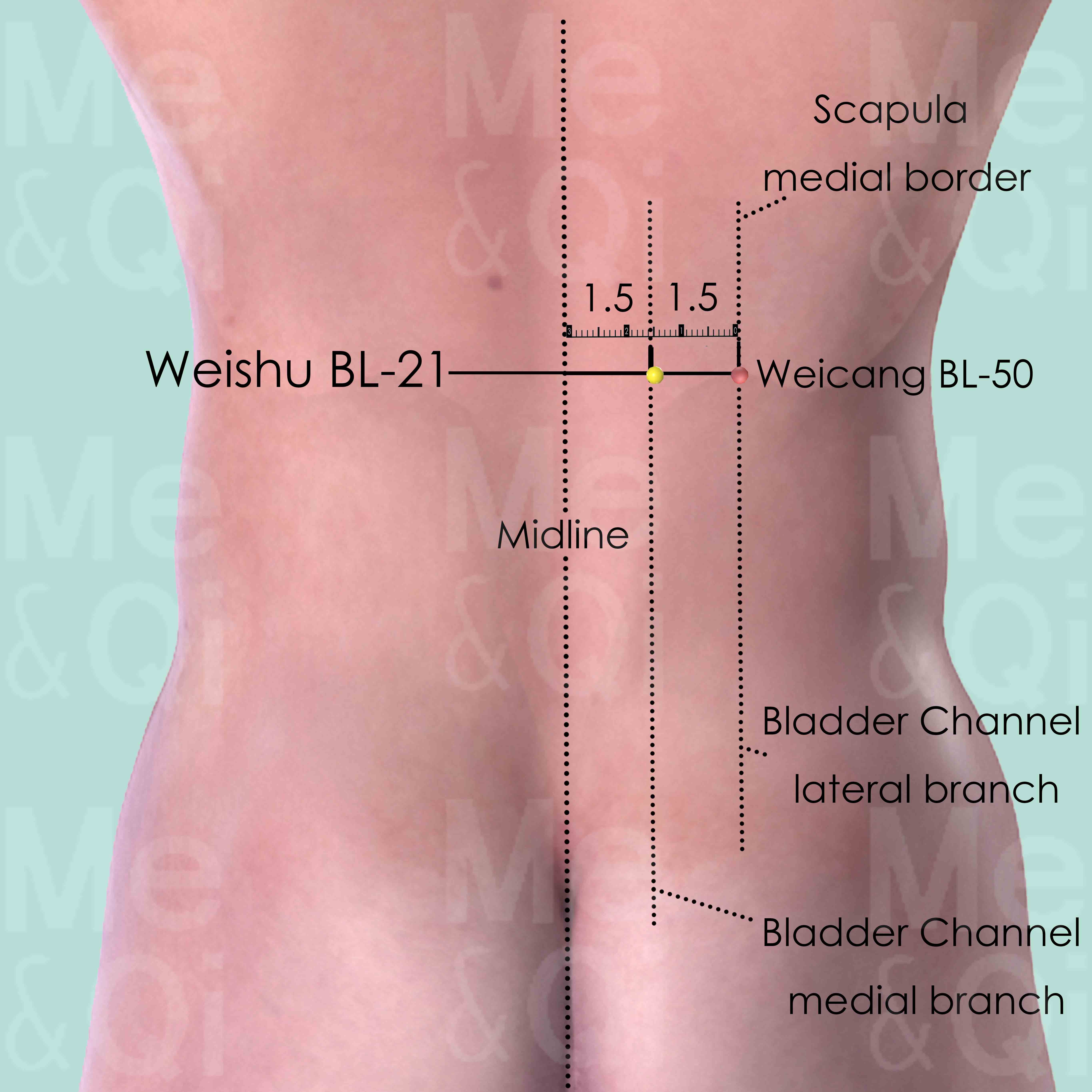
Weishu BL-21
1.5 cun lateral to the lower border of the spinous process of the 12th thoracic vertebra (T12).
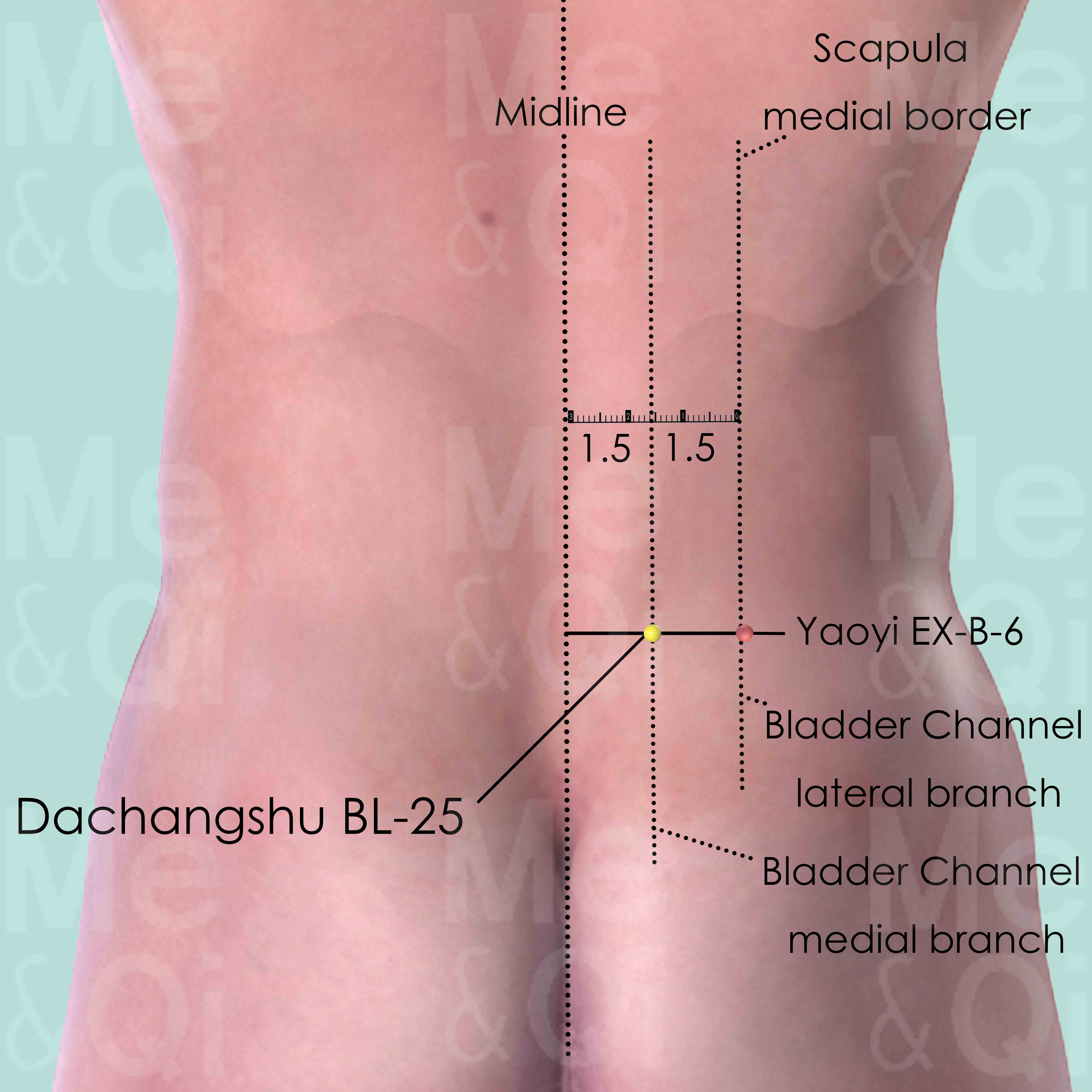
Dachangshu BL-25
1.5 cun lateral to the lower border of the spinous process of the 4th lumber vertebra (L4).
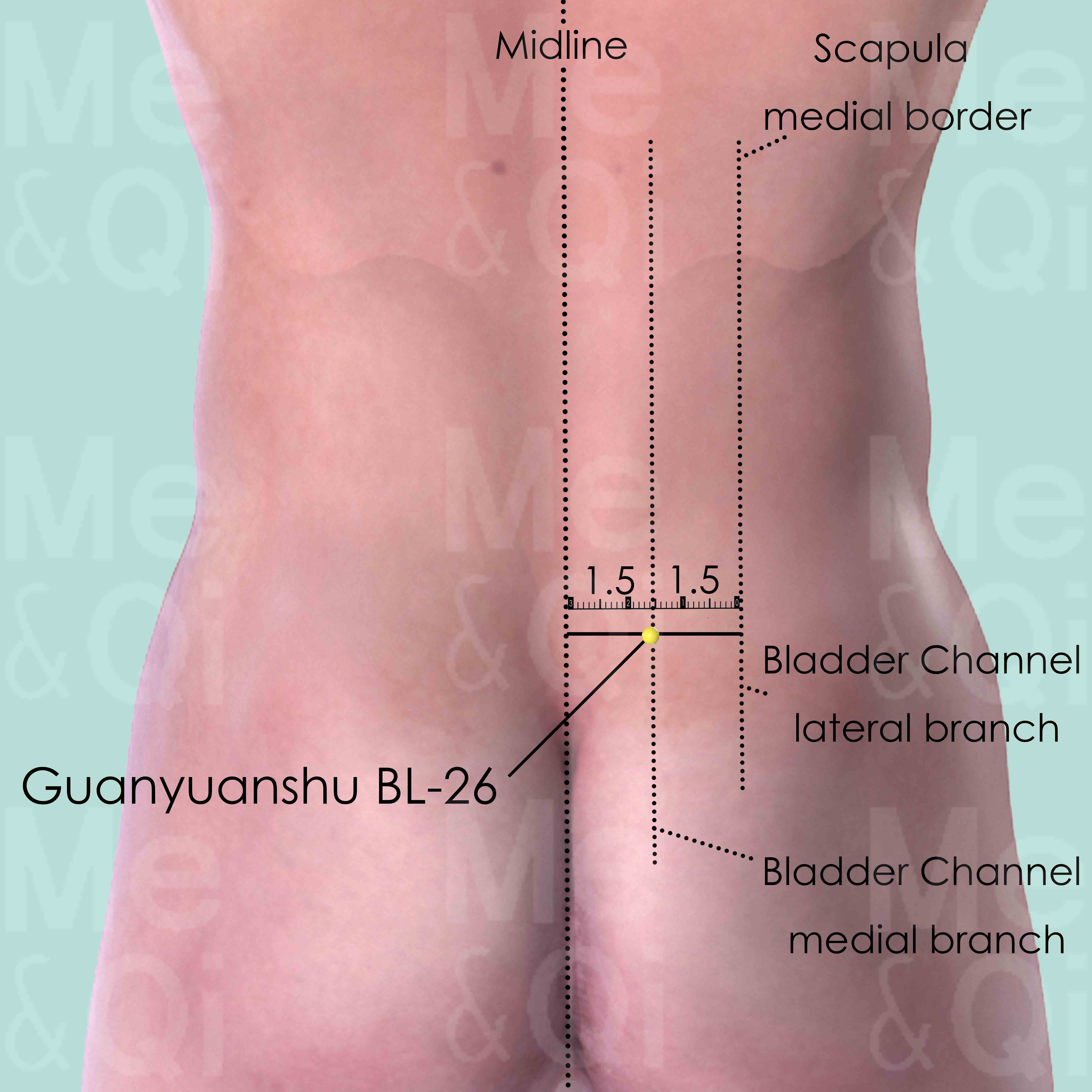
Guanyuanshu BL-26
1.5 cun lateral to the lower border of the spinous process of the 5th lumber vertebra (L5).
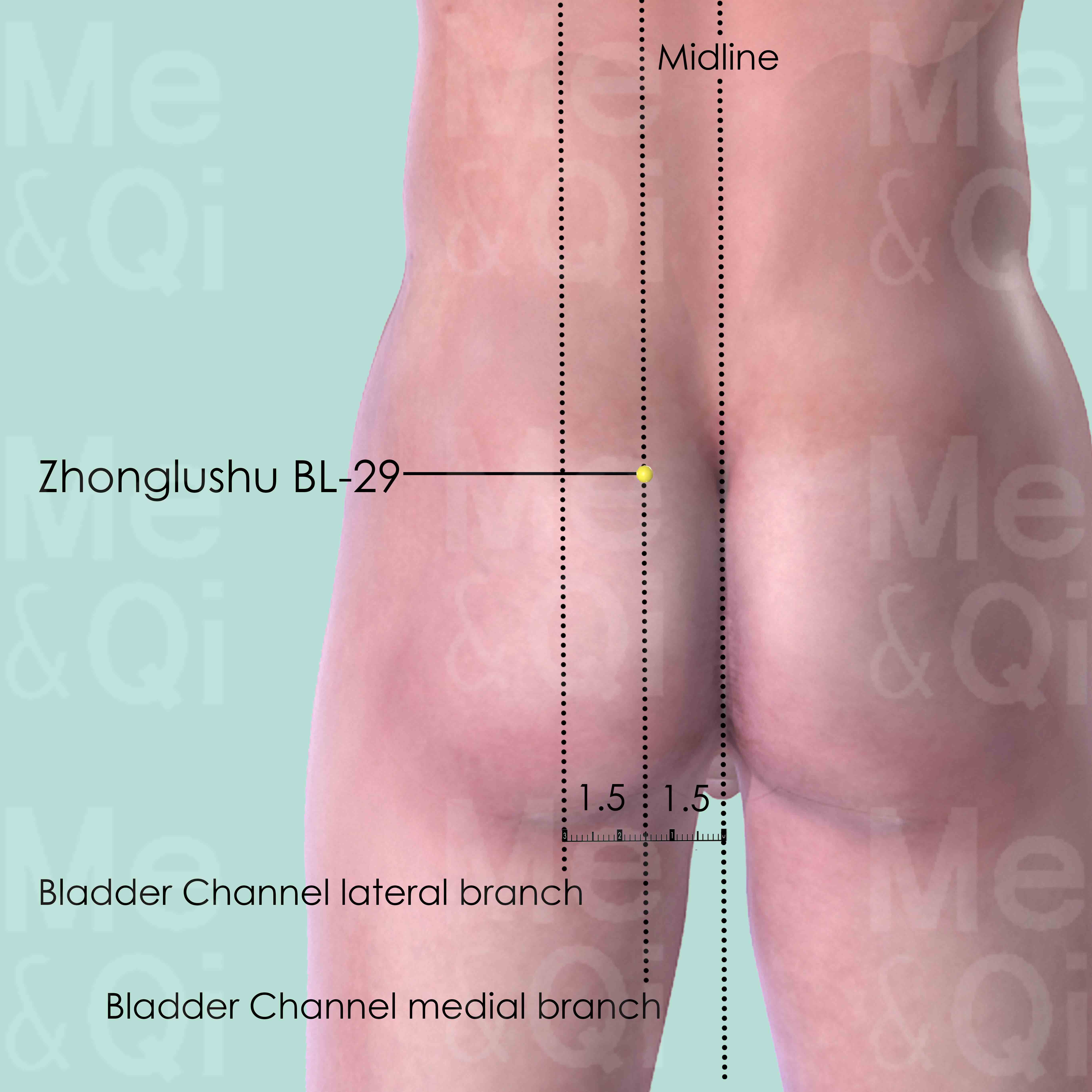
Zhonglushu BL-29
At the level of the 3rd posterior sacral foramen, 1.5 cun lateral to the posterior midline.
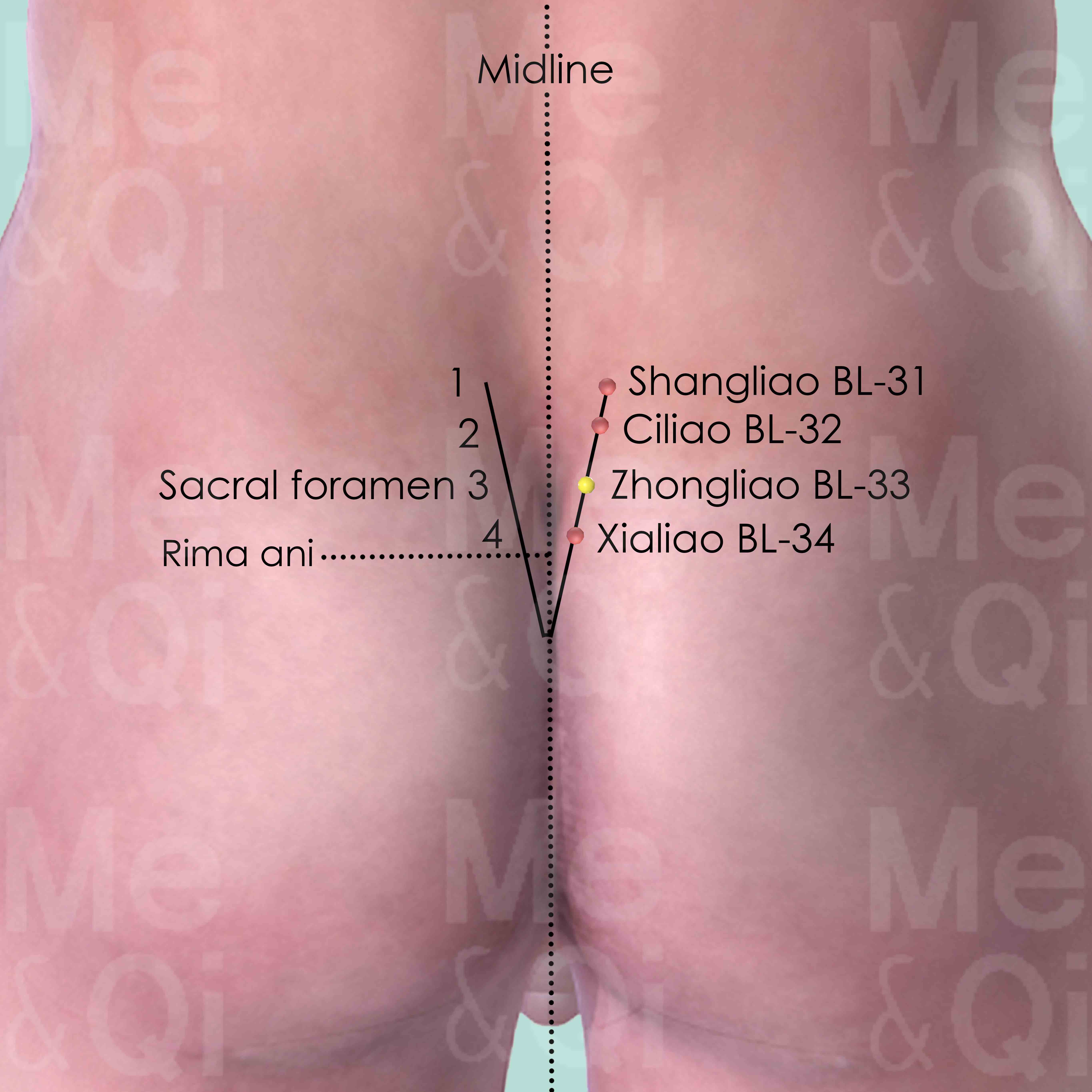
Zhongliao BL-33
In the 3rd posterior sacral foramen, between the posterior superior iliac spine and the midline.
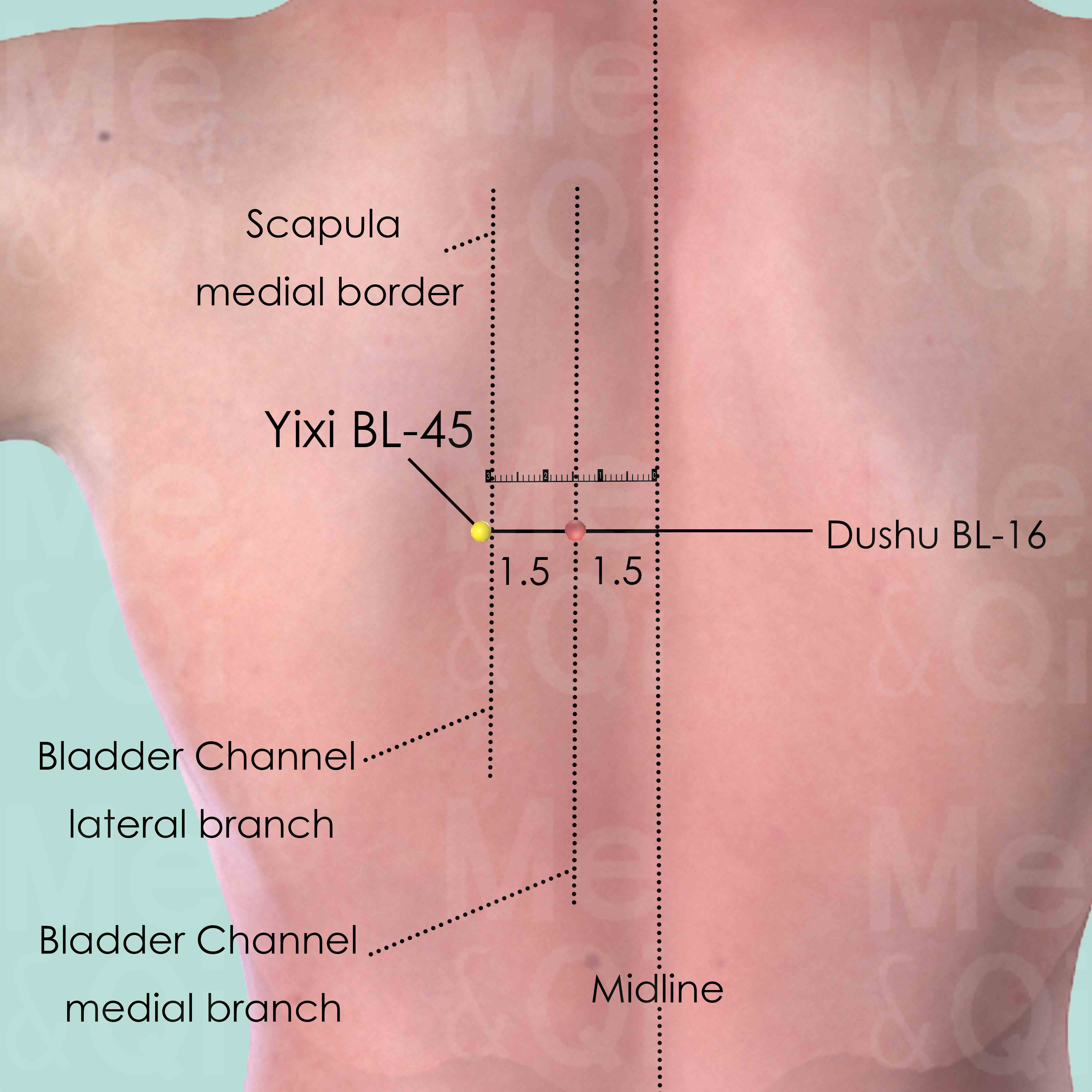
Yixi BL-45
3 cun (about 4 finger-breadths) lateral to the lower border of the spinous process of the 6th thoracic vertebra (T6).
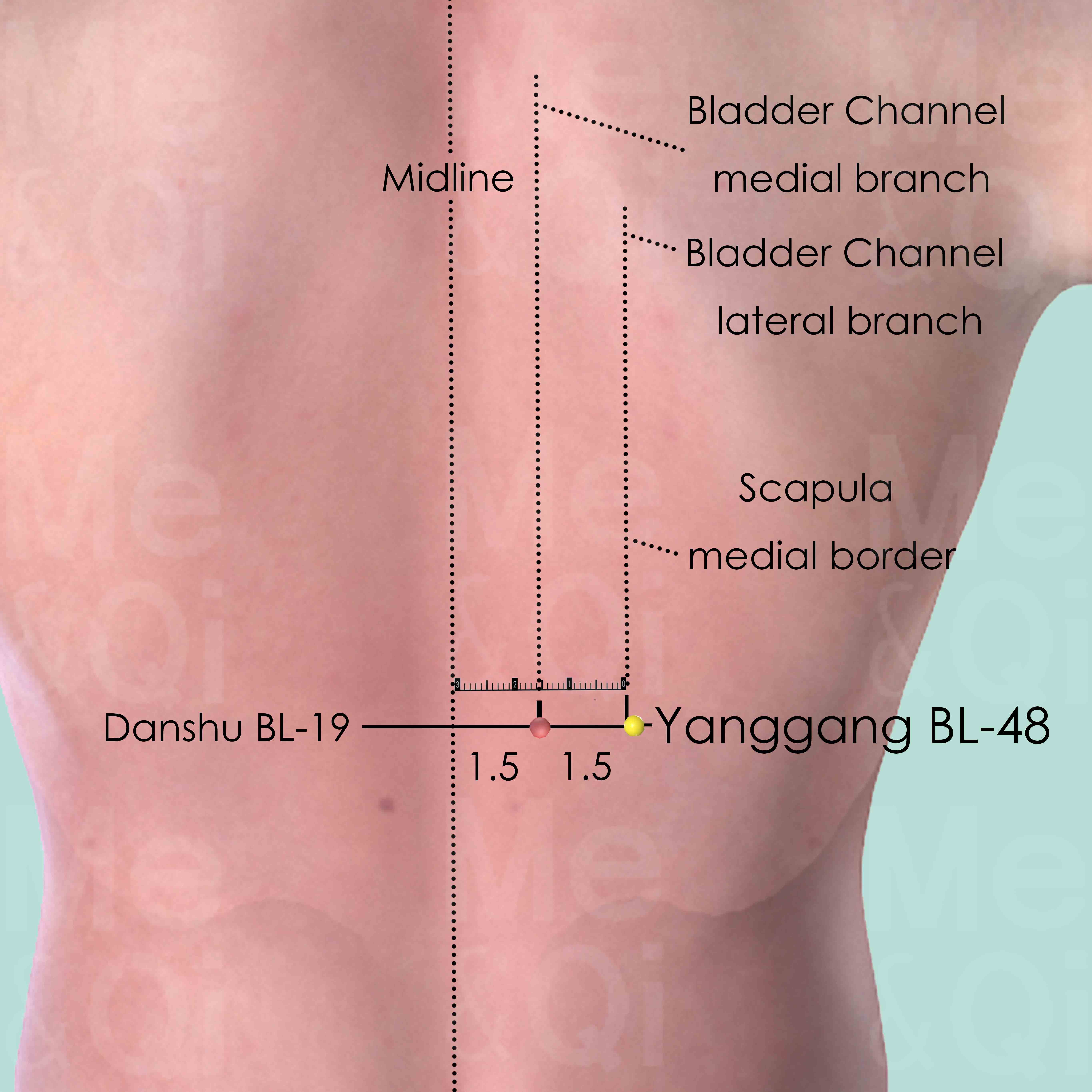
Yanggang BL-48
3 cun lateral to the lower border of the spinous process of the 10th thoracic vertebra (T10).
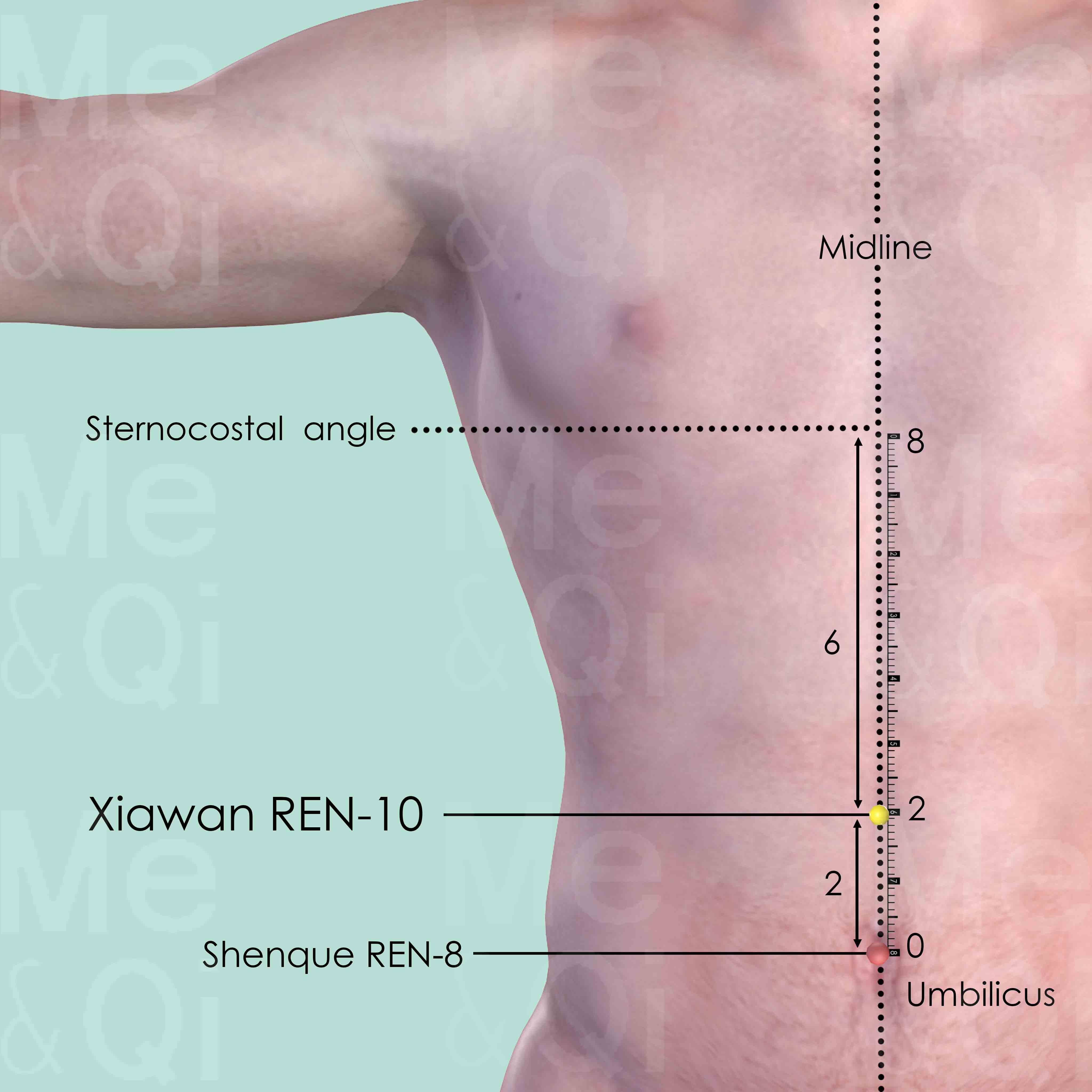
Xiawan REN-10
On the midline of the abdomen, 2 cun above the umbilicus and 6 cun below the sternocostal angle.
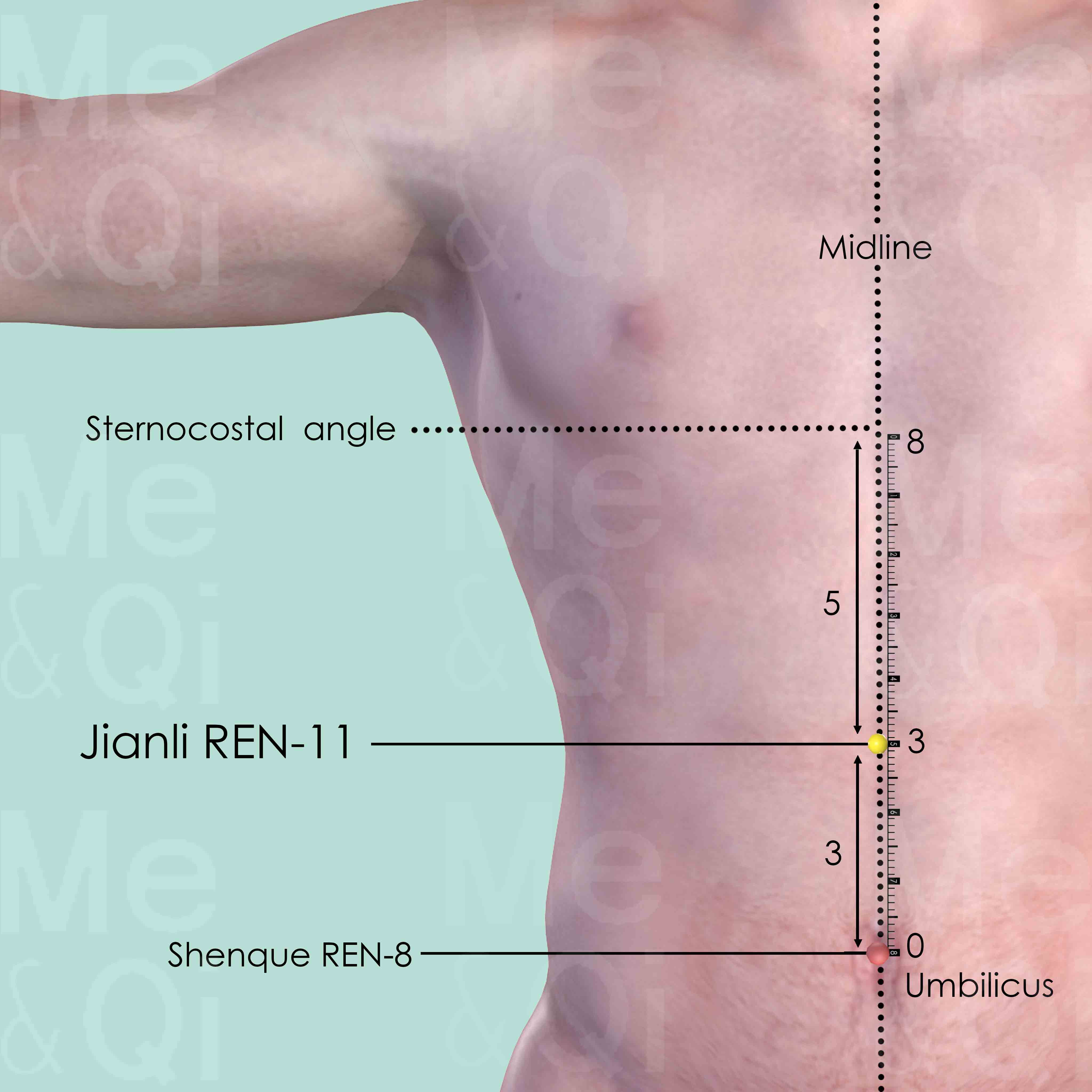
Jianli REN-11
On the midline of the abdomen, 3 cun above the umbilicus and 5 cun below the sternocostal angle.
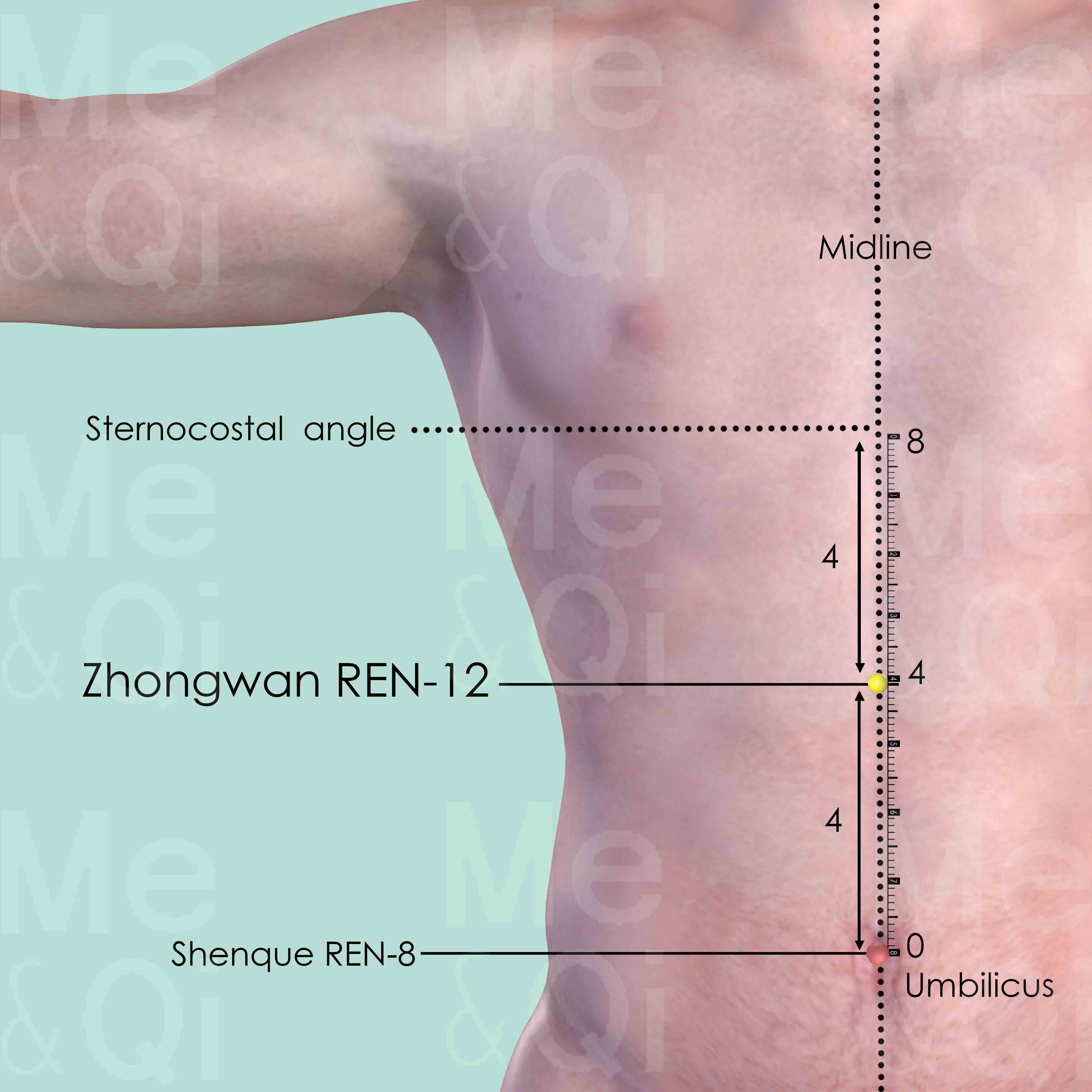
Zhongwan REN-12
On the midline of the abdomen, 4 cun above the umbilicus and 4 cun below the sternocostal angle.
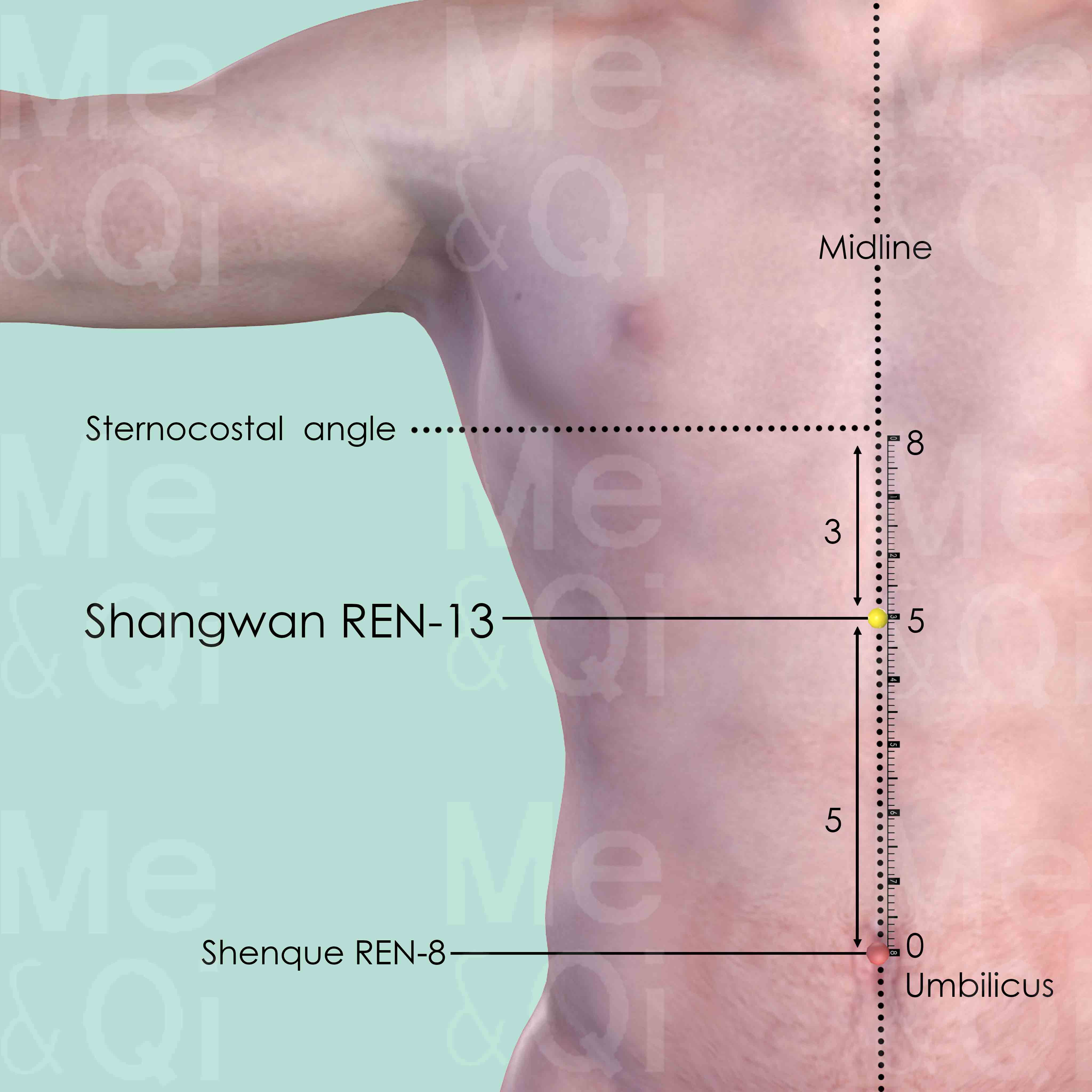
Shangwan REN-13
On the midline of the abdomen, 5 cun above the umbilicus and 3 cun below the sternocostal angle.
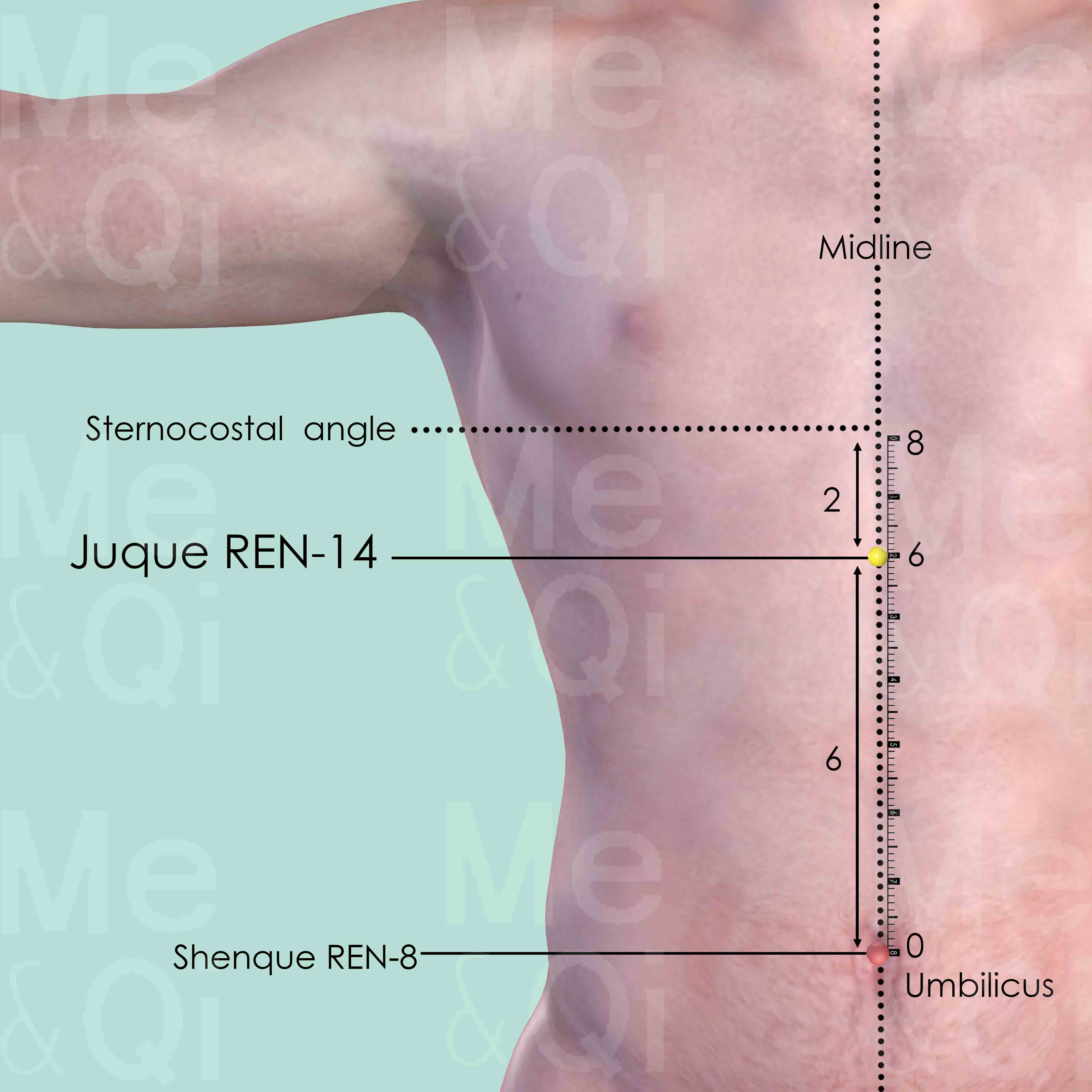
Juque REN-14
On the midline of the abdomen, 6 cun above the umbilicus and 2 cun below the sternocostal angle.
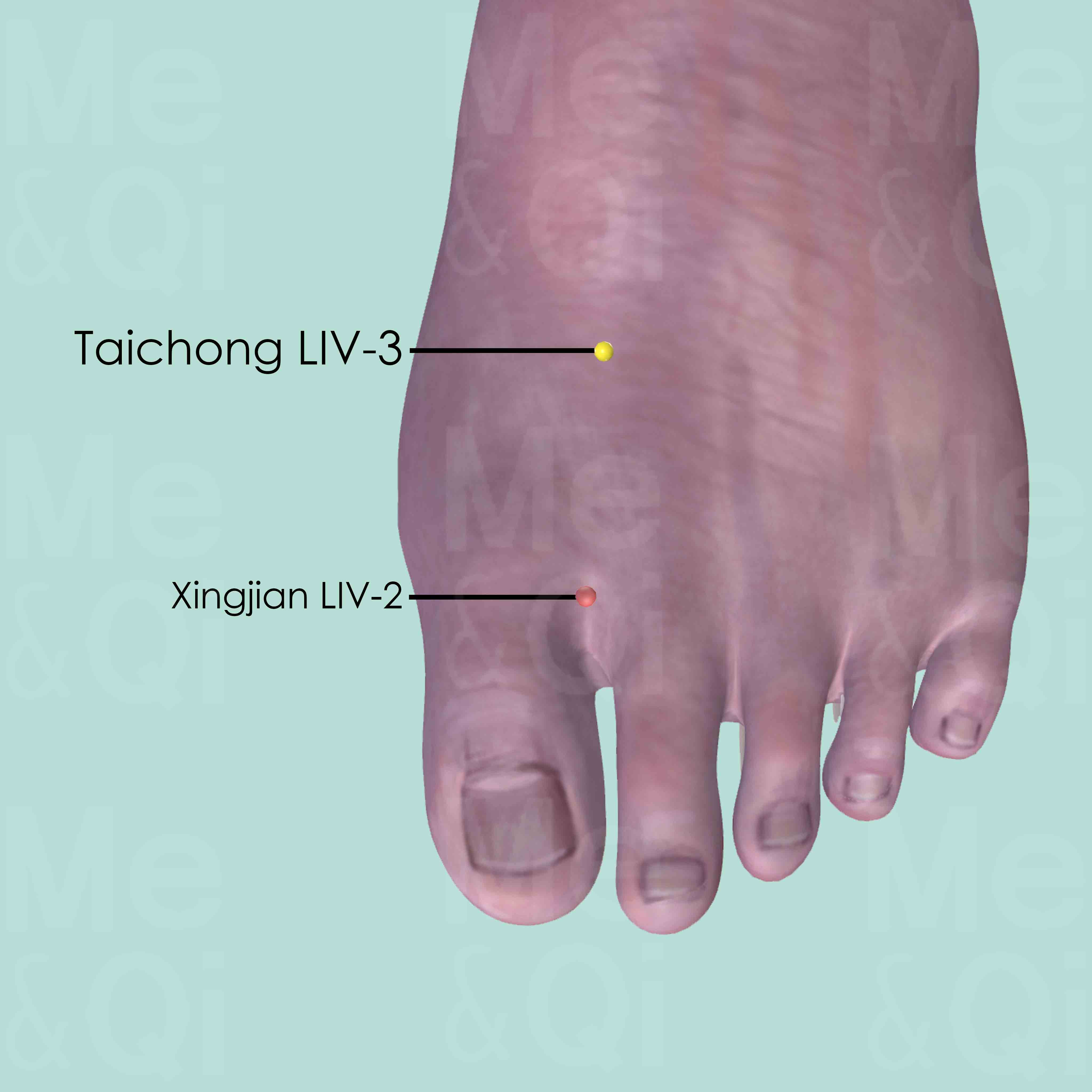
Taichong LIV-3
On the dorsum of the foot, between the 1st and 2nd metatarsal bones, in the depression proximal to the metatarsophalangeal joints and the proximal angle between the two bones.
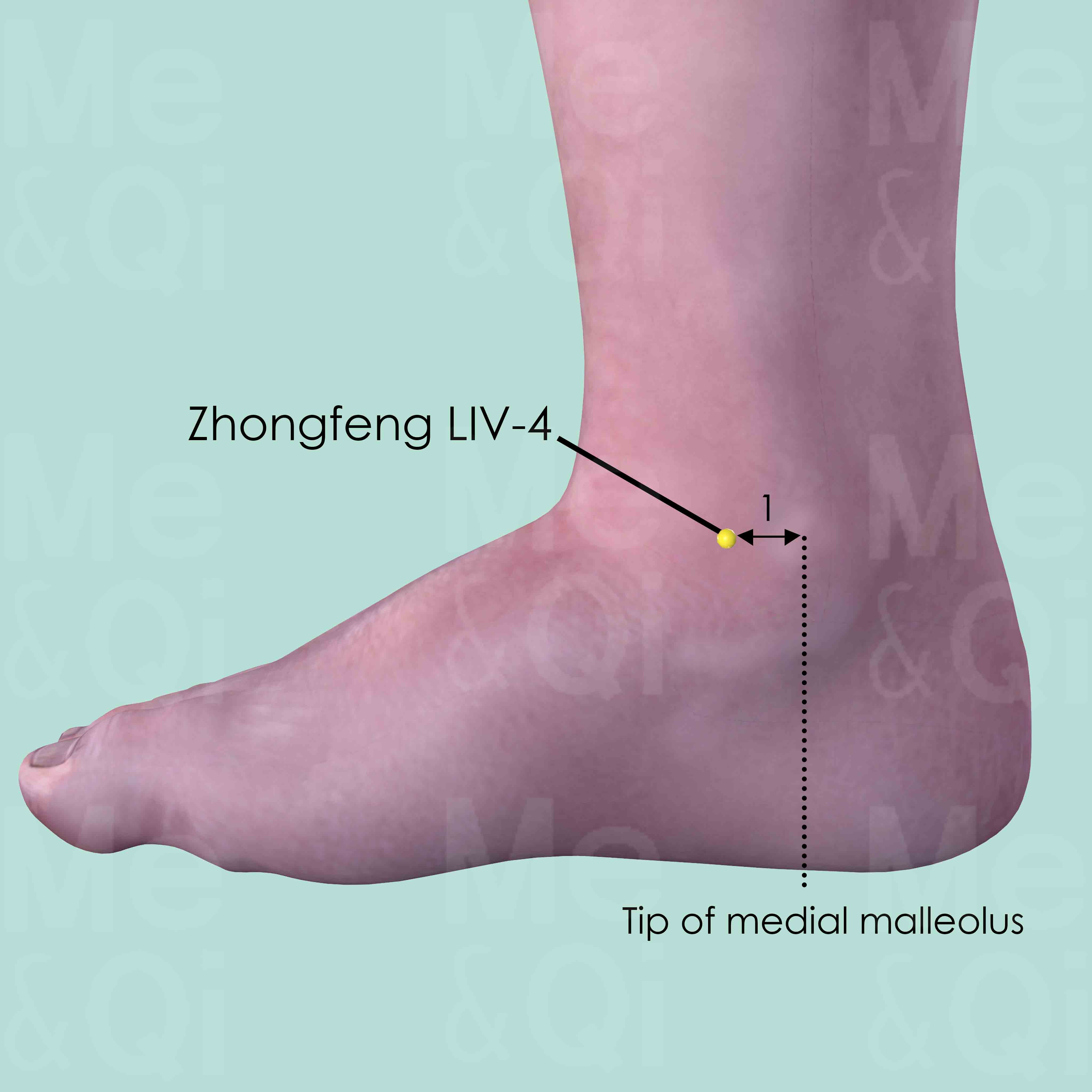
Zhongfeng LIV-4
1 cun anterior to the tip of medial malleolus, in the depression on the medial side of the tendon of the tibialis anterior.
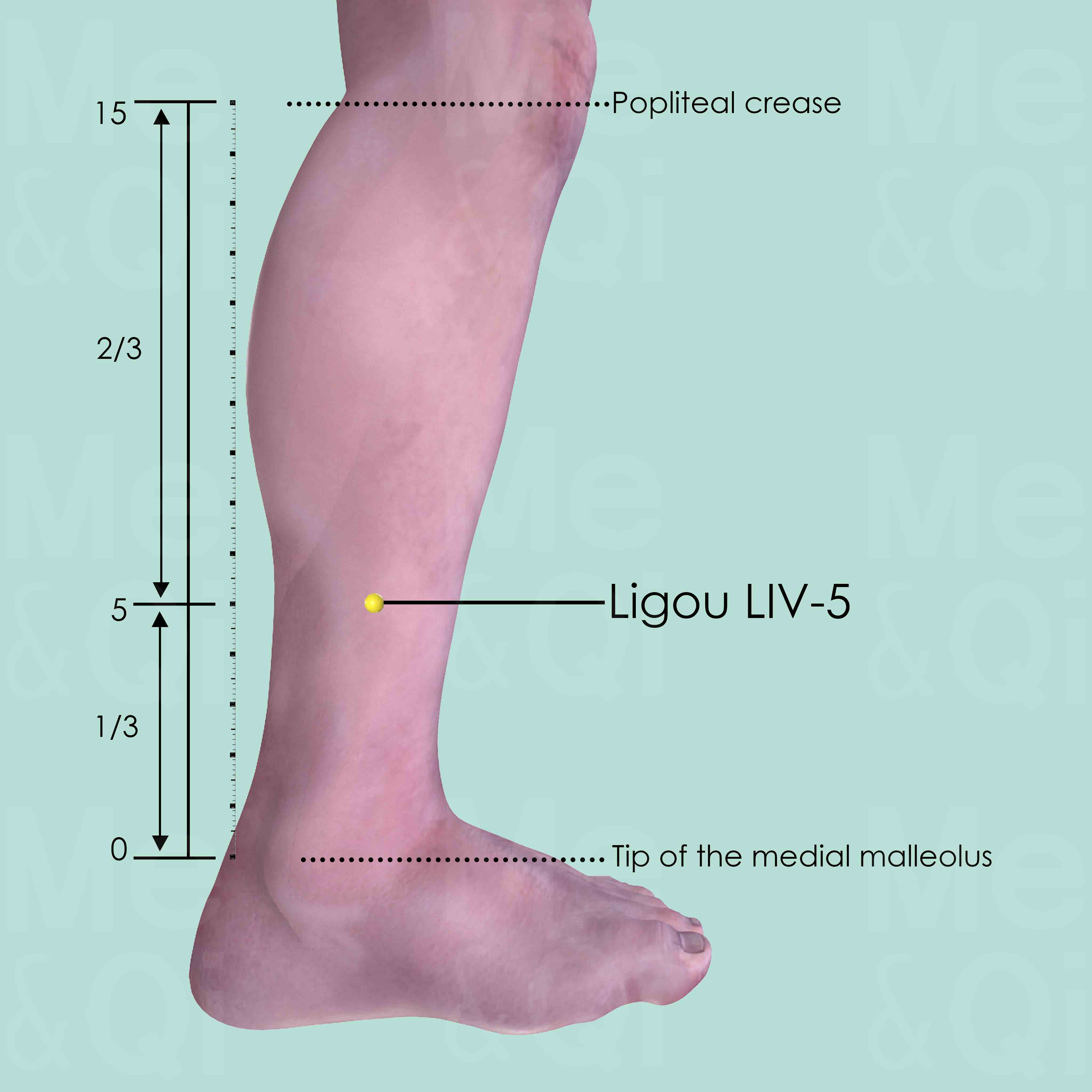
Ligou LIV-5
5 cun above the tip of the medial malleolus, on the medial aspect and posterior to the medial crest of the tibia.
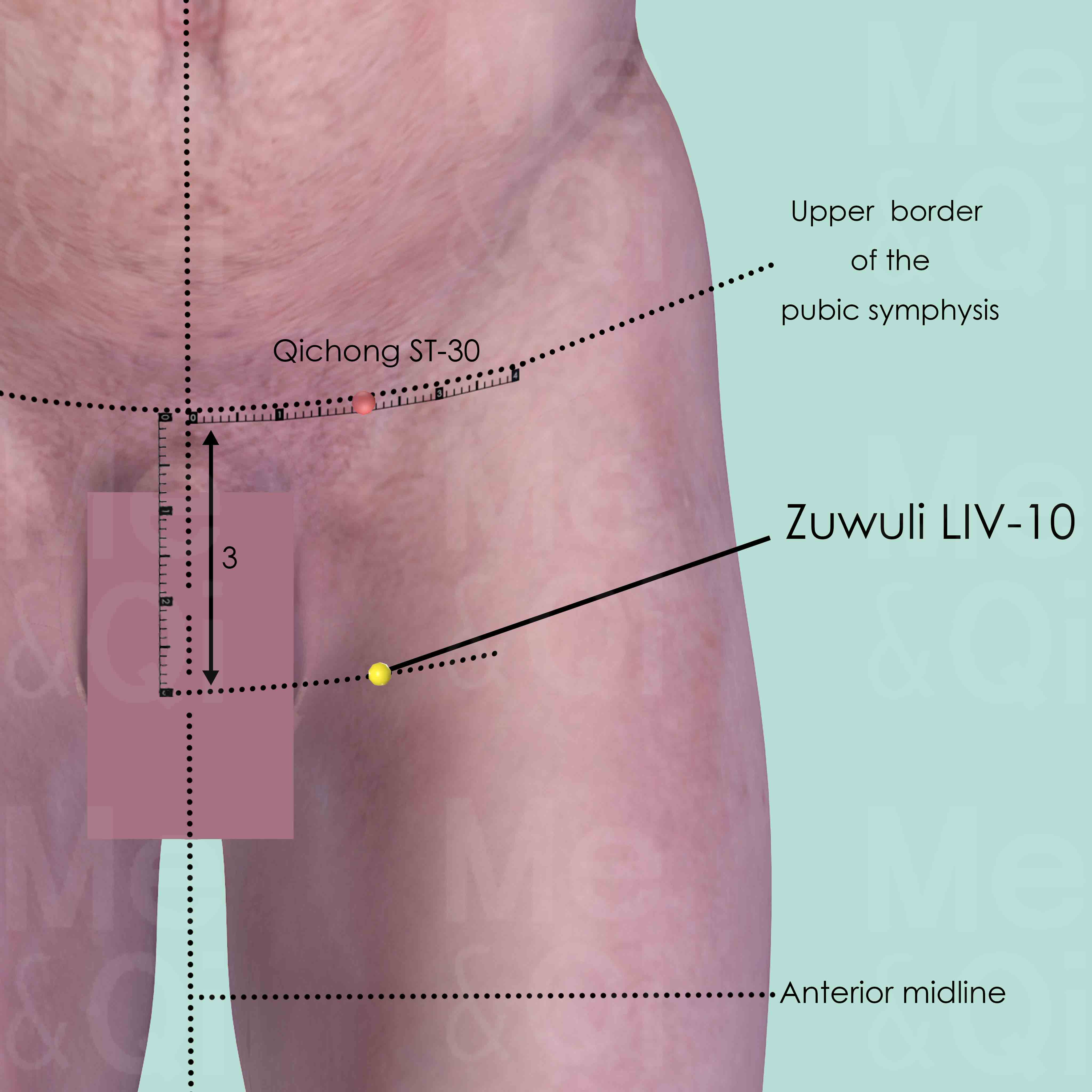
Zuwuli LIV-10
3 cun inferior to Qichong ST-30 which is on the upper border of the symphysis and 2 cun lateral to the anterior midline. The point is also on the lateral border of adductor longus muscle.
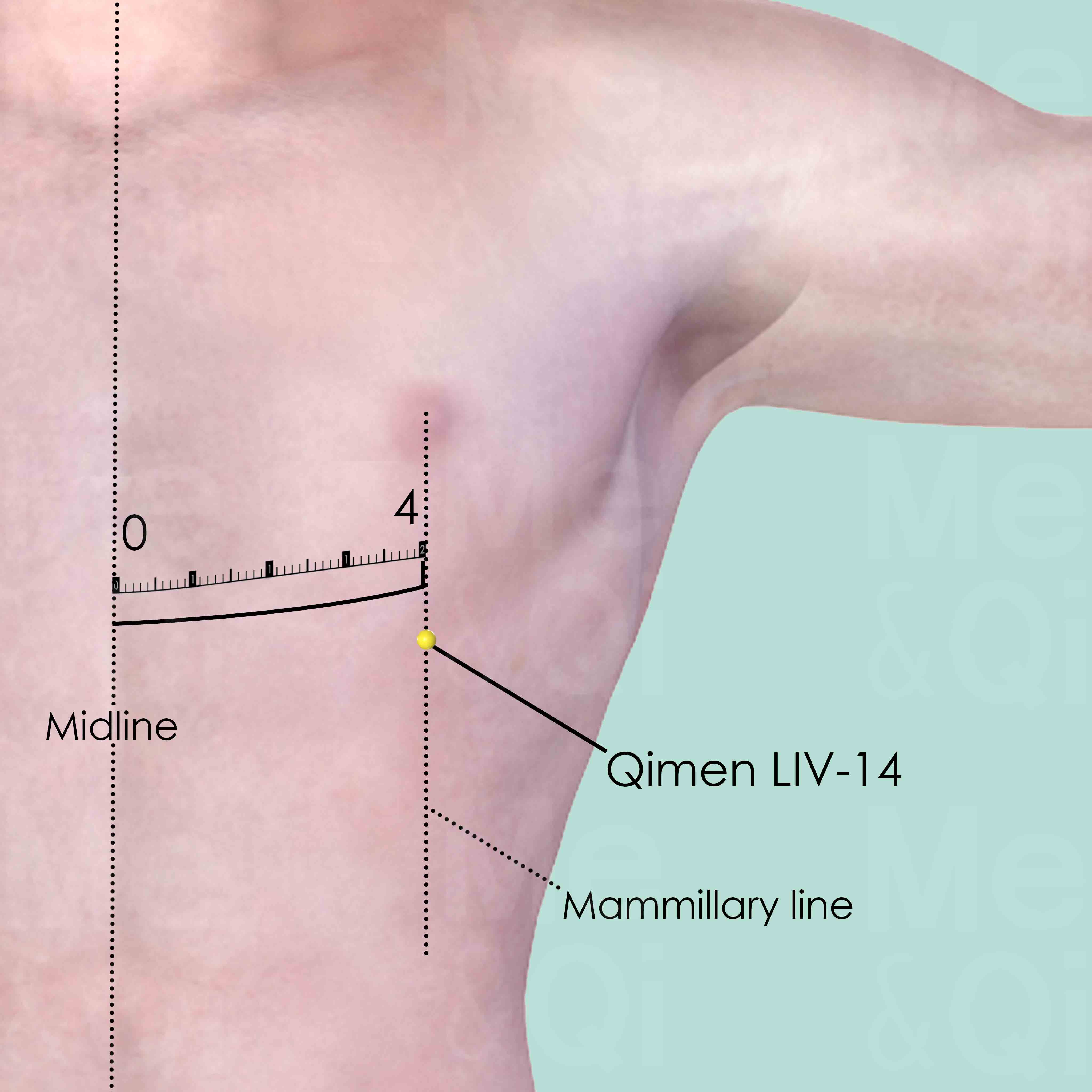
Qimen LIV-14
On the mammillary line, two ribs below the nipple, in the 6th intercostal space, 4 cun lateral to the midline. Please note that there is an alternative location for LIV-14 at the lower edge of the ribcage in line with the nipple or, in women, 4 cun from the midline. In fact, one could look upon these as two separate points. The one in the intercostal space is used more for Channel problems. While the one at the lower edge of the ribcage is used more for Organ problems.
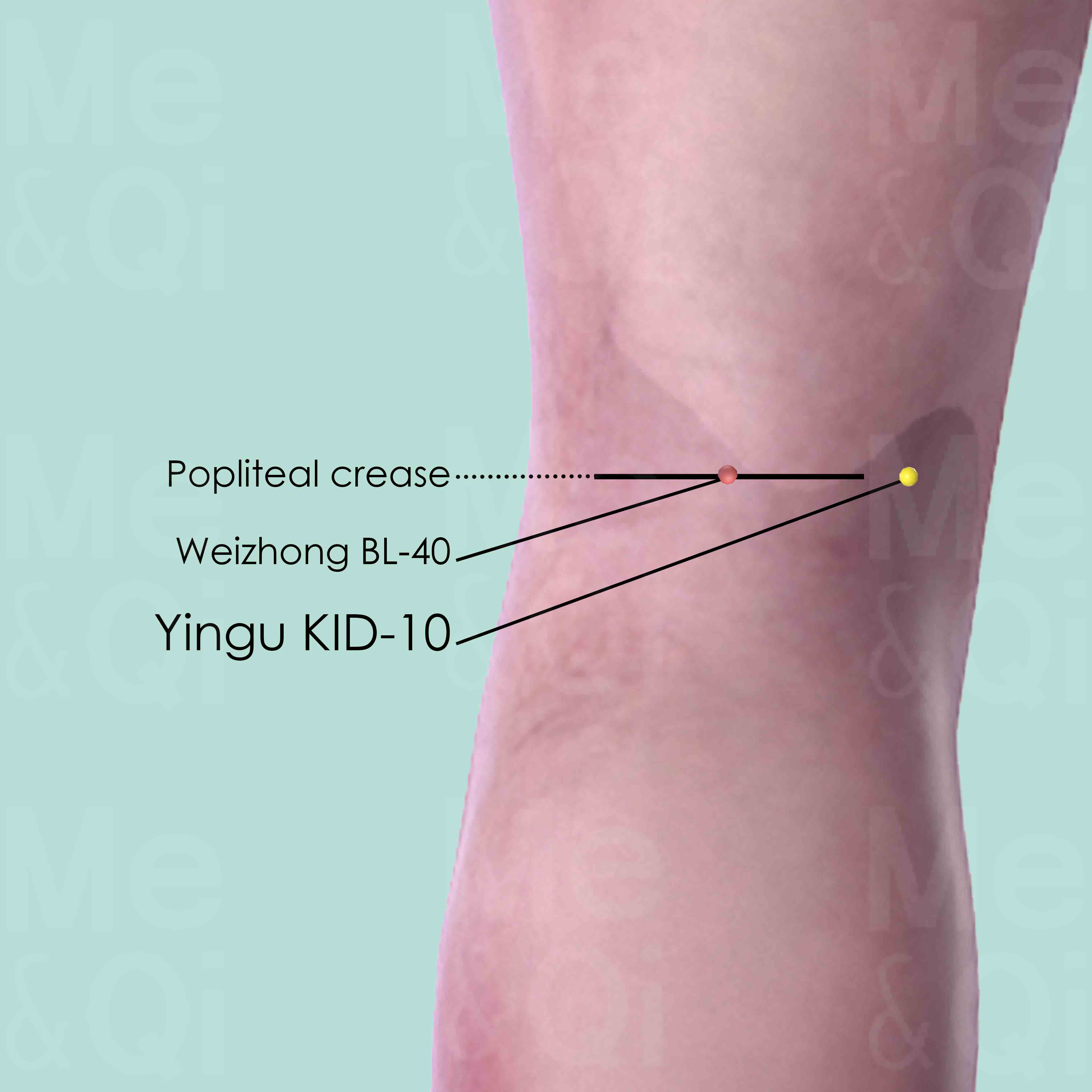
Yingu KID-10
On the medial side of the popliteal fossa, level with Weizhong BL-40, between the tendons of semitendinosus and semimenbranosus muscle when the knee is flexed.
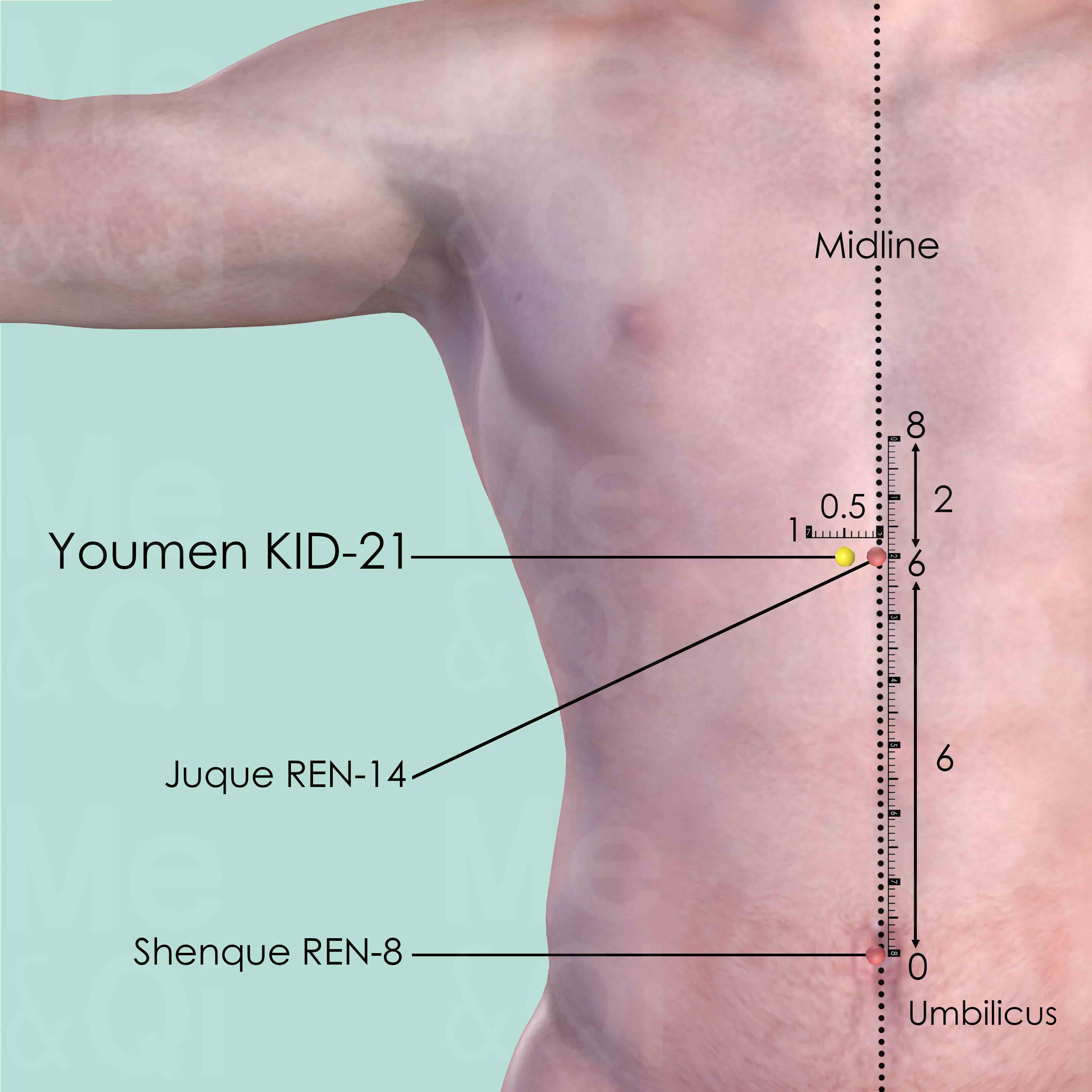
Youmen KID-21
6 cun above the umbilicus and 2 cun below the sternocostal angle, 0.5 cun lateral to the anterior midline.
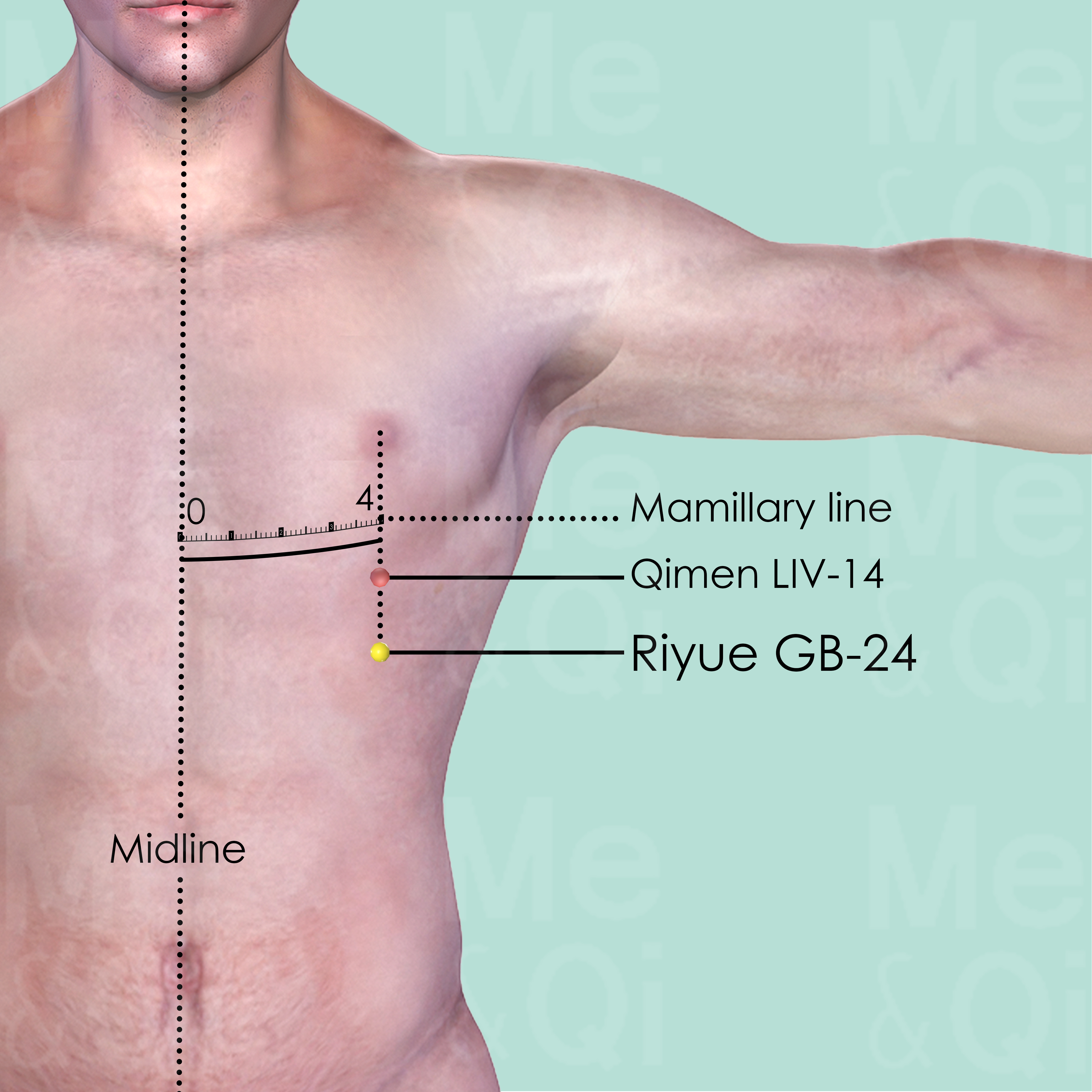
Riyue GB-24
On the mamillary line which is 4 cun lateral to the anterior midline, in the 7th intercostal space, 1 intercostal space below Qimen LIV-14.
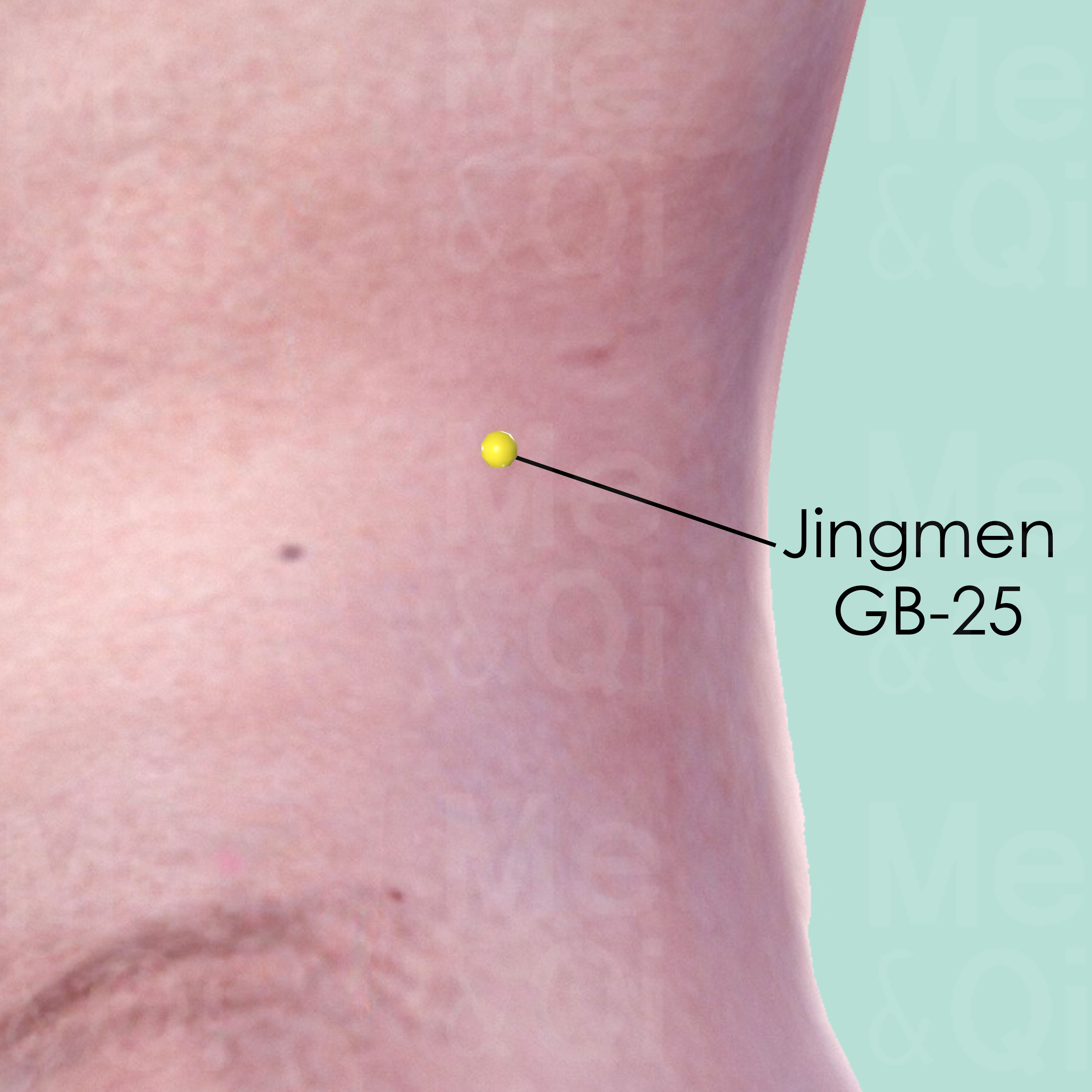
Jingmen GB-25
On the lateral side of the abdomen, on the lower border of the free end of the 12th rib.
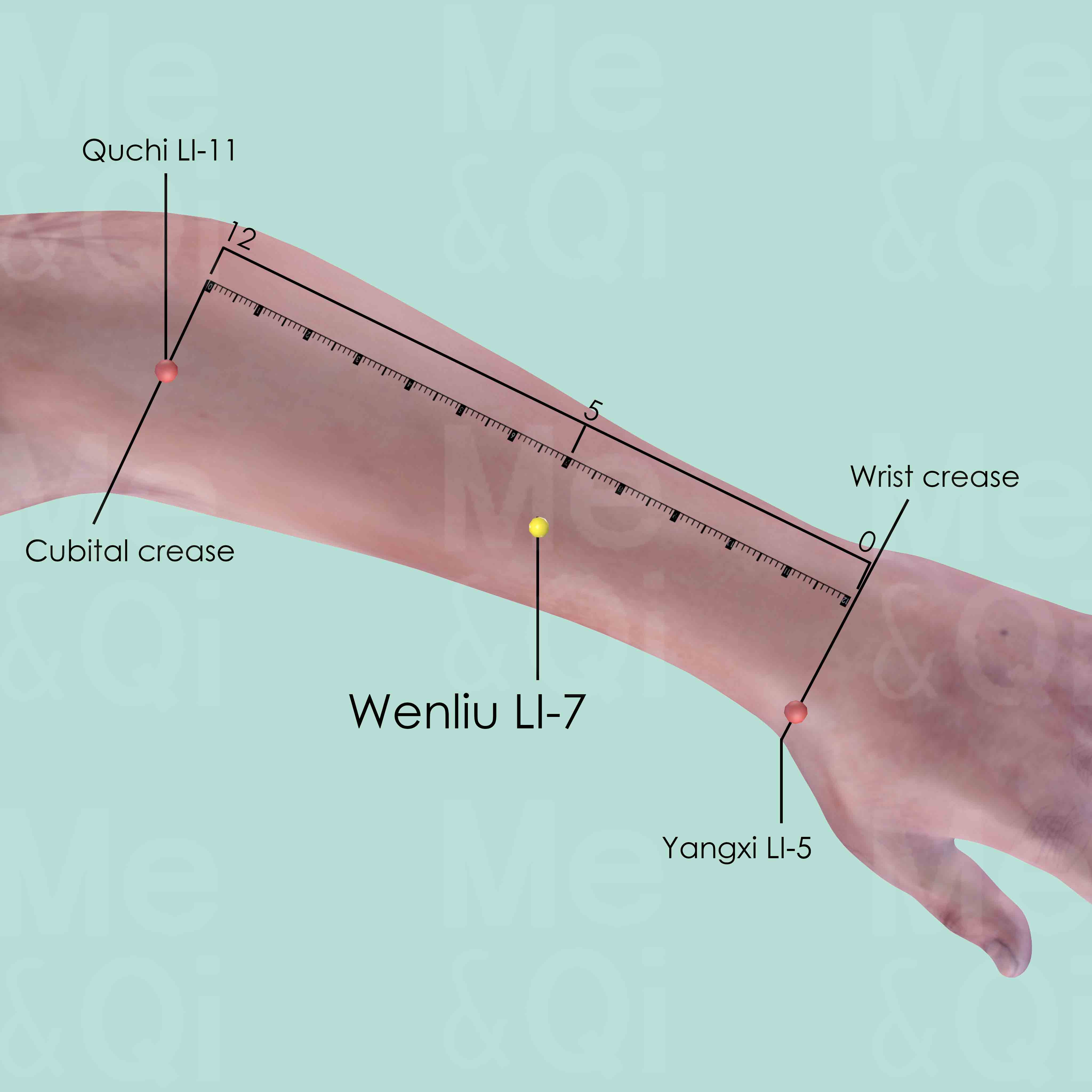
Wenliu LI-7
When a fist is made, with the ulnar side downward and elbow flexed, the point is 5 cun above Yangxi LI-5 at the wrist crease, 1 cun distal to the midpoint of the line joining Yangxi LI-5 and Quchi LI-11.
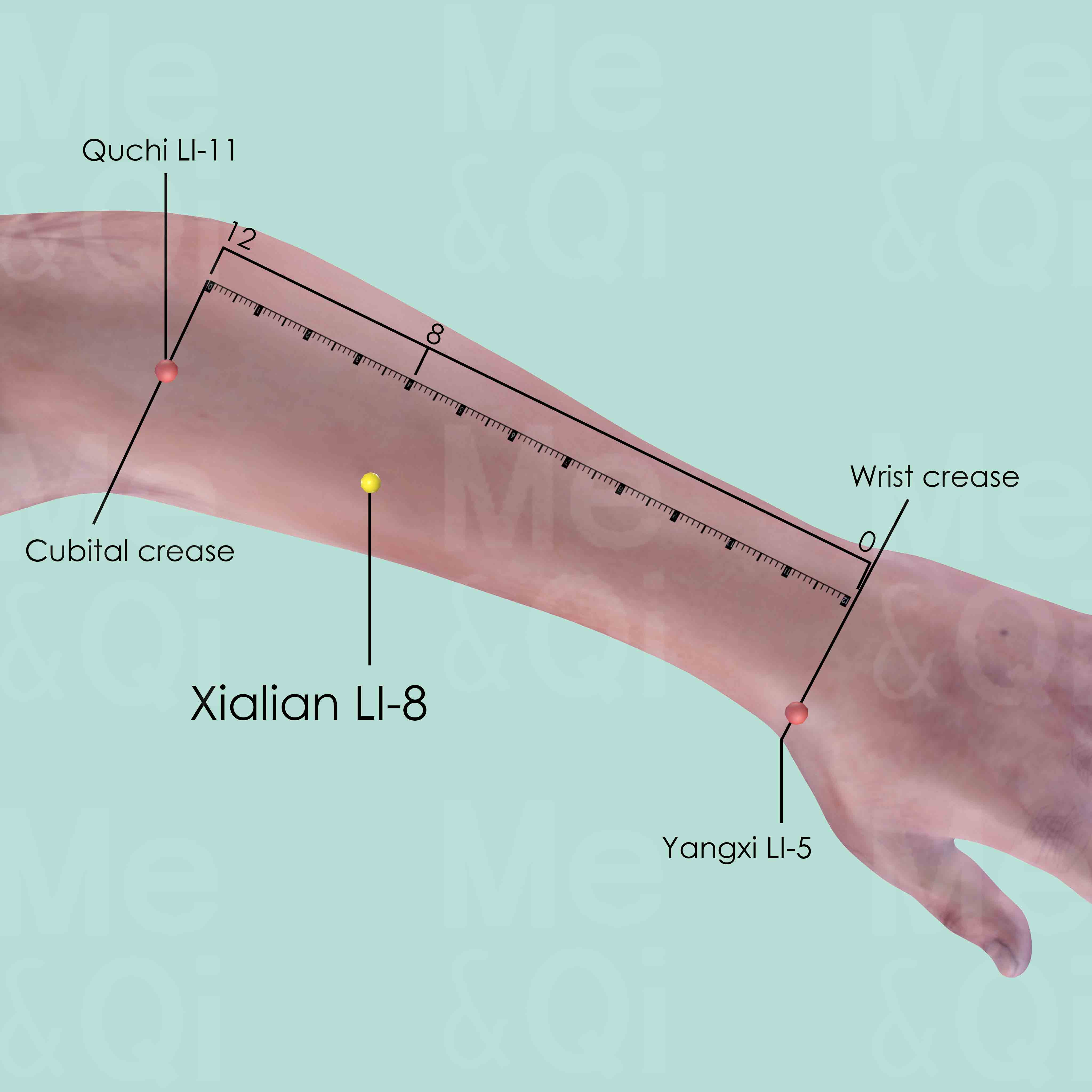
Xialian LI-8
When a fist is made, with the ulnar side downward and elbow flexed, the point is 4 cun distal to Quchi LI-11 of the line joining Yangxi LI-5 and Quchi LI-11.
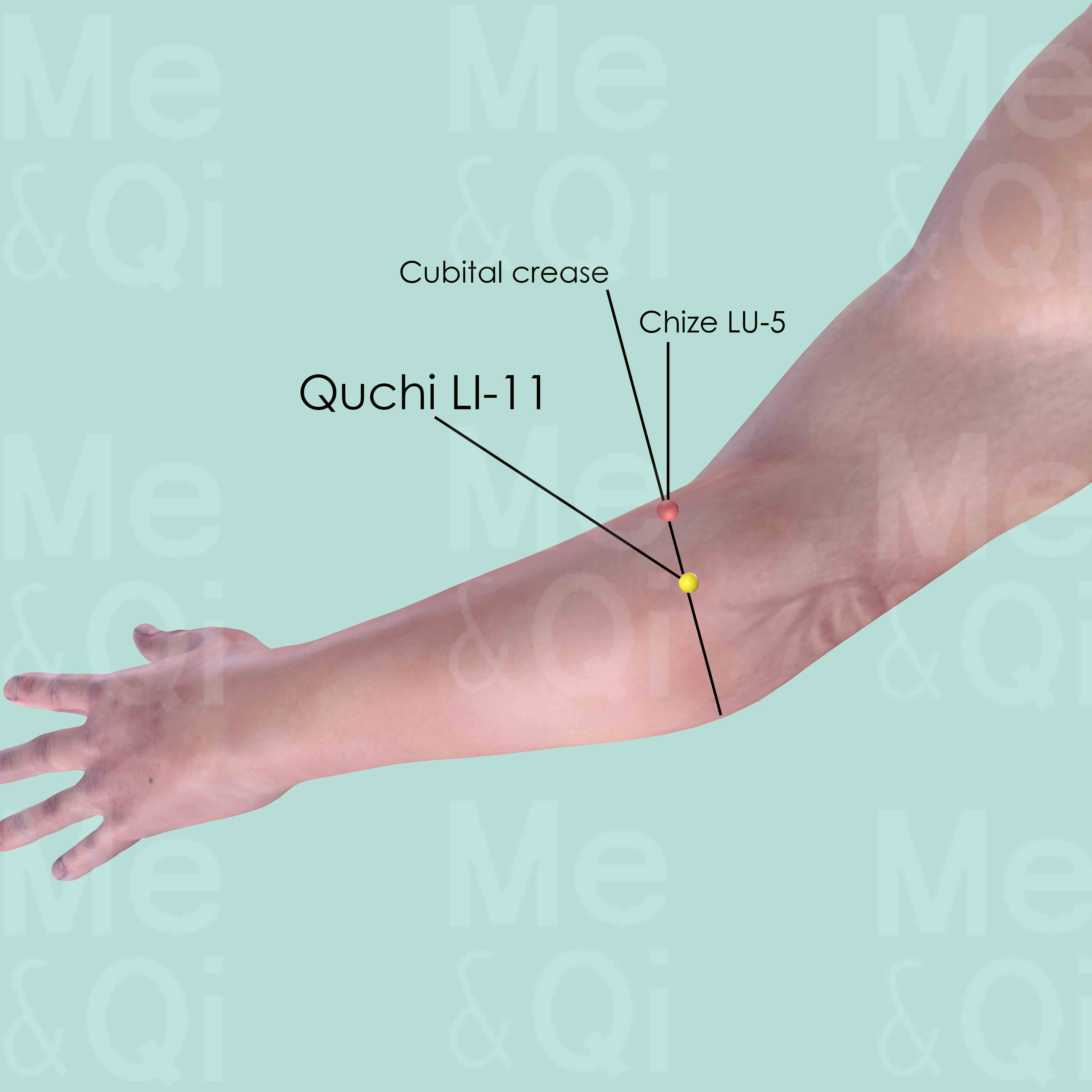
Quchi LI-11
When the elbow is flexed, Quchi LI-11 is in the depression at the lateral end of the cubital crease, midway between Chize LU-5 and the lateral epicondyle of the humerus.
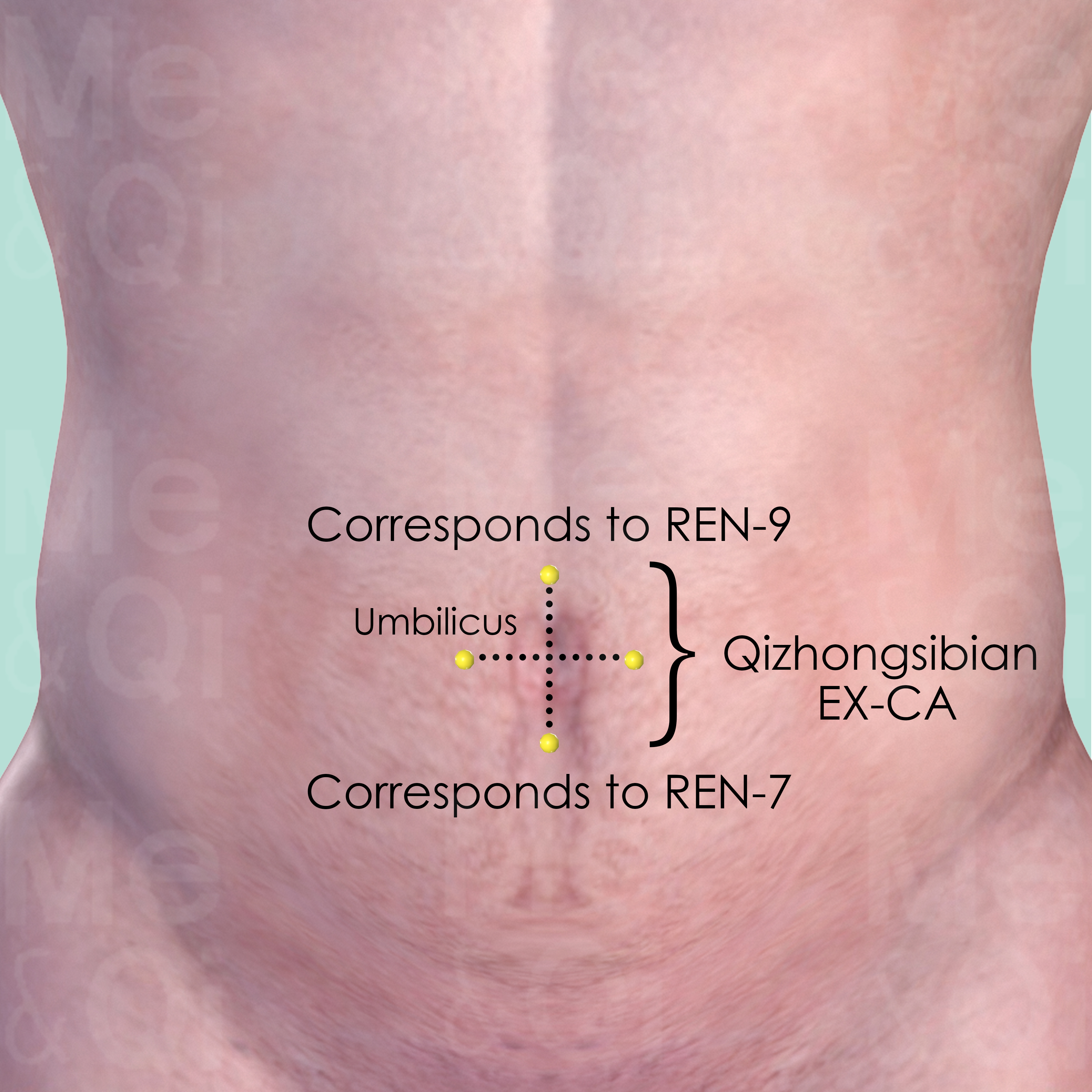
Qizhongsibian EX-CA
This is a group of 4 points, 1 cun lateral, superior and inferior to the center of the umbilicus. The superior point corresponds to Shuifen REN-9, while the inferior one corresponds to Yinjiao REN-7.
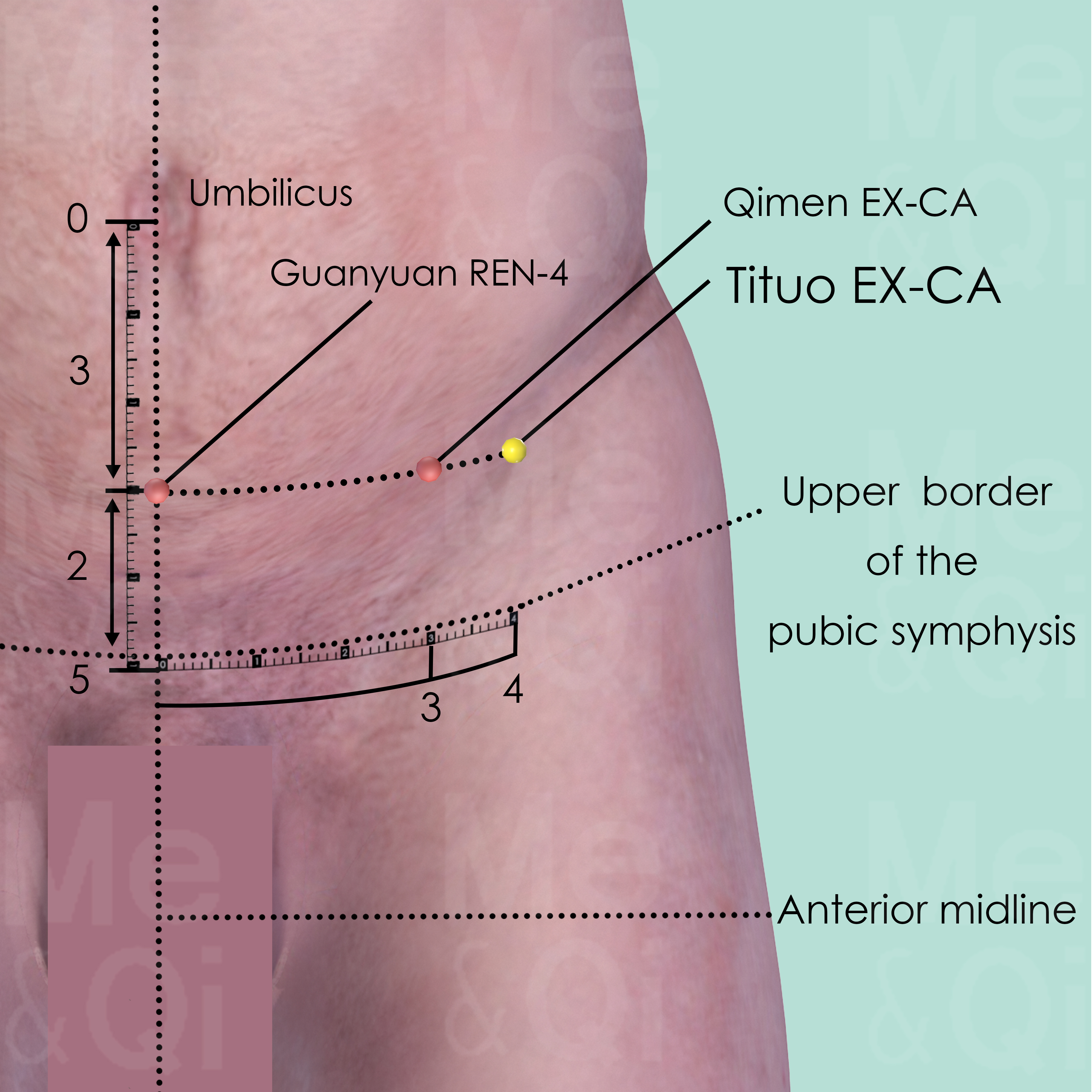
Tituo EX-CA
4 cun lateral to the anterior midline and 2 cun superior to the upper border of the pubic symphysis.
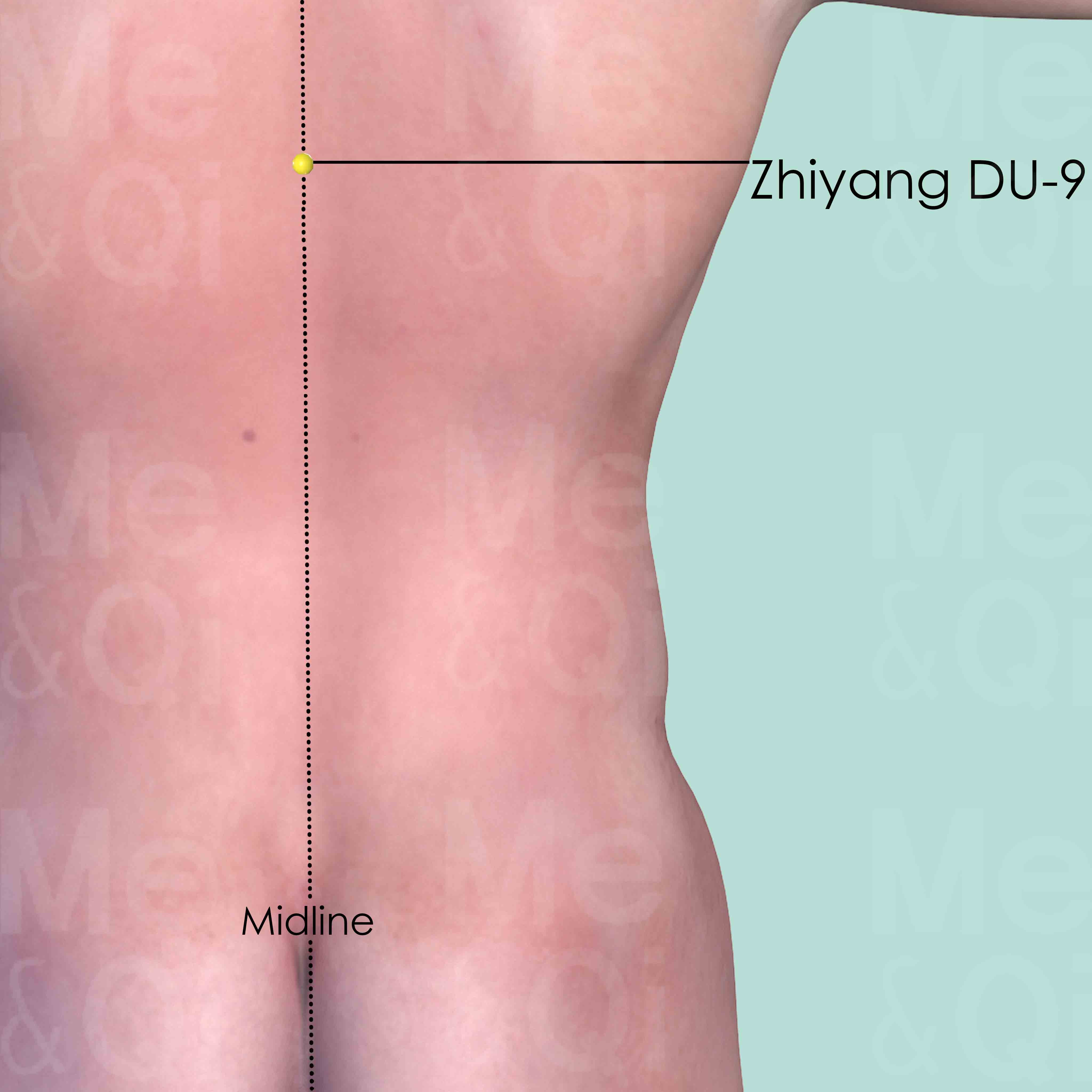
Zhiyang DU-9
On the back midline, in the depression below the spinous process of the 7th thoracic vertebra (T7).
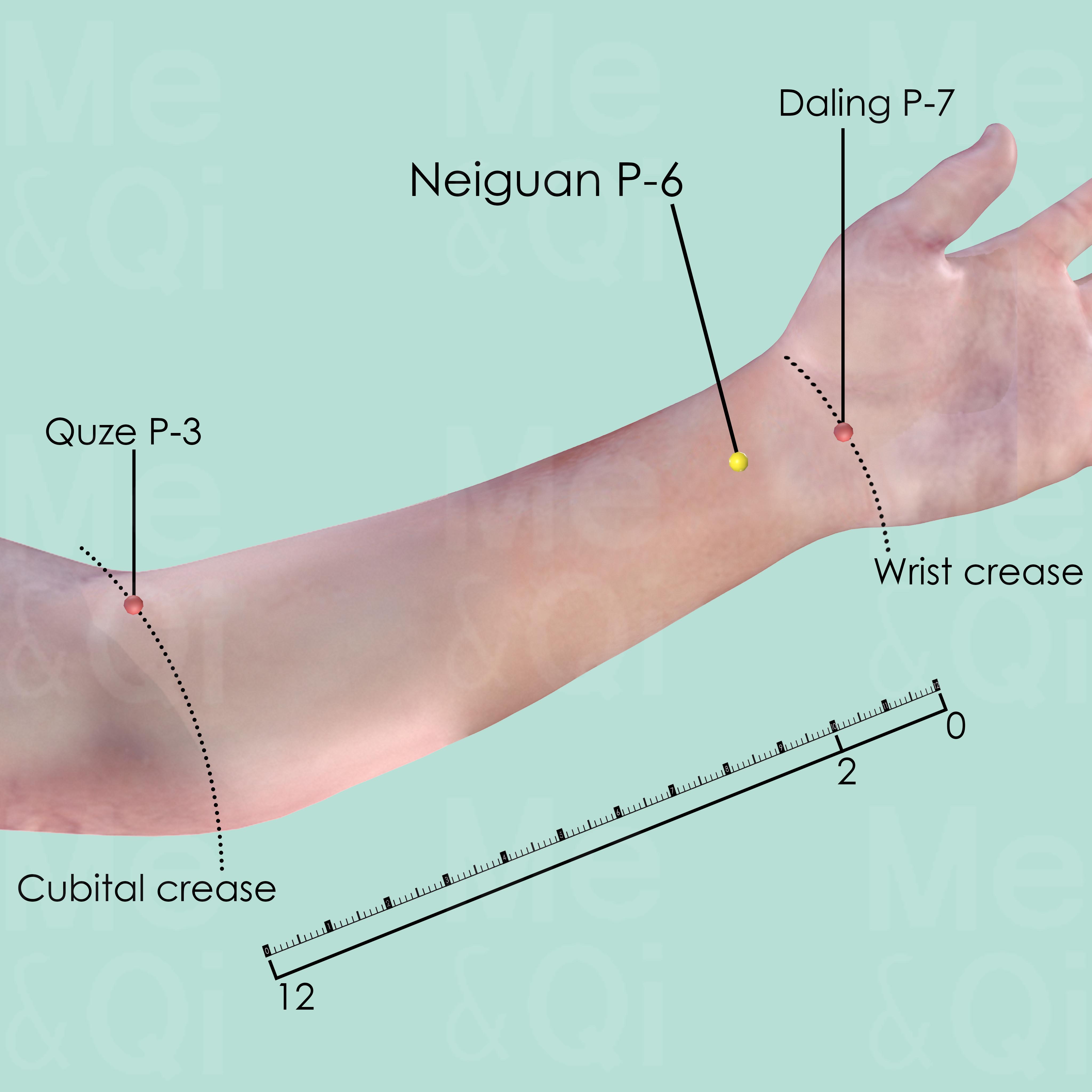
Neiguan P-6
2 cun above Daling P-7 on the transverse crease of the wrist, between the tendons of palmaris longus and flexor carpi radialis muscle.

